Broadcom BRCM1005-H 802.11g MINI PCI Card build in Laptops User Manual Getting Started Guide TOPAS R
Broadcom Corporation 802.11g MINI PCI Card build in Laptops Getting Started Guide TOPAS R
Broadcom >
Contents
User Guide Main PP2160
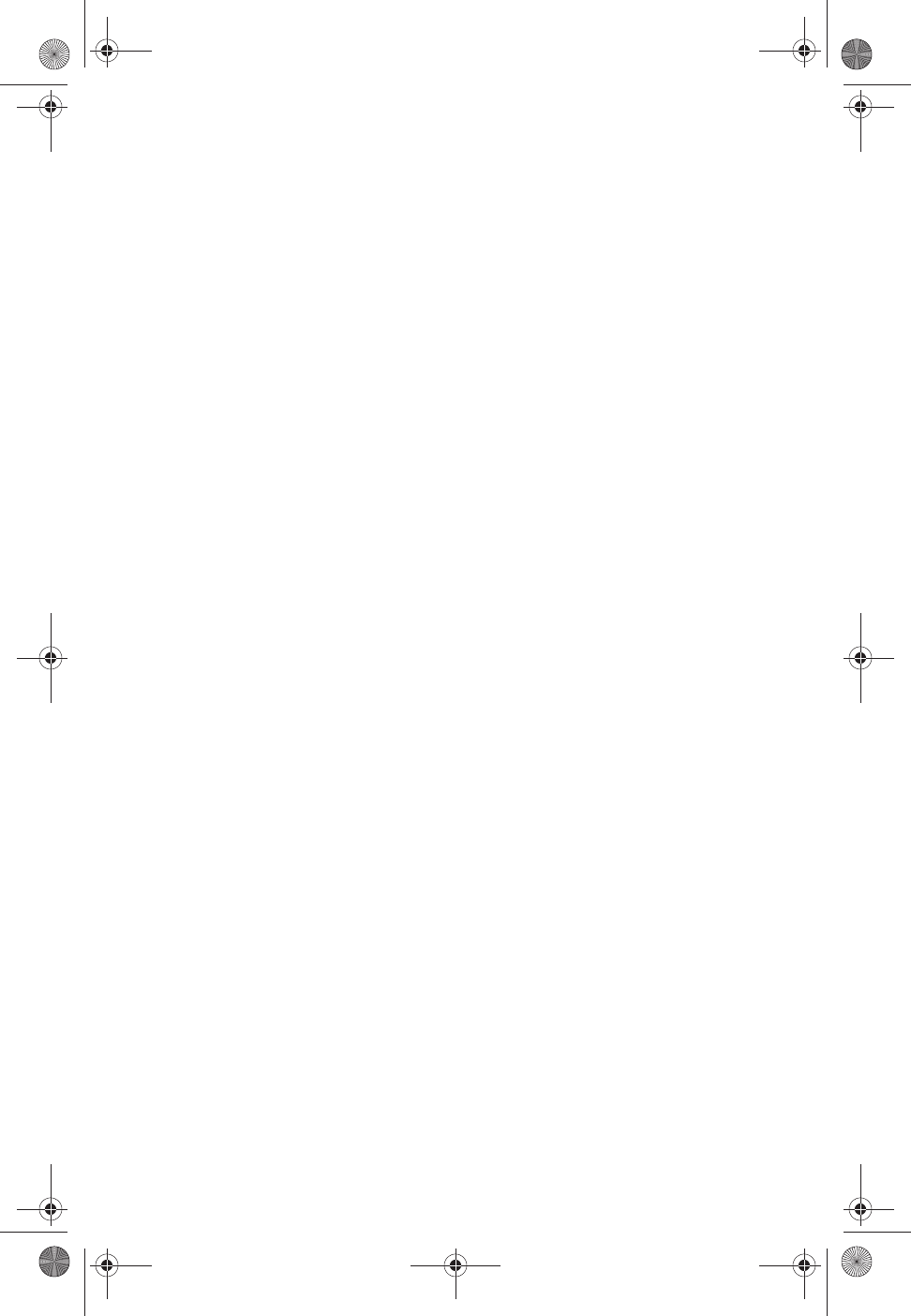
b
Getting Started
Compaq Notebook Series
Document Part Number: 307502-003
March 2003
This guide explains how to set up your hardware and software,
begin using the notebook, identify hardware components, and
contact Compaq if you need assistance.
307502-003.book Page i Tuesday, February 4, 2003 10:44 AM

© 2003 Hewlett-Packard Development Company, L.P.
Microsoft and Windows are trademarks of Microsoft Corporation in the U.S.
and/or other countries. All other product names mentioned herein may be
trademarks of their respective companies.
HP shall not be liable for technical or editorial errors or omissions contained
herein or for incidental or consequential damages in connection with the
furnishing, performance, or use of this material. The information in this
document is provided "as is" without warranty of any kind, and is subject to
change without notice. The warranties for HP products are set forth in the
express limited warranty statements accompanying such products. Nothing
herein should be construed as constituting an additional warranty.
Getting Started
Third Edition March 2003
First Edition October 2002
Document Part Number: 307502-003
307502-003.book Page ii Tuesday, February 4, 2003 10:44 AM
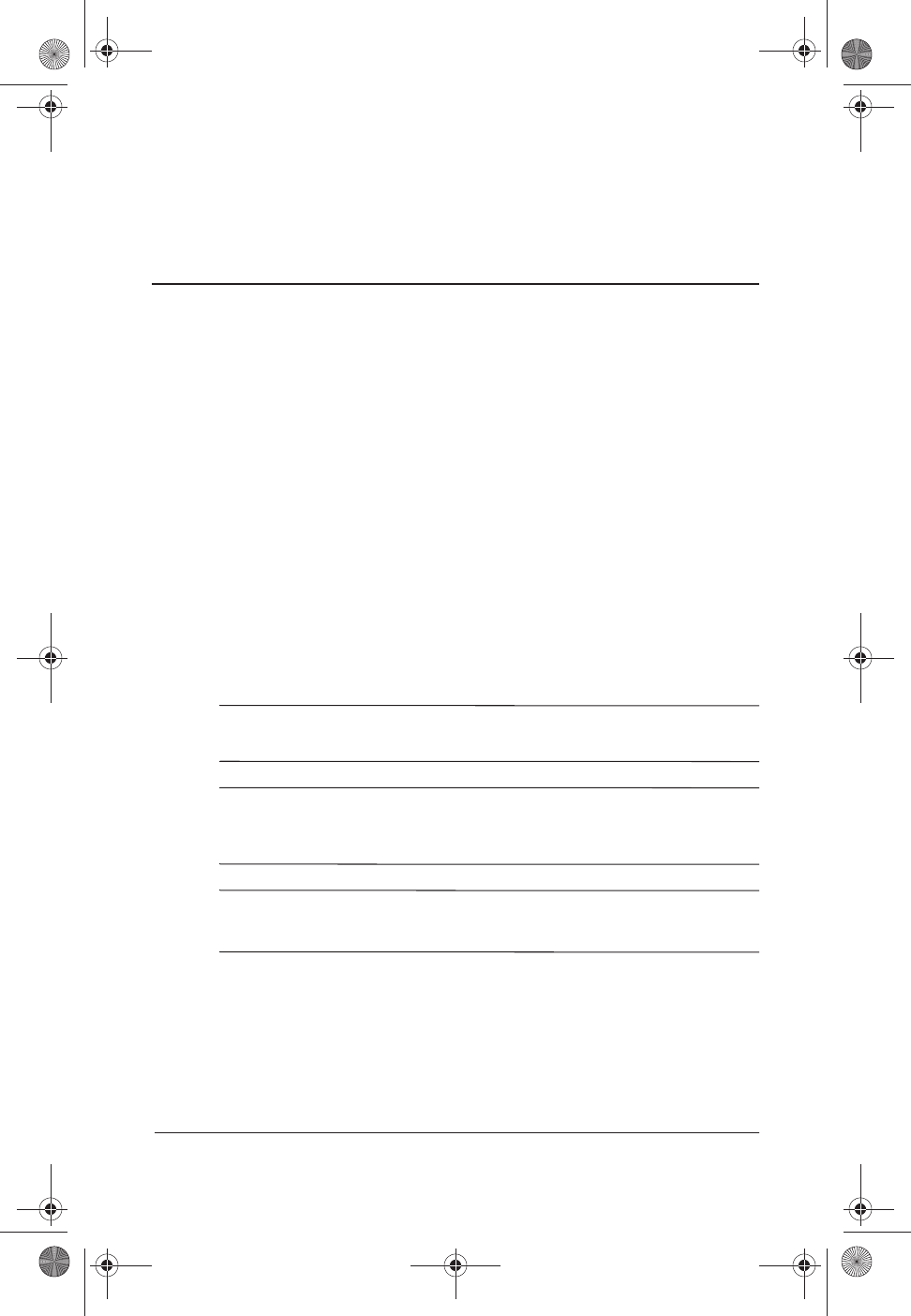
Getting Started iii
Using This Guide
This preface explains how to interpret the symbols, text styles,
and paths in your notebook documentation.
Warnings, Cautions and Notes
Warnings and cautions contain important information that can
protect you, your work, and your system.
Notes contain additional information about a topic. Some notes
provide basic information for inexperienced users. Others provide
technical information for advanced users.
The following icons identify warnings, cautions, and notes.
ÅWARNING: The information in a warning alerts you to potential
bodily harm or loss of life.
ÄCAUTION: The information in a caution alerts you to potential
damage to your work, your notebook, or an optional
external device.
✎The information in a note provides supplementary information
for inexperienced or advanced users.
307502-003.book Page iii Tuesday, February 4, 2003 10:44 AM
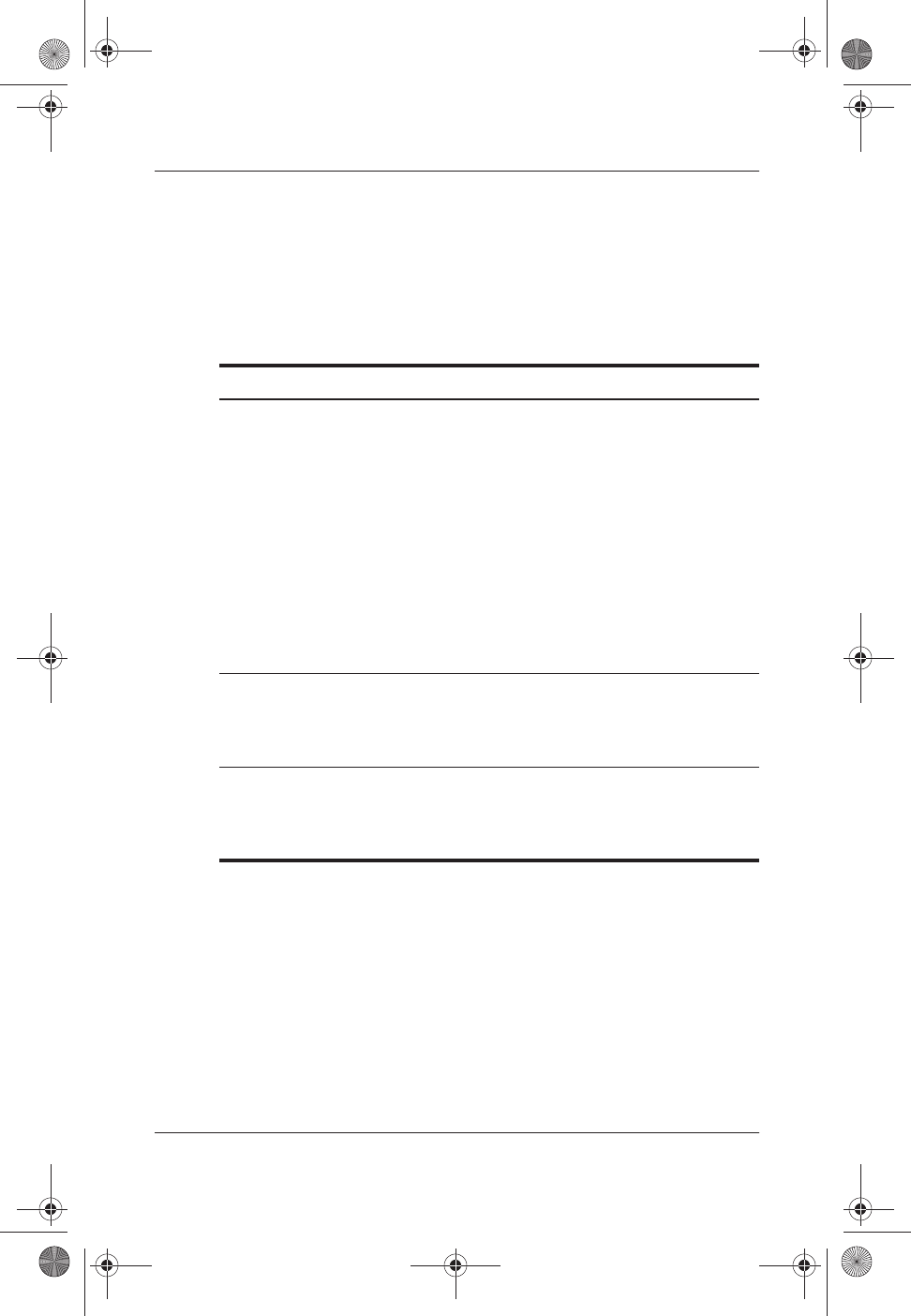
iv Getting Started
Using This Guide
Text Styles
Some text in your notebook documentation is styled
typographically to help you interpret the information it contains.
The following table explains the text styles used in your notebook
documentation.
Style Explanation
keys Identifies a key, such as the enter key, on the
notebook keyboard or on an optional external
keyboard.
A plus sign (+) between 2 or more keys indicates
that they are a key combination. To use most key
combinations:
■Press and hold the first key, press and hold
each succeeding key, then release all the keys
at the same time.
■Unless you are instructed to do so, do not
press the keys in a key combination
simultaneously.
commands Identifies characters you are asked to type. For
example, to visit the Compaq Web site, you are
asked to type http://www.compaq.com into the
address field on your Web browser.
Initial Capital
Letters
Identify labels or options you can choose on the
screen. For example, in a procedure for displaying
an icon on the taskbar, you might be asked to select
the Always Show Icon On The Taskbar check box.
307502-003.book Page iv Tuesday, February 4, 2003 10:44 AM
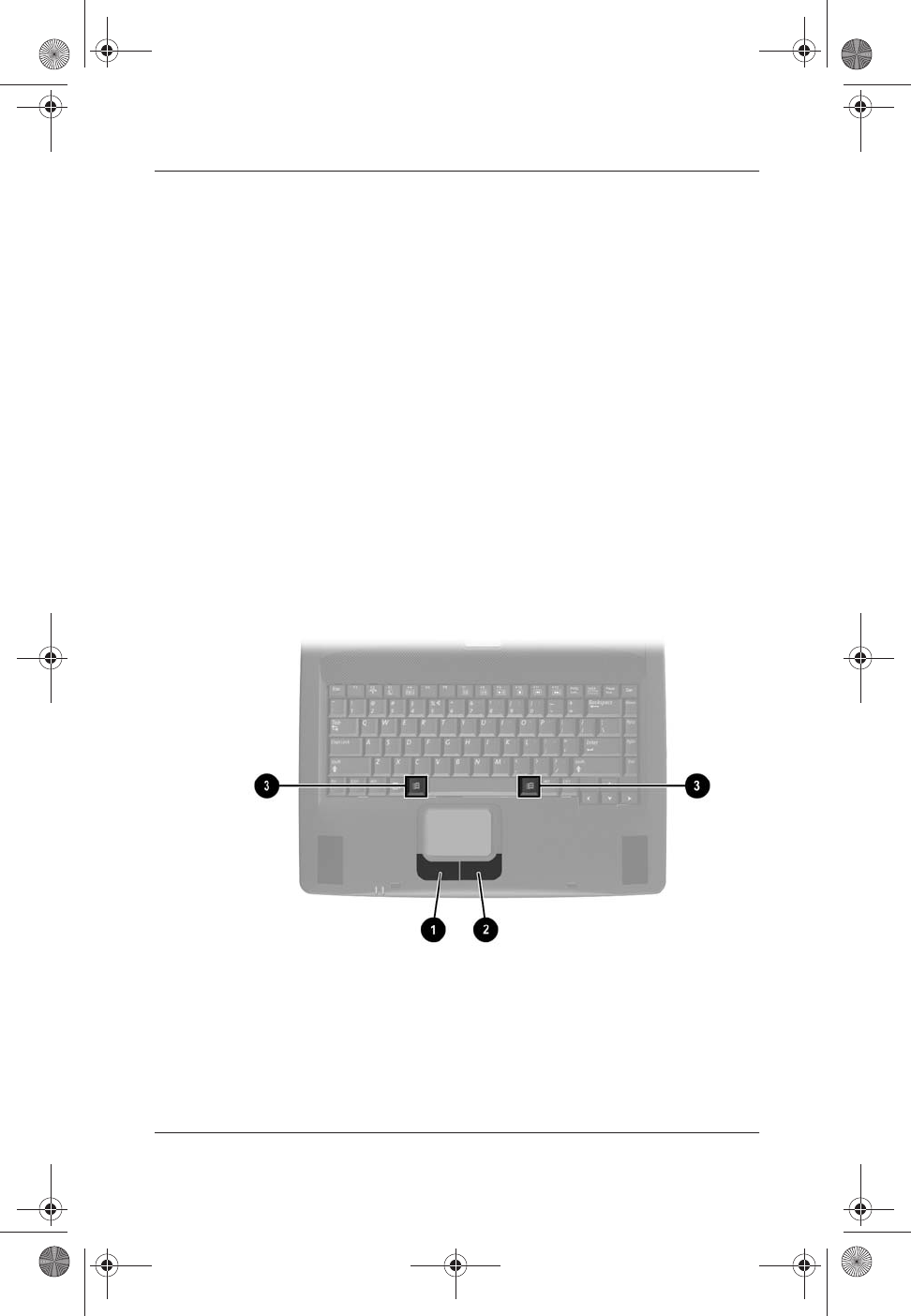
Using This Guide
Getting Started v
Following a Path
Instructions in documentation may direct you to a destination
within the operating system, an application, or a utility where you
can select settings. The greater than symbol (>) is used to direct
you along the path to the settings.
The paths described in your notebook documentation are based
on the notebook pointing device default functions:
■To select, press the left TouchPad button 1 once.
■To double-click, press the left TouchPad button twice.
■To right-click, press the right TouchPad button 2 once.
Most paths to Windows destinations begin with “Start >.” To
select Start (and display the Windows Start menu), select the Start
button in the lower left corner of your screen or press either of the
Microsoft logo keys 3 on the keyboard.
Identifying TouchPad buttons and Microsoft logo keys
(Key locations and availability vary by region and model.)
307502-003.book Page v Tuesday, February 4, 2003 10:44 AM
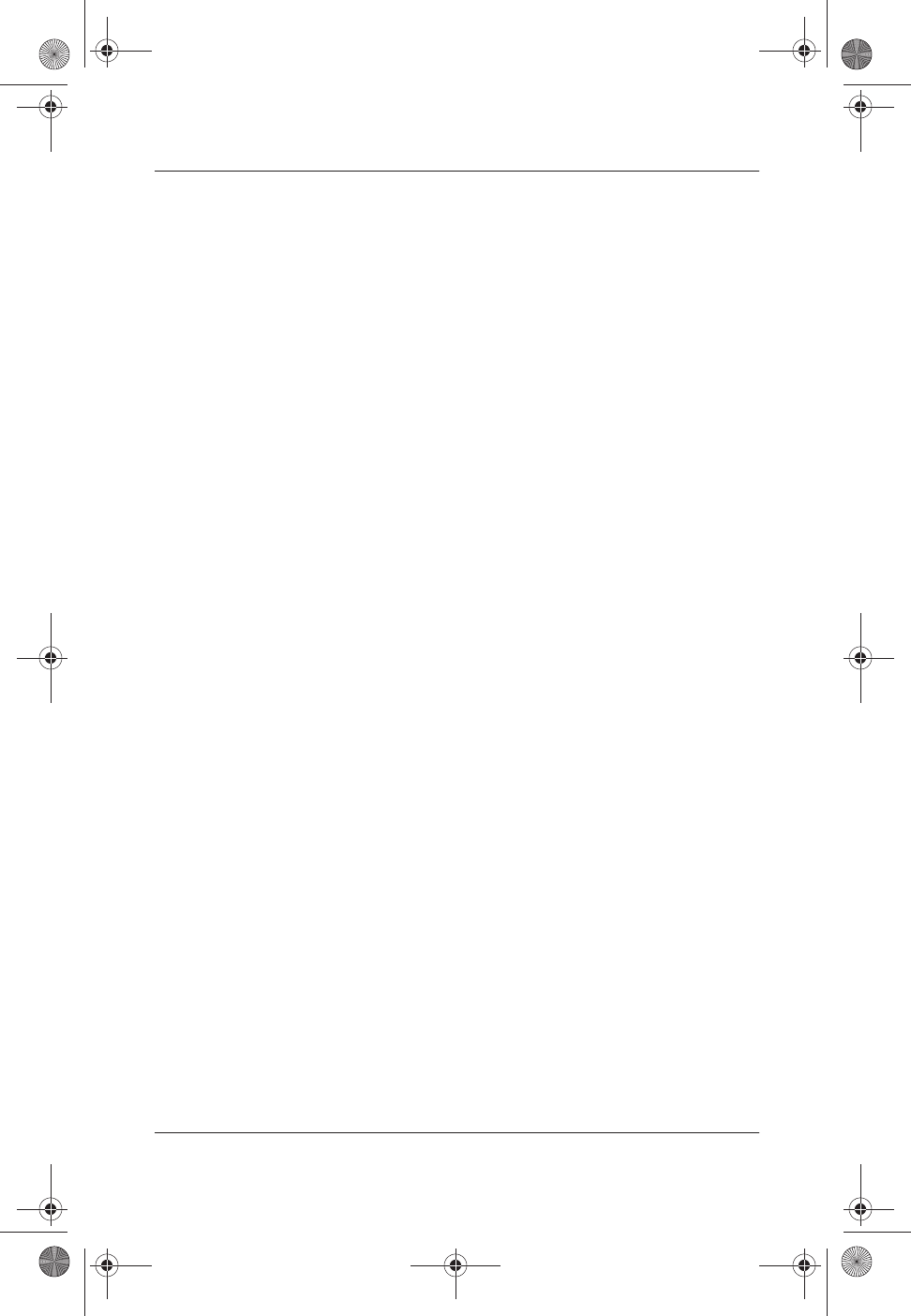
vi Getting Started
Using This Guide
307502-003.book Page vi Tuesday, February 4, 2003 10:44 AM
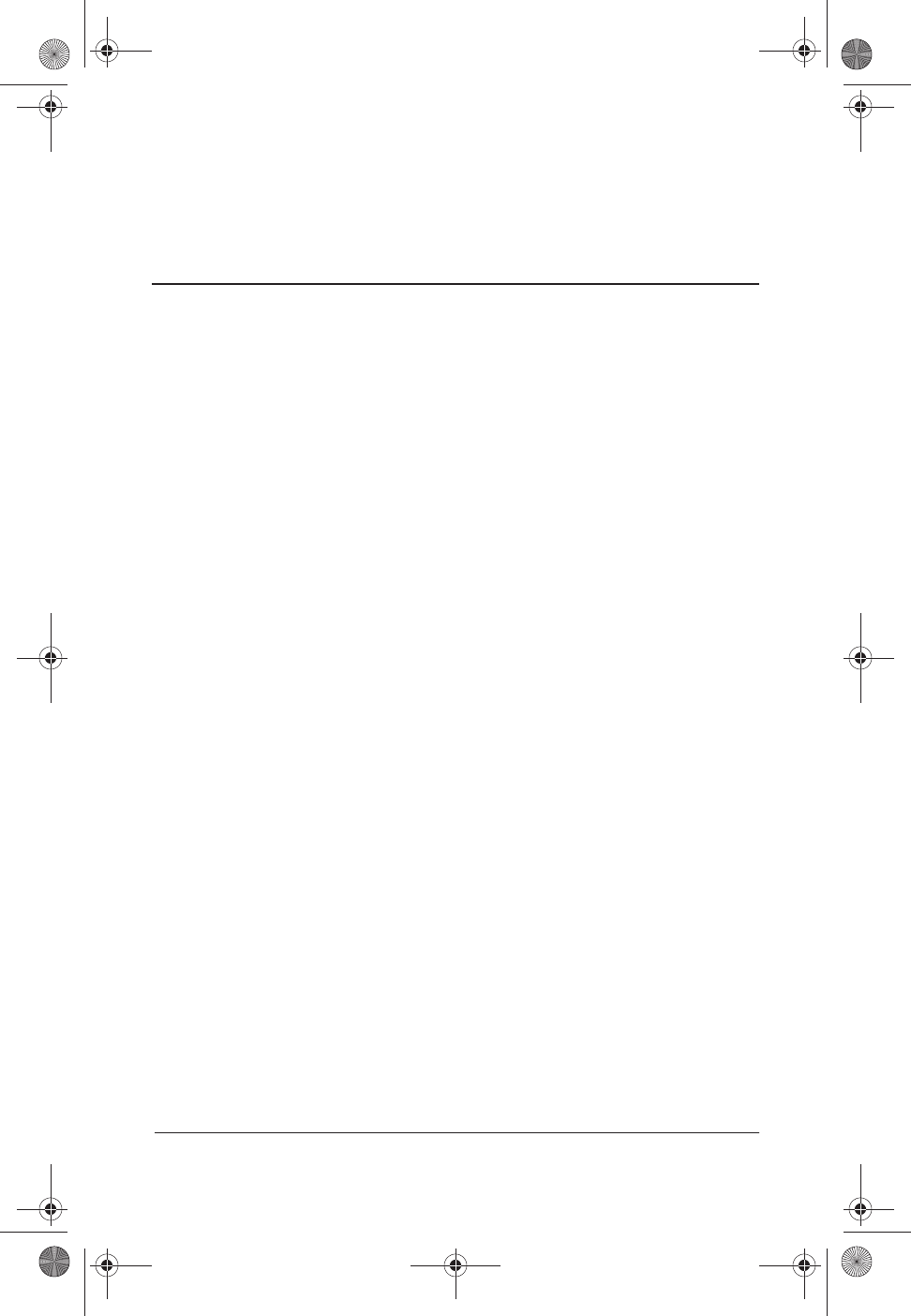
Getting Started vii
Contents
Using This Guide
1 Setting Up the Notebook
Setting Up the Hardware . . . . . . . . . . . . . . . . . . . . . . . . . 1–1
Inserting a Battery Pack. . . . . . . . . . . . . . . . . . . . . . . 1–2
Opening the Notebook. . . . . . . . . . . . . . . . . . . . . . . . 1–3
Connecting the Notebook to External Power . . . . . . 1–4
Turning On the Notebook . . . . . . . . . . . . . . . . . . . . . 1–6
Setting Up the Software . . . . . . . . . . . . . . . . . . . . . . . . . . 1–7
Turning Off the Notebook . . . . . . . . . . . . . . . . . . . . . . . . 1–8
Protecting the Notebook from Power Surges. . . . . . . . . . 1–8
Using the Notebook Safely . . . . . . . . . . . . . . . . . . . . . . . 1–9
2 Beginning to Use the Notebook
Selecting Regional Settings . . . . . . . . . . . . . . . . . . . . . . . 2–1
Selecting Screen Settings . . . . . . . . . . . . . . . . . . . . . . . . . 2–1
Protecting the Notebook Against Viruses . . . . . . . . . . . . 2–2
Obtaining Modem and Network Information . . . . . . . . . 2–2
Installing Optional Software . . . . . . . . . . . . . . . . . . . . . . 2–3
Using the Documentation Library CD . . . . . . . . . . . . . . . 2–4
Inserting the Documentation Library CD . . . . . . . . . 2–4
Accessing the Documentation Library Menu . . . . . . 2–5
Selecting a Guide. . . . . . . . . . . . . . . . . . . . . . . . . . . . 2–6
Finding a Topic Within a Guide . . . . . . . . . . . . . . . . 2–7
Contacting Compaq . . . . . . . . . . . . . . . . . . . . . . . . . . . . . 2–8
Using Compaq Help and Support . . . . . . . . . . . . . . . 2–8
Obtaining Support Telephone Numbers . . . . . . . . . . 2–8
307502-003.book Page vii Tuesday, February 4, 2003 10:44 AM
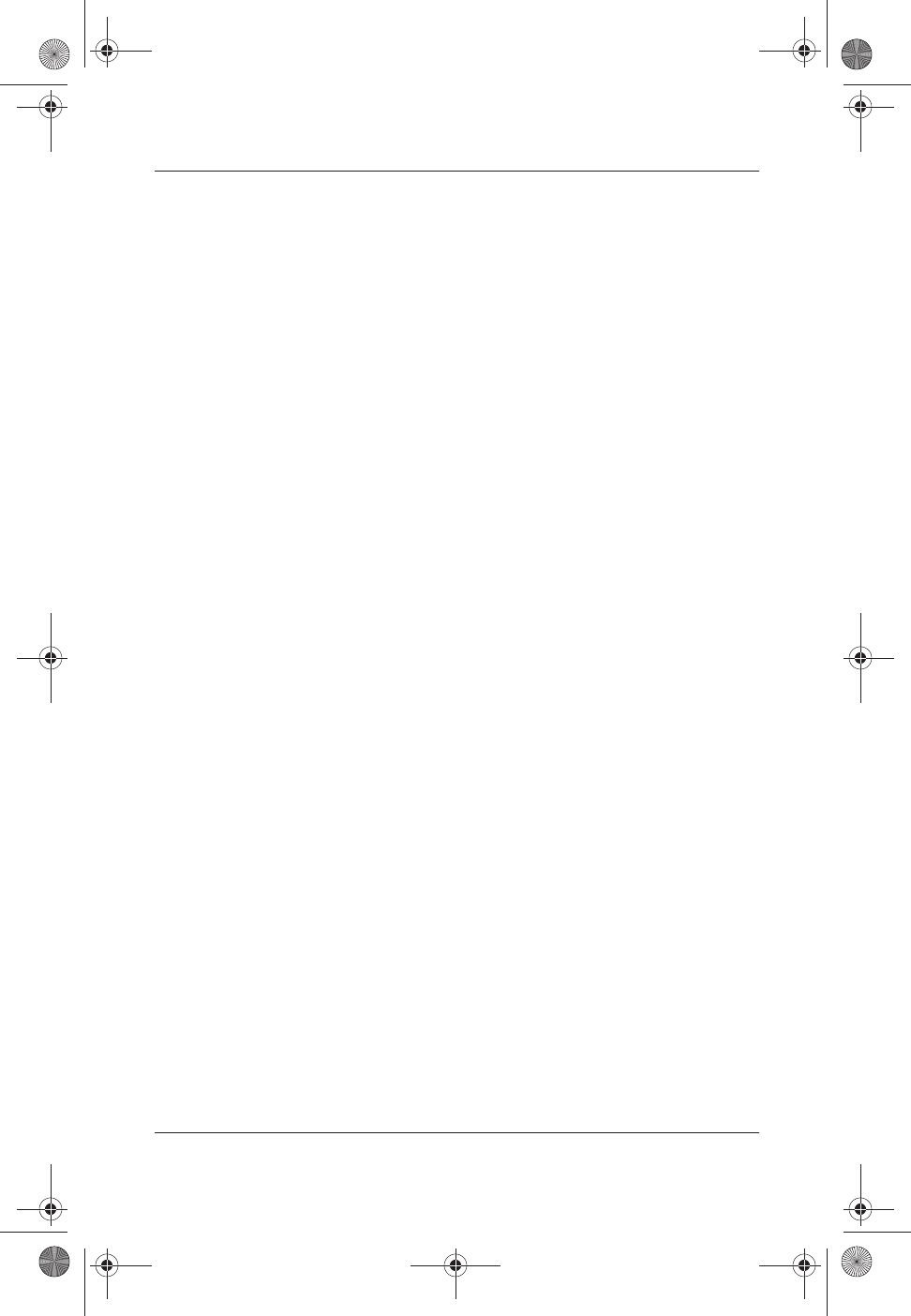
viii Getting Started
Contents
Preparing to Call Technical Support . . . . . . . . . . . . . 2–9
Taking the Notebook to a Service Provider. . . . . . . . 2–9
Index
3 Hardware Components
Display . . . . . . . . . . . . . . . . . . . . . . . . . . . . . . . . . . . . . . . 3–1
Pointing Device and Speakers . . . . . . . . . . . . . . . . . . . . . 3–2
Top . . . . . . . . . . . . . . . . . . . . . . . . . . . . . . . . . . . . . . . . . . 3–3
Power/Standby Light, Battery Light and Vent . . . . . 3–3
Panel Lights . . . . . . . . . . . . . . . . . . . . . . . . . . . . . . . . 3–4
Power Controls . . . . . . . . . . . . . . . . . . . . . . . . . . . . . 3–5
Keys . . . . . . . . . . . . . . . . . . . . . . . . . . . . . . . . . . . . . . 3–6
Rear Panel . . . . . . . . . . . . . . . . . . . . . . . . . . . . . . . . . . . . 3–7
Connectors and Infrared Port. . . . . . . . . . . . . . . . . . . 3–7
Jacks, Fan and Vent . . . . . . . . . . . . . . . . . . . . . . . . . . 3–8
Left Side . . . . . . . . . . . . . . . . . . . . . . . . . . . . . . . . . . . . . . 3–9
Right Side. . . . . . . . . . . . . . . . . . . . . . . . . . . . . . . . . . . . 3–10
Volume Buttons and Audio Jacks . . . . . . . . . . . . . . 3–10
Optical Drive and PC Card Slot . . . . . . . . . . . . . . . 3–11
Underside . . . . . . . . . . . . . . . . . . . . . . . . . . . . . . . . . . . . 3–12
Battery Bay and Hard Drive Bay. . . . . . . . . . . . . . . 3–12
Memory Compartment and Vent. . . . . . . . . . . . . . . 3–13
Labels. . . . . . . . . . . . . . . . . . . . . . . . . . . . . . . . . . . . 3–14
Additional Standard Components . . . . . . . . . . . . . . . . . 3–15
Software Restore and Documentation CDs . . . . . . . 3–15
Cables and Cord. . . . . . . . . . . . . . . . . . . . . . . . . . . . 3–16
Adapters and Battery Pack . . . . . . . . . . . . . . . . . . . 3–17
307502-003.book Page viii Tuesday, February 4, 2003 10:44 AM
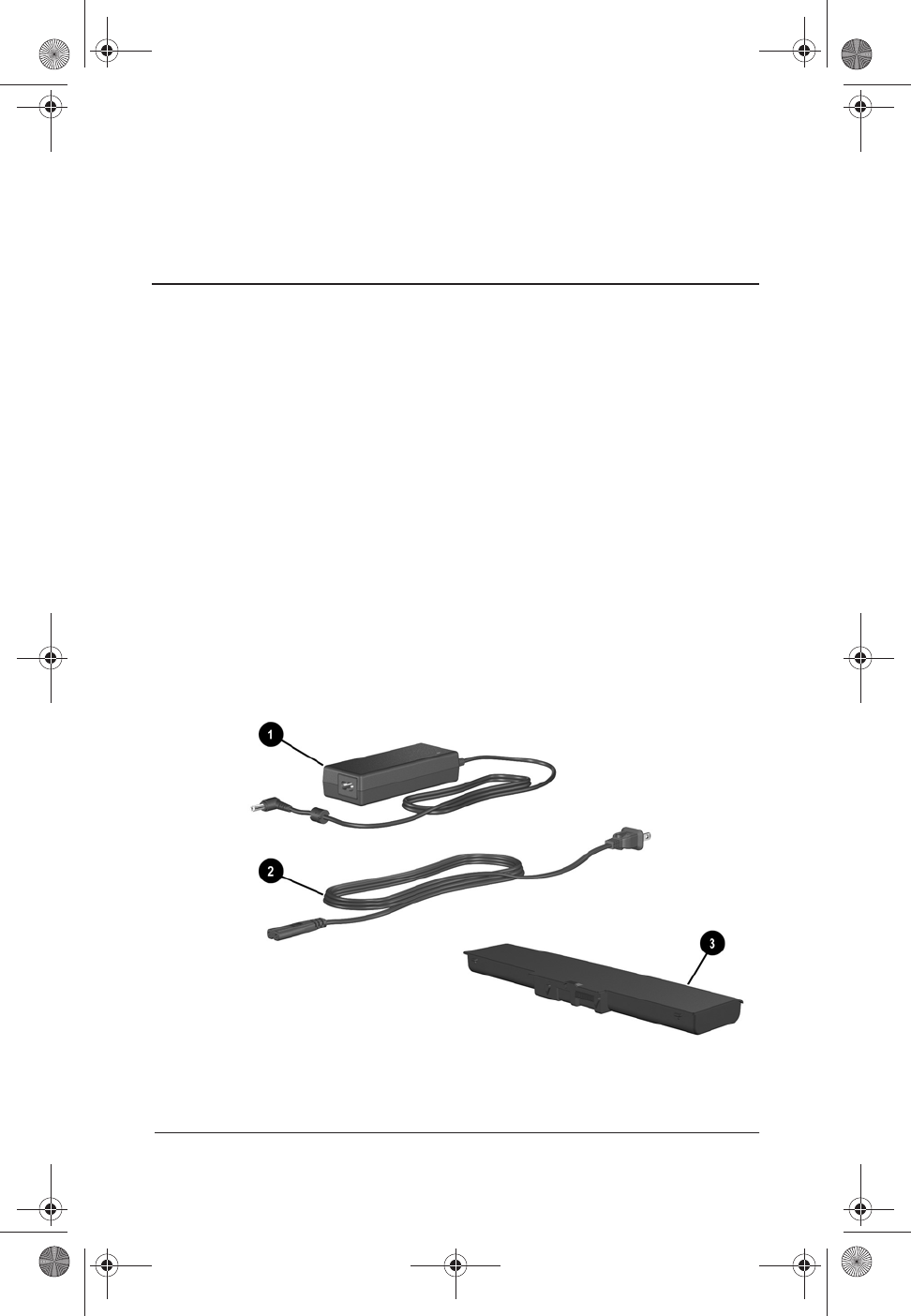
Getting Started 1–1
1
Setting Up the Notebook
Setting Up the Hardware
To set up the notebook for the first time, you need the notebook,
the AC adapter 1, and the power cord 2. If a battery pack
shipped with your notebook, you will also you also need the
battery pack 3. During the hardware setup, you will:
1. Insert the battery pack, if available, so the battery can begin to
charge.
2. Open the notebook so you can monitor indicator lights during
setup.
3. Connect the notebook to external power and turn on the
notebook so you can begin software setup.
Identifying the AC adapter, power cord, and battery pack (AC
adapters and power cords vary by region.)
307502-003.book Page 1 Tuesday, February 4, 2003 10:44 AM
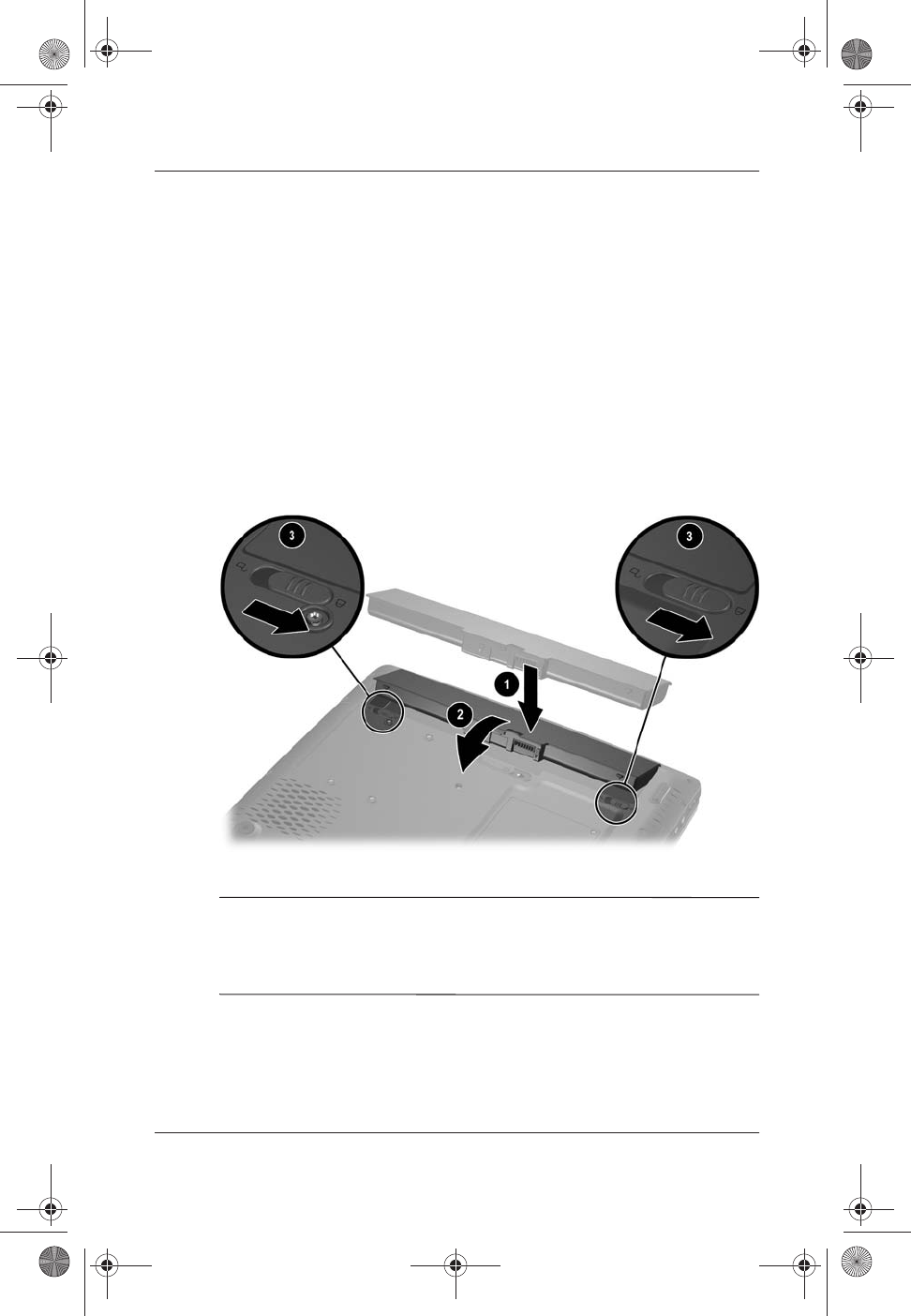
1–2 Getting Started
Setting Up the Notebook
Inserting a Battery Pack
If your notebook shipped without an optional battery pack,
proceed to the next section, “Opening the Notebook.”
If your notebook shipped with a battery pack:
1. Turn the notebook underside up on a flat surface.
2. Lower the battery pack into the battery bay at a slight
angle 1, then press downward until the battery pack is
seated 2.
3. Slide the 2 battery pack locking latches to the locked
position 3.
Installing a battery pack
ÄCAUTION: To ensure that the correct drivers load and to prevent
file corruption or damage to components during initial setup, do not
remove the battery pack until the notebook has been connected to
external AC power.
307502-003.book Page 2 Tuesday, February 4, 2003 10:44 AM
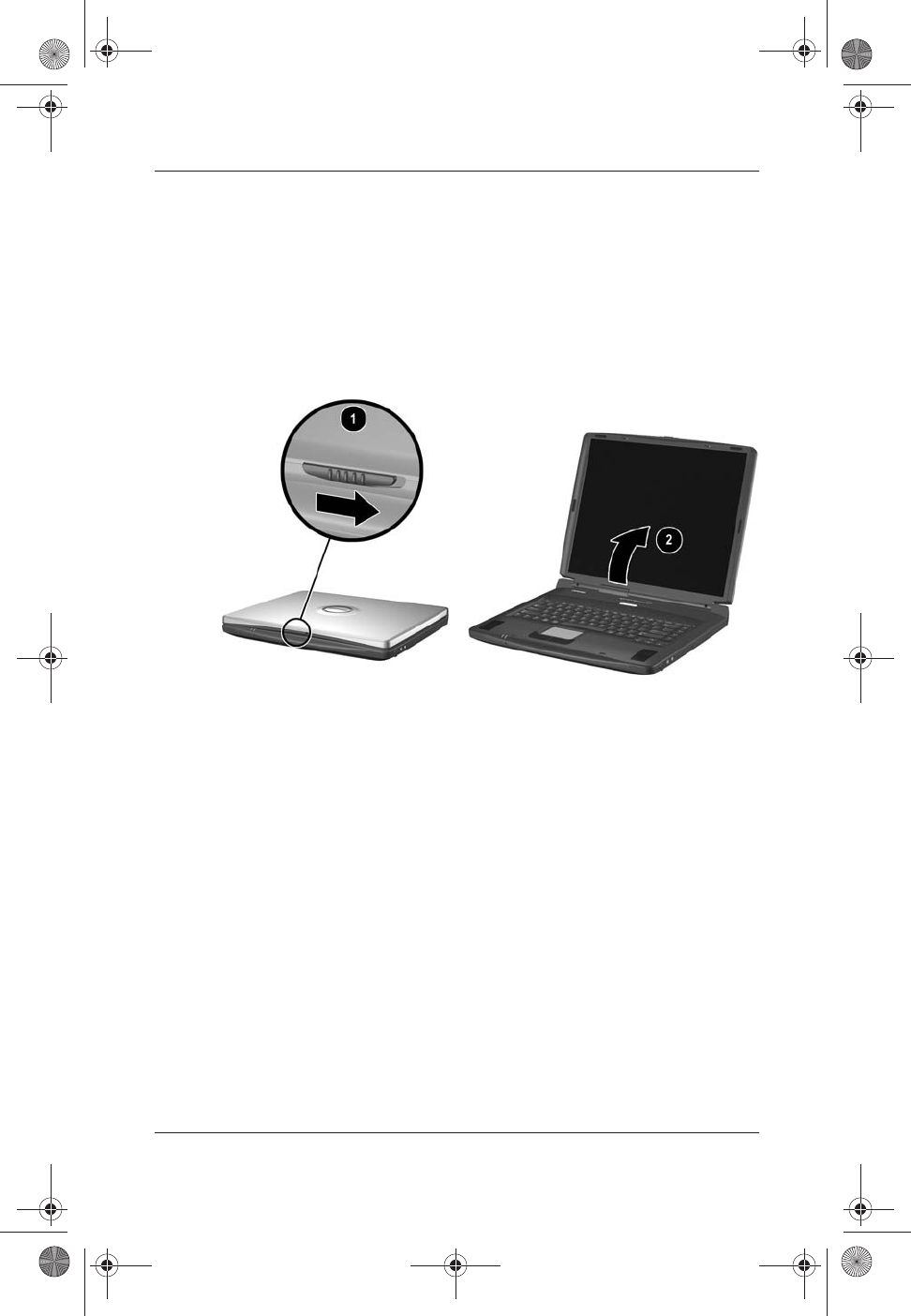
Setting Up the Notebook
Getting Started 1–3
Opening the Notebook
To open the notebook:
1. Place the notebook display side up on a flat surface near an
electrical outlet.
2. Slide the display release latch 1 as you raise the display 2.
Opening the notebook
307502-003.book Page 3 Tuesday, February 4, 2003 10:44 AM
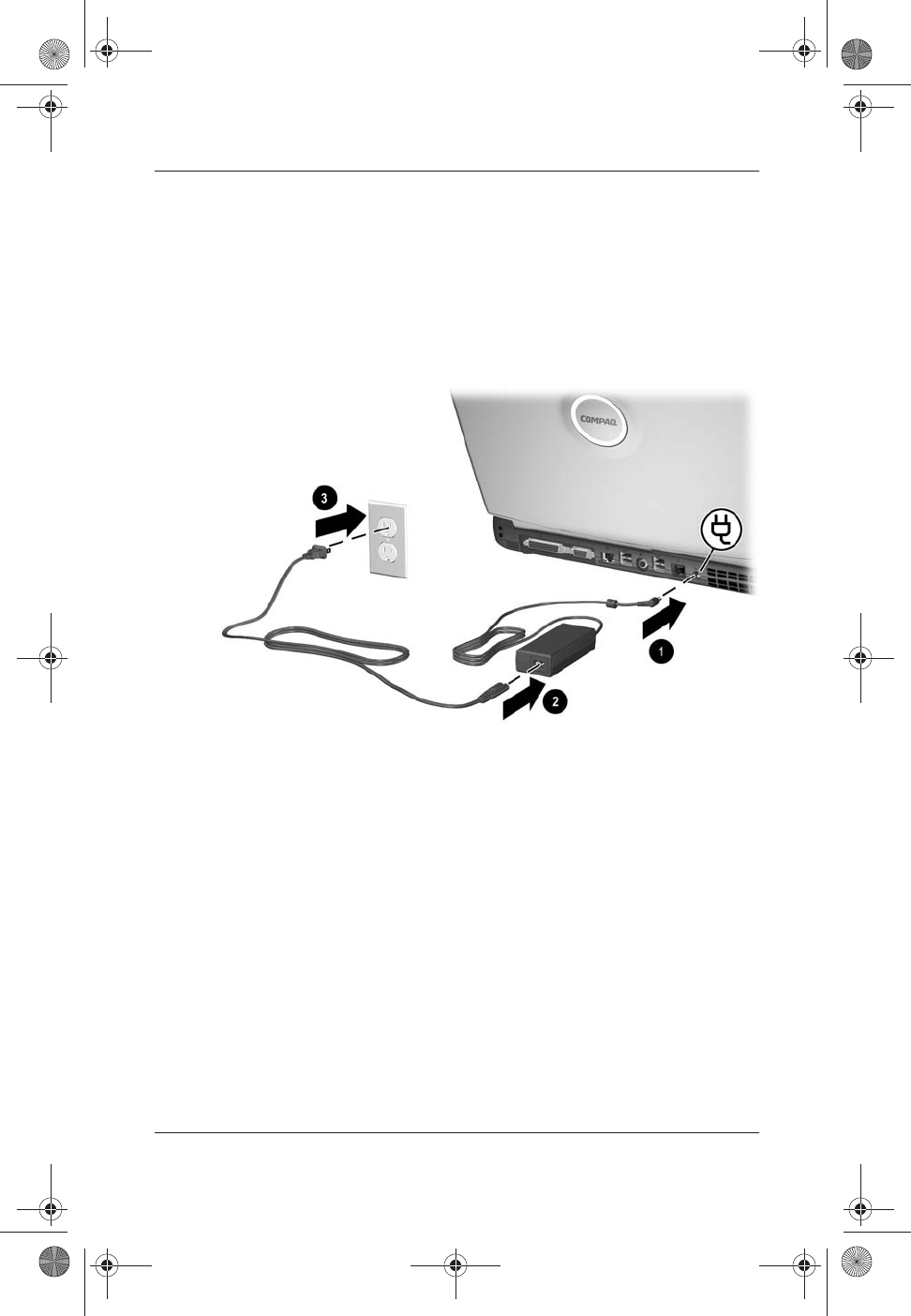
1–4 Getting Started
Setting Up the Notebook
Connecting the Notebook to External Power
To connect the notebook to external power:
1. Plug the AC adapter cable into the AC power connector 1.
2. Plug the power cord into the AC adapter 2, then into an
accessible electrical outlet 3.
Connecting the notebook to external power (AC adapters,
power cords, and outlets vary by model and region.)
307502-003.book Page 4 Tuesday, February 4, 2003 10:44 AM
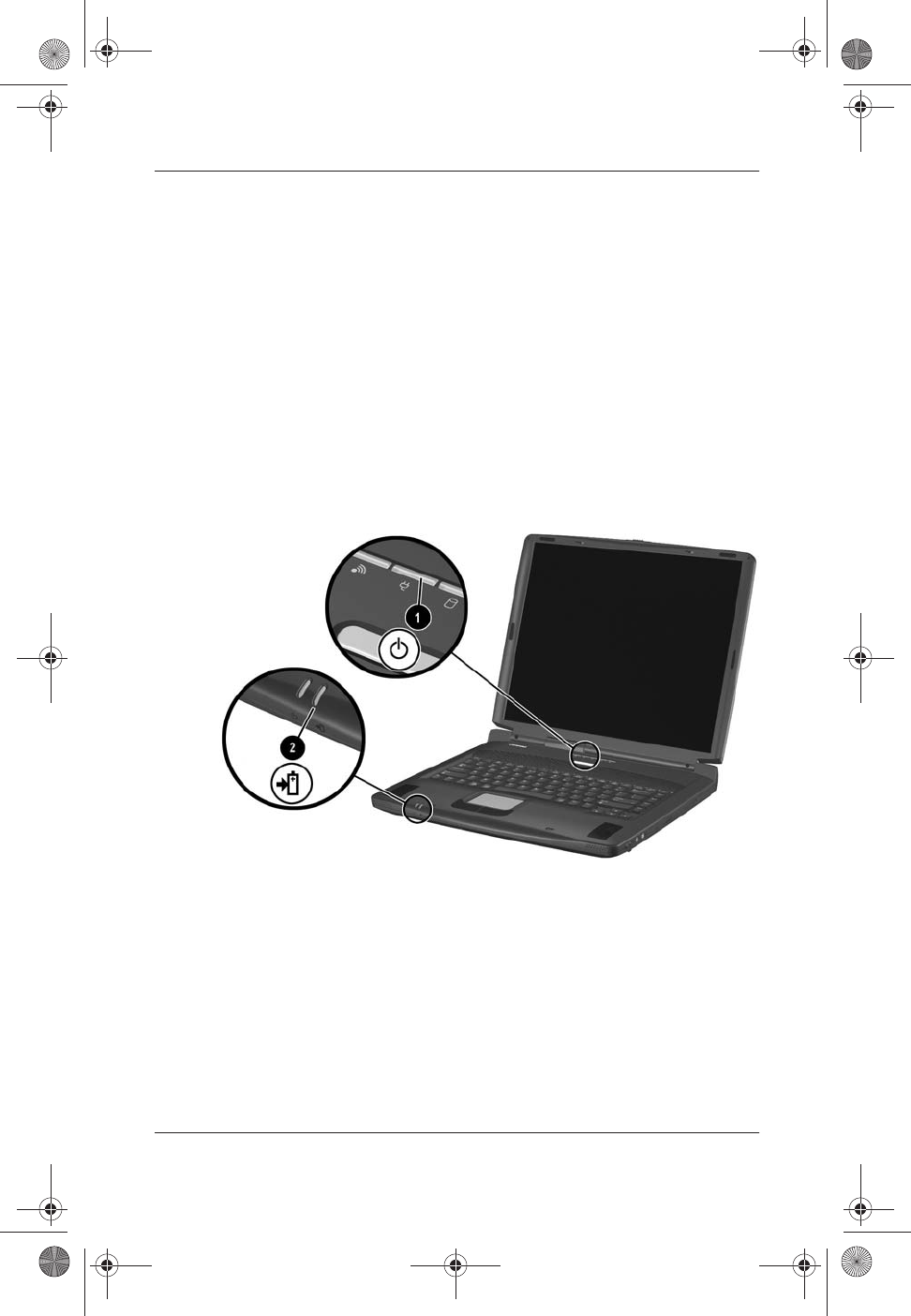
Setting Up the Notebook
Getting Started 1–5
When the notebook receives AC power:
■The AC adapter light 1 turns on.
■An inserted battery pack begins to charge. The battery light 2
turns on when the battery pack begins to charge and turns off
when the battery pack is fully charged.
Compaq recommends that you leave the notebook connected
to external power until the battery pack is fully charged and
the battery light turns off. (A partially charged new battery
pack can run the notebook after initial software setup is
complete, but battery charge displays will not be accurate
until the new battery pack has been fully charged.)
Identifying the AC adapter light and the battery light
307502-003.book Page 5 Tuesday, February 4, 2003 10:44 AM
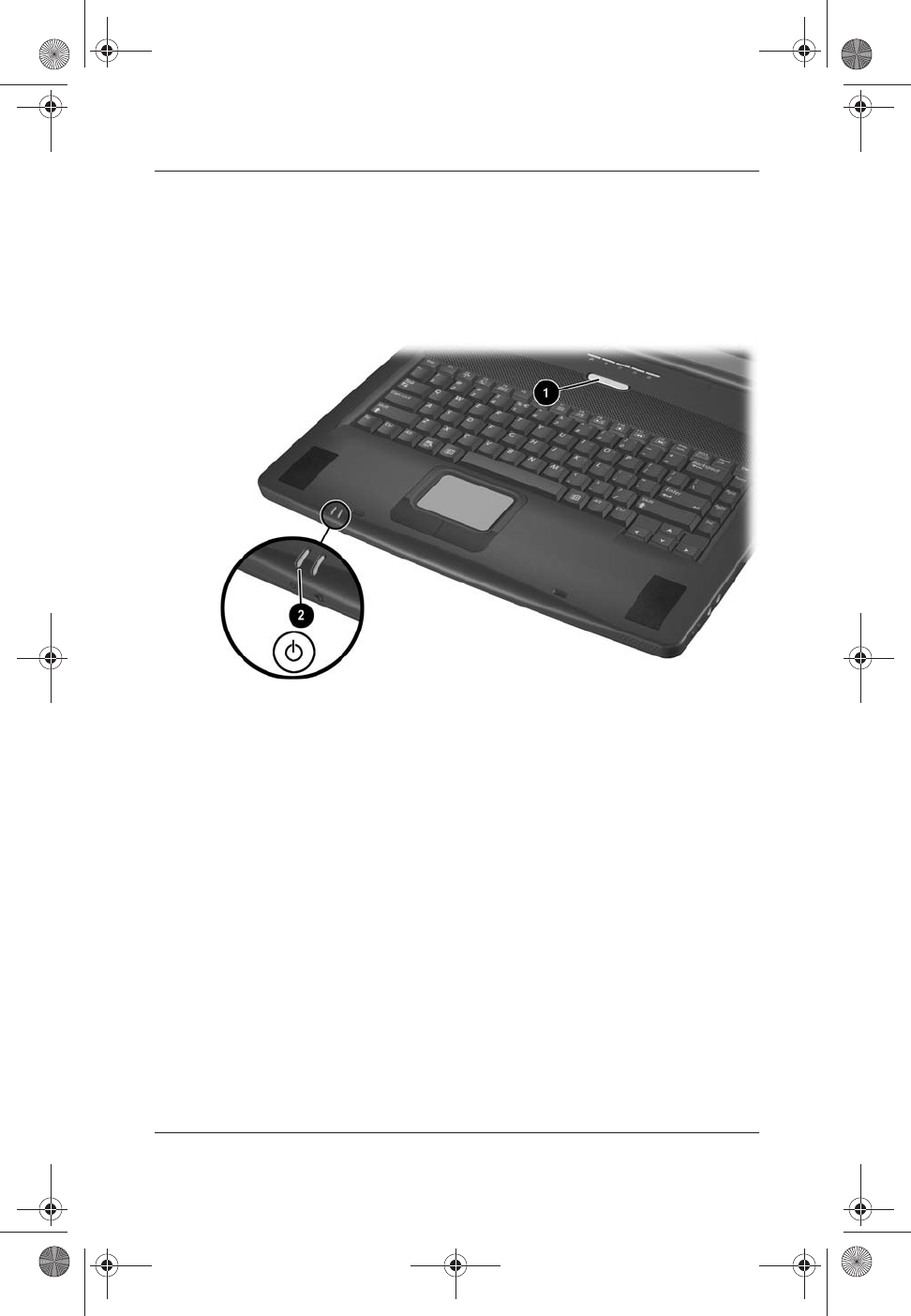
1–6 Getting Started
Setting Up the Notebook
Turning On the Notebook
To turn on the notebook, press the power button 1. When the
notebook turns on, the power/standby light 2 turns on, and
you are prompted to begin software setup.
Turning on the notebook
If the notebook does not turn on:
■Make sure that the AC adapter is securely plugged into an
electrical outlet.
■Make sure that the outlet is providing power. (To confirm
that the outlet is providing power, plug another device
into the outlet.)
■If you have installed a battery pack, make sure that the
battery pack is firmly seated.
307502-003.book Page 6 Tuesday, February 4, 2003 10:44 AM
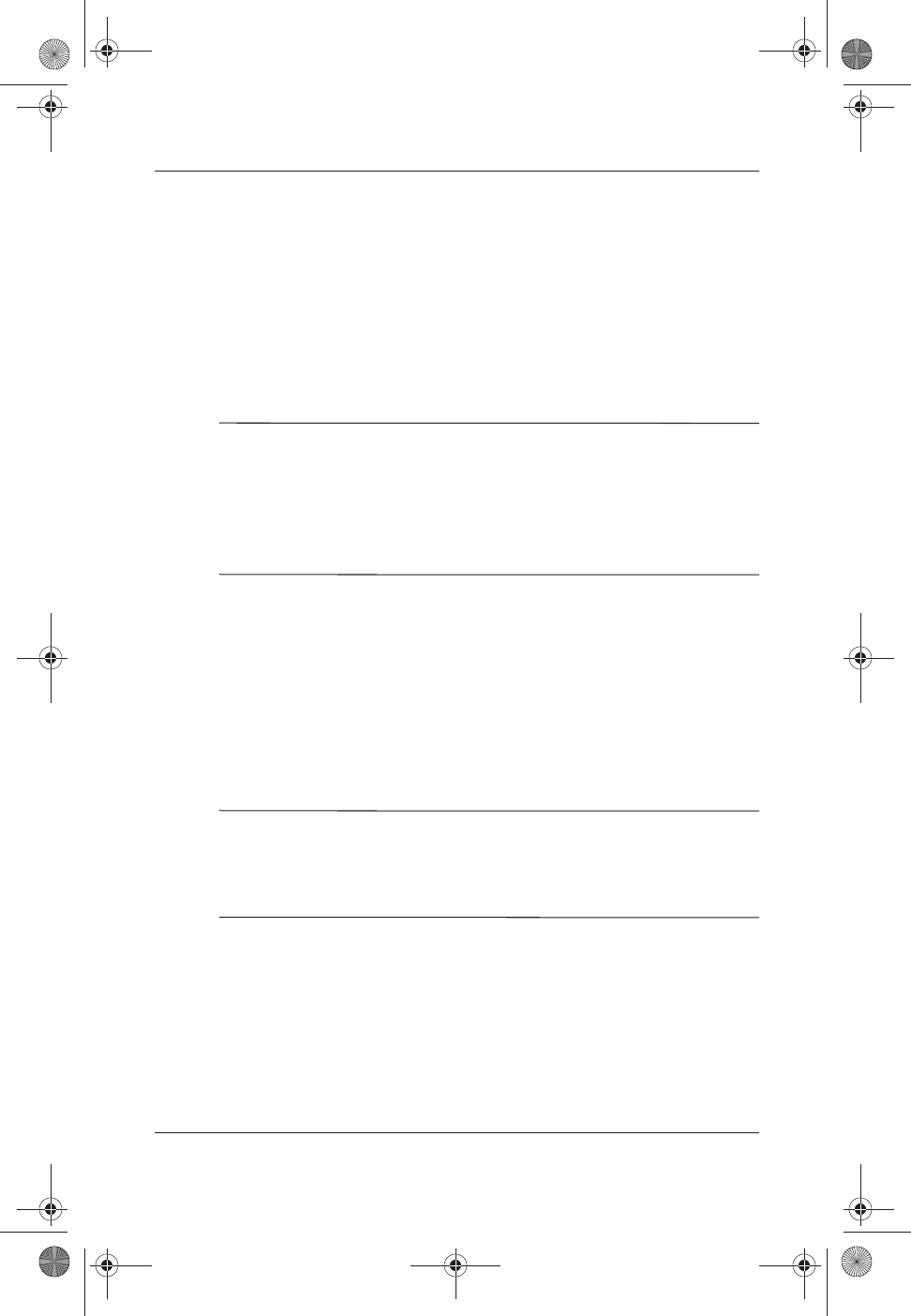
Setting Up the Notebook
Getting Started 1–7
Setting Up the Software
A prompt to set up the software is displayed on the screen when
the notebook is connected to external power and turned on for the
first time.
Before responding to the prompt and proceeding through the
on-screen instructions, read the following caution and other
installation information.
ÄCAUTION: To prevent file corruption and be sure that the correct device
drivers install, during software setup:
■Run the notebook on external power provided through an
AC adapter or a DC cable, not on battery power.
■Do not unplug the notebook from the electrical outlet.
■Do not shut down the notebook.
■After beginning the software setup, you must complete the
entire process without interruption. Setup time varies.
■If you are prompted to select a language, choose carefully.
The languages that you do not choose are deleted from the
system and cannot be restored during the installation.
■When you are prompted to accept the End User License
Agreement, you must choose Accept to continue the
software setup.
✎During setup, it is normal for some notebook models to pause
occasionally for up to 2 minutes and to restart several times.
These pauses and restarts occur only during initial software setup.
They will not occur during standard Windows startups.
307502-003.book Page 7 Tuesday, February 4, 2003 10:44 AM
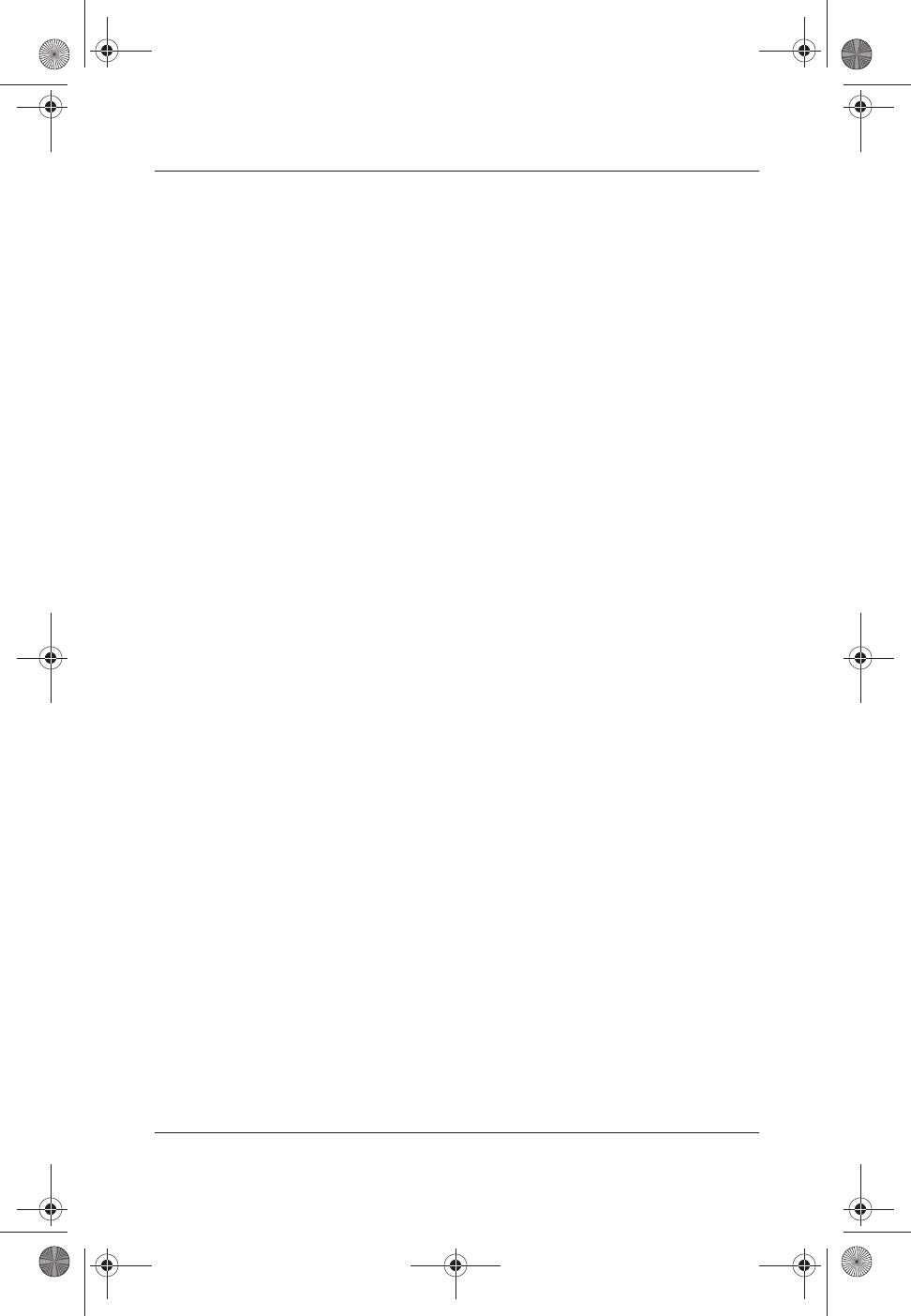
1–8 Getting Started
Setting Up the Notebook
Turning Off the Notebook
Turn off the notebook by using the Windows shutdown
procedure: Select Start > Turn Off Computer > Turn Off.
If the notebook does not respond to the Windows shutdown
procedure, try the following emergency shutdown procedures:
■Press and hold down the power button for at least 5 seconds.
■If the notebook remains unresponsive, press Fn+power
button.
■If the notebook still remains unresponsive, disconnect the
notebook from external power and remove the battery pack.
Protecting the Notebook from
Power Surges
To protect the notebook from the power surges that may be
caused by an uncertain power supply or an electrical storm:
■Plug the notebook power cord into an optional, high-quality
surge protector.
■Provide surge protection on the cable that connects a modem
to the telephone line.
■During an electrical storm, run the notebook on battery power
or shut down the notebook and disconnect the power cord.
Surge protectors are available from most computer or electronics
retailers.
307502-003.book Page 8 Tuesday, February 4, 2003 10:44 AM
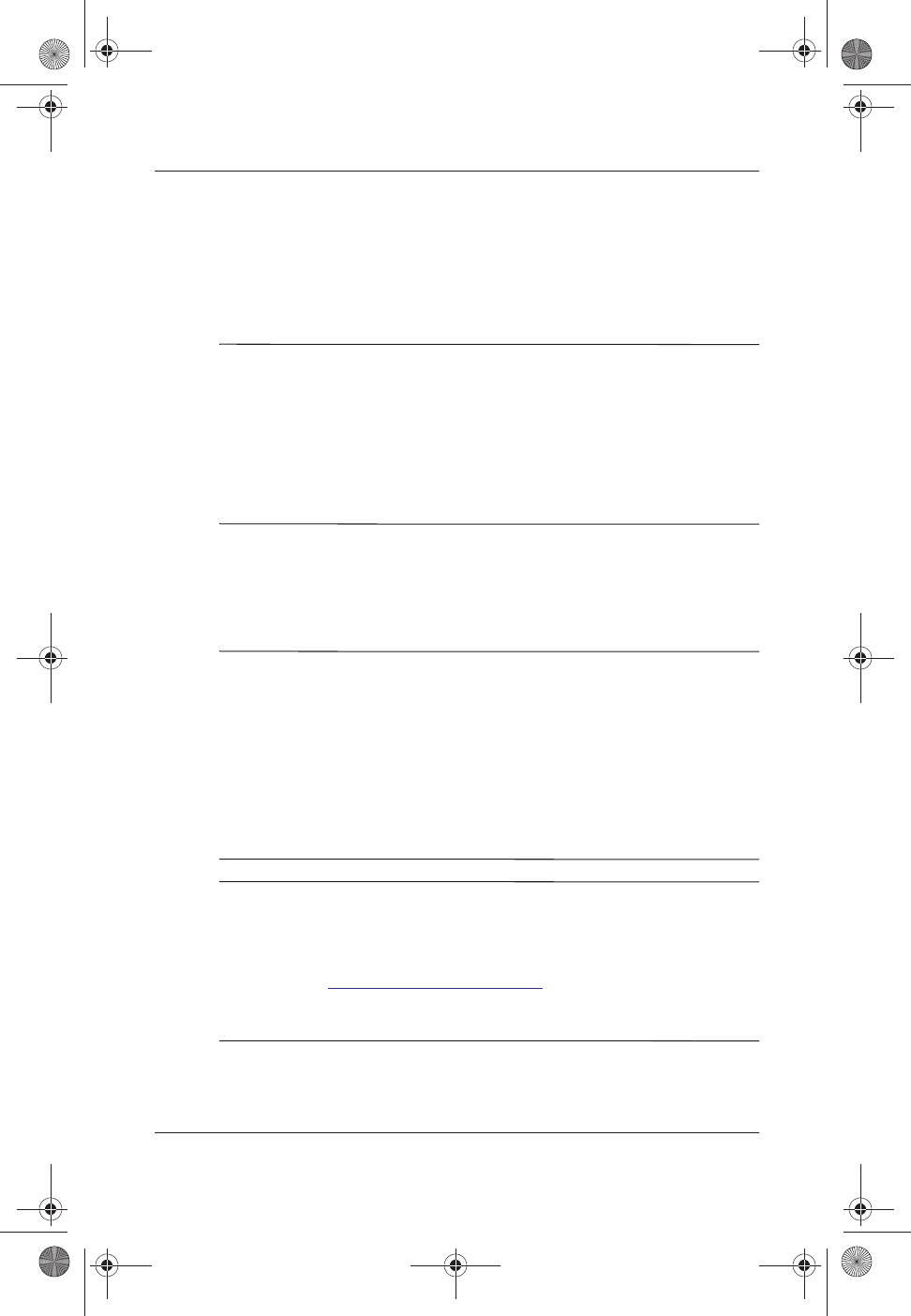
Setting Up the Notebook
Getting Started 1–9
Using the Notebook Safely
To learn more about protecting yourself, your work, and your
notebook from electrical and other risks, read the following
warnings:
ÅWARNING: The notebook is designed to run demanding
applications at full power. As a result of increased power
consumption, it is normal for the notebook to feel warm or hot when
used continuously. To avoid potential discomfort or burns, do not
block the air vents or use the notebook on your lap for extended
periods. The notebook complies with the user-accessible surface
temperature limits defined by the international Standard for Safety
of Information Technology Equipment (ICE 60950).
This equipment has been tested and found to comply with the
limits for a Class B digital device, pursuant to part 15 of the FCC
Rules. For notebooks with built in radio please refer to the WLAN
card user guide for the related RF exposure requirements.
ÅWARNING: To reduce the risk of electric shock or damage to your
equipment:
■Plug the power cord into an electrical outlet that is easily
accessible at all times.
■Disconnect power from the product by unplugging the power
cord from the electrical outlet.
■If provided with a three-wire power supply cord having a
three-pin attachment plug, plug the cord into a grounded
(earthed) outlet. Do not disable the power cord grounding pin.
The grounding pin is an important safety feature.
ÅWARNING: To reduce the risk of serious injury, read the
Safety &
Comfort
Guide. It describes proper workstation setup, posture, and
health and work habits for computer users, and provides important
electrical and mechanical safety information. This guide is located
on the Web at <<www.compaq.com/ergo>> and on the hard drive
or on the
Documentation Library
CD that is included with the
product.
307502-003.book Page 9 Tuesday, February 4, 2003 10:44 AM
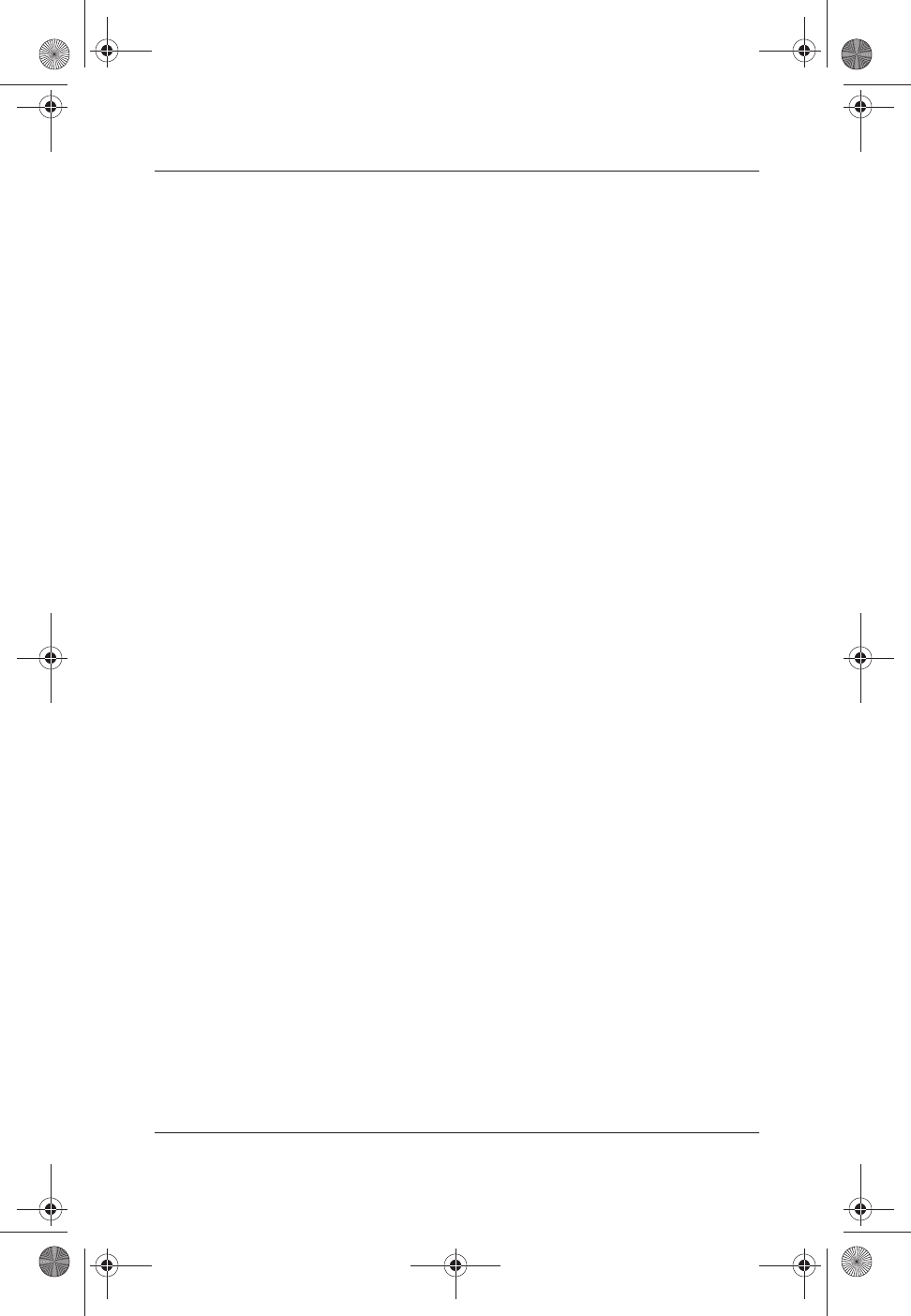
1–10 Getting Started
Setting Up the Notebook
307502-003.book Page 10 Tuesday, February 4, 2003 10:44 AM
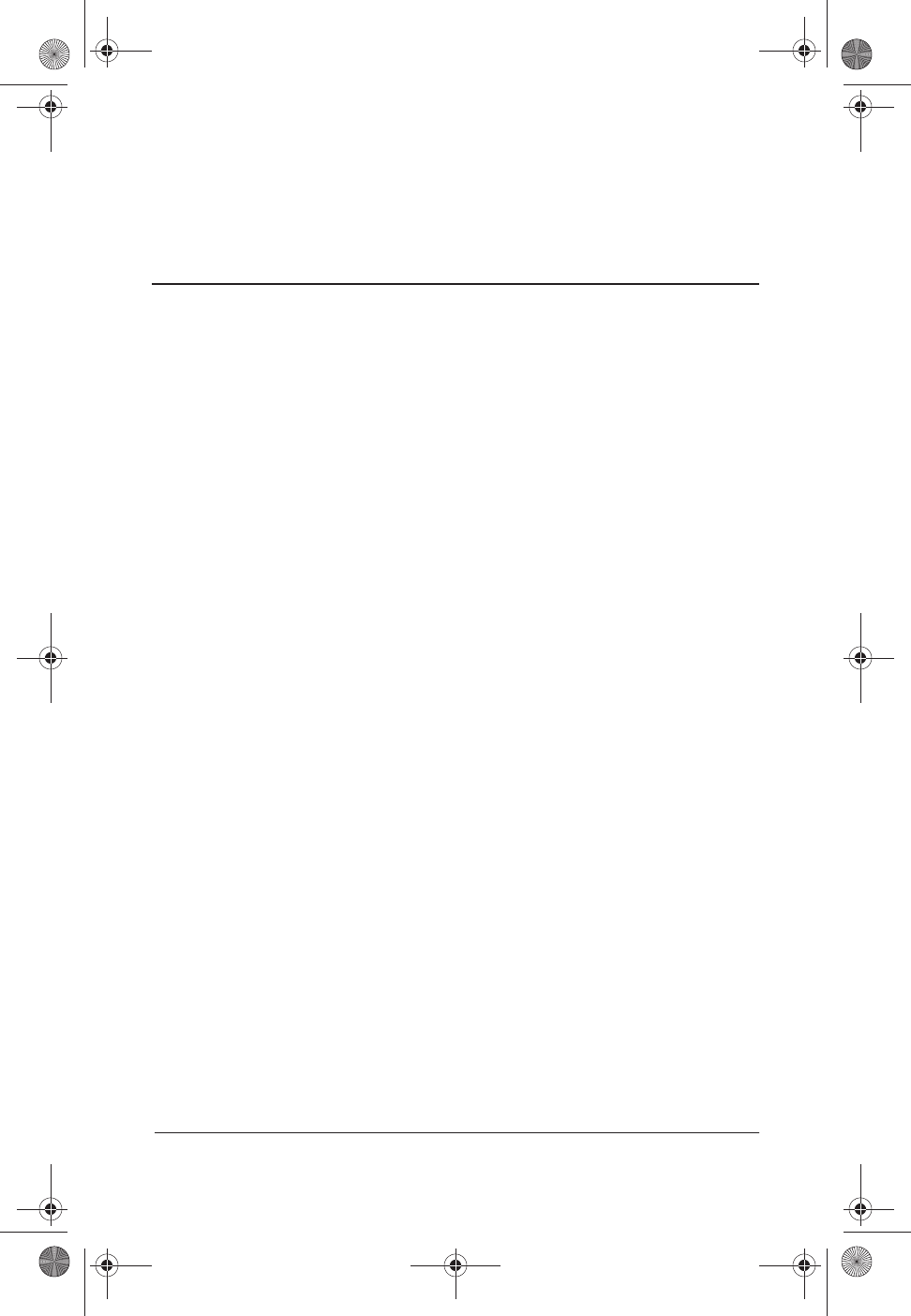
Getting Started 2–1
2
Beginning to Use the Notebook
Selecting Regional Settings
Keyboard language and other regional preferences, such as time,
date, and currency format, are set in the Regional Options
window of the operating system.
To access the Regional Options window, select Start > Control
Panel > Date, Time, Language and Regional Options icon.
For information about selecting regional settings, open the
Regional Options window, then use context-sensitive Help.
To use context-sensitive Help, select the question mark button
in the upper right corner of the window, then select an item.
A definition, explanation, or procedure is displayed.
Selecting Screen Settings
Screen appearance settings are accessed from the operating
system Appearance and Themes window. To access the
Appearance and Themes window, select Start > Control
Panel > Appearance and Themes icon.
To access the settings that control the size of the items displayed
on the screen, select the Change Resolution task.
For information about any of the items in any of the windows
accessed from the Appearance and Themes icon, use
context-sensitive Help. To use context-sensitive Help, select the
question mark button in the upper right corner of a window, then
select an item. A definition, explanation, or procedure is
displayed.
307502-003.book Page 1 Tuesday, February 4, 2003 10:44 AM
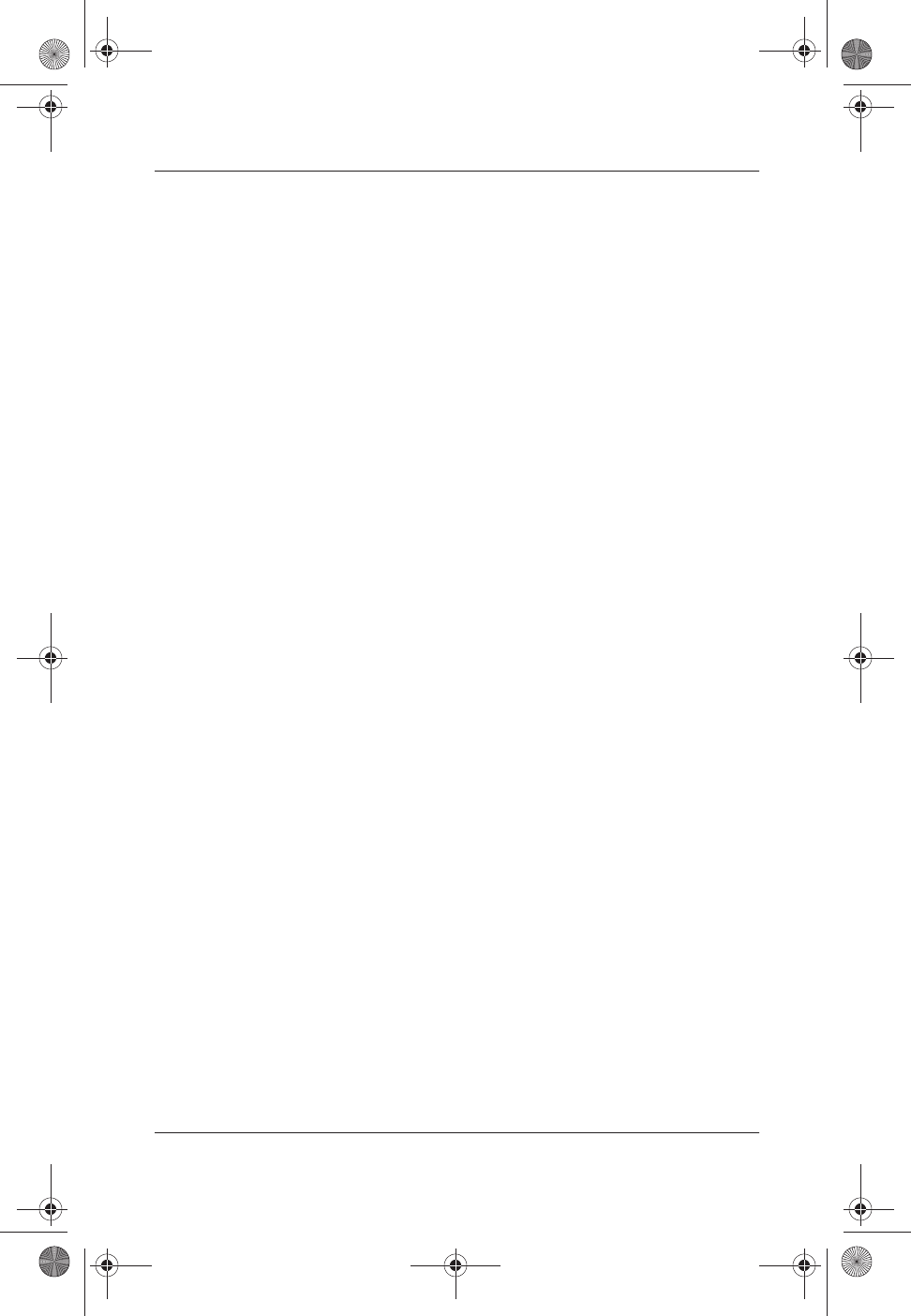
2–2 Getting Started
Beginning to Use the Notebook
Protecting the Notebook Against Viruses
When you use the notebook for email, network, or Internet
access, you expose the notebook to computer viruses. Computer
viruses can disable the operating system, your applications, or
your utilities or cause them to function abnormally.
Antivirus software can detect most viruses, destroy them, and, in
most cases, repair damage they have caused.
Compaq strongly recommends that you install optional antivirus
software before using a modem or network connection.
Antivirus software is available from most computer or electronics
retailers.
Obtaining Modem and Network
Information
For information about connecting an optional internal modem or
NIC (network interface card), refer to the Modem and Networking
guide on the Documentation Library CD included with the
notebook. Instructions for using the Documentation Library CD
are provided later in this chapter.
For information about setting up an optional internal wireless
LAN device, refer to the documentation included with the device.
307502-003.book Page 2 Tuesday, February 4, 2003 10:44 AM
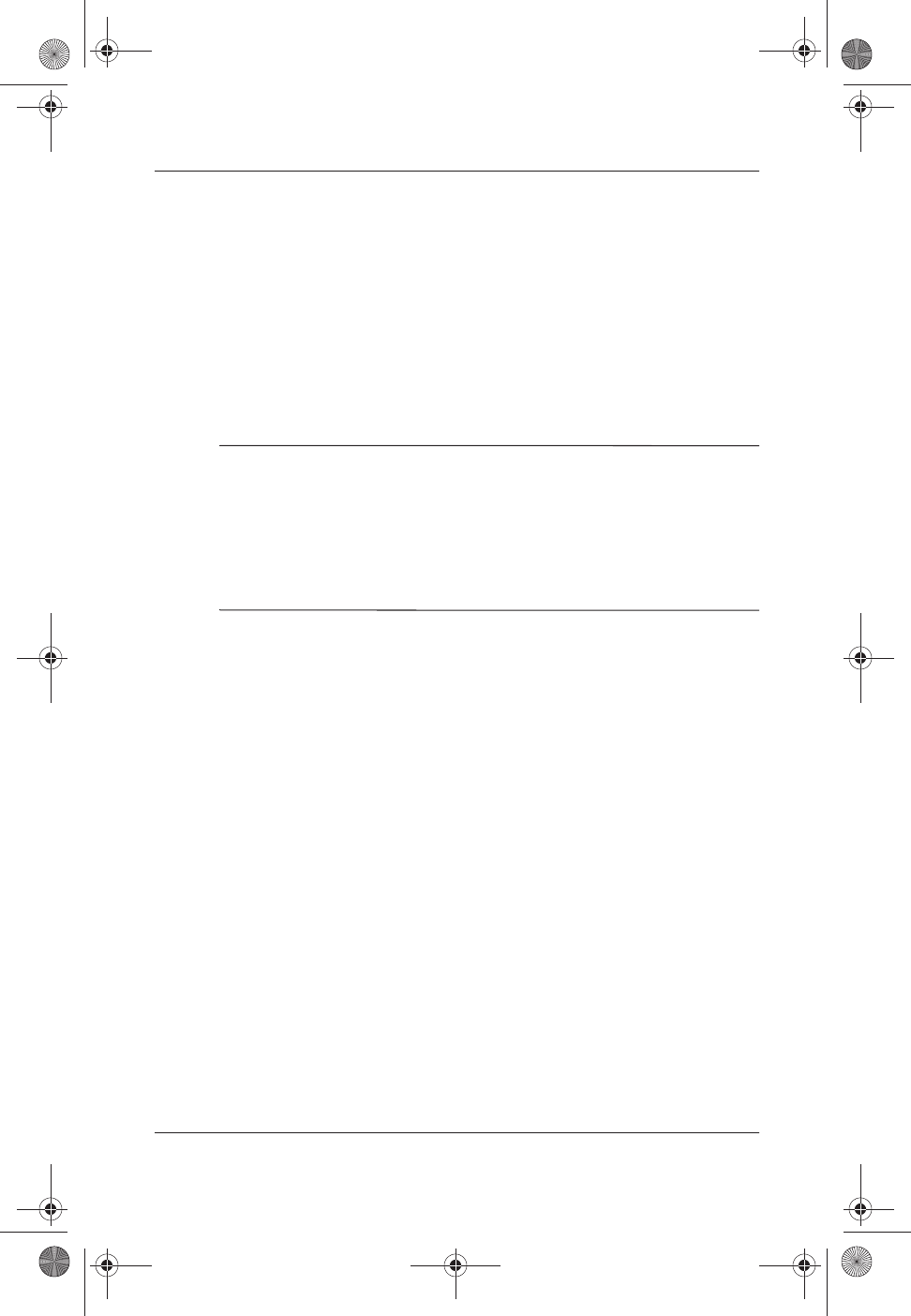
Beginning to Use the Notebook
Getting Started 2–3
Installing Optional Software
Step-by-step instructions for installing and using many of the
applications and utilities included with the notebook are provided
on the Documentation Library CD included with the notebook.
Instructions for using the CD are provided next in this chapter.
If you prefer to install optional software now, without referring to
the Documentation Library CD, the following information may
be helpful:
ÄCAUTION: To prevent file corruption and ensure that the correct drivers
are installed, install software only when the notebook is connected to
external power through the AC adapter or a DC cable. (Do not install
software while the notebook is running on battery power.) During the
installation:
■Do not unplug the notebook from external power.
■Do not shut down the notebook.
■To install an application or a utility from a CD, refer to
the documentation included with the CD. Typically,
installation instructions are included in the CD package or
are displayed on the screen when the CD is inserted.
■To access preloaded utilities and applications, select
Start > All Programs > Software Setup. Then:
❏To display the descriptions and space requirements of a
preloaded utility or application without installing it,
select the Next button, then select an item. (A description
and the space requirements of the item are displayed in
the Select Components window.) After viewing the
information, select the Cancel button.
❏To install a preloaded utility or application, select the
item > Next button, then follow the instructions on
the screen.
307502-003.book Page 3 Tuesday, February 4, 2003 10:44 AM
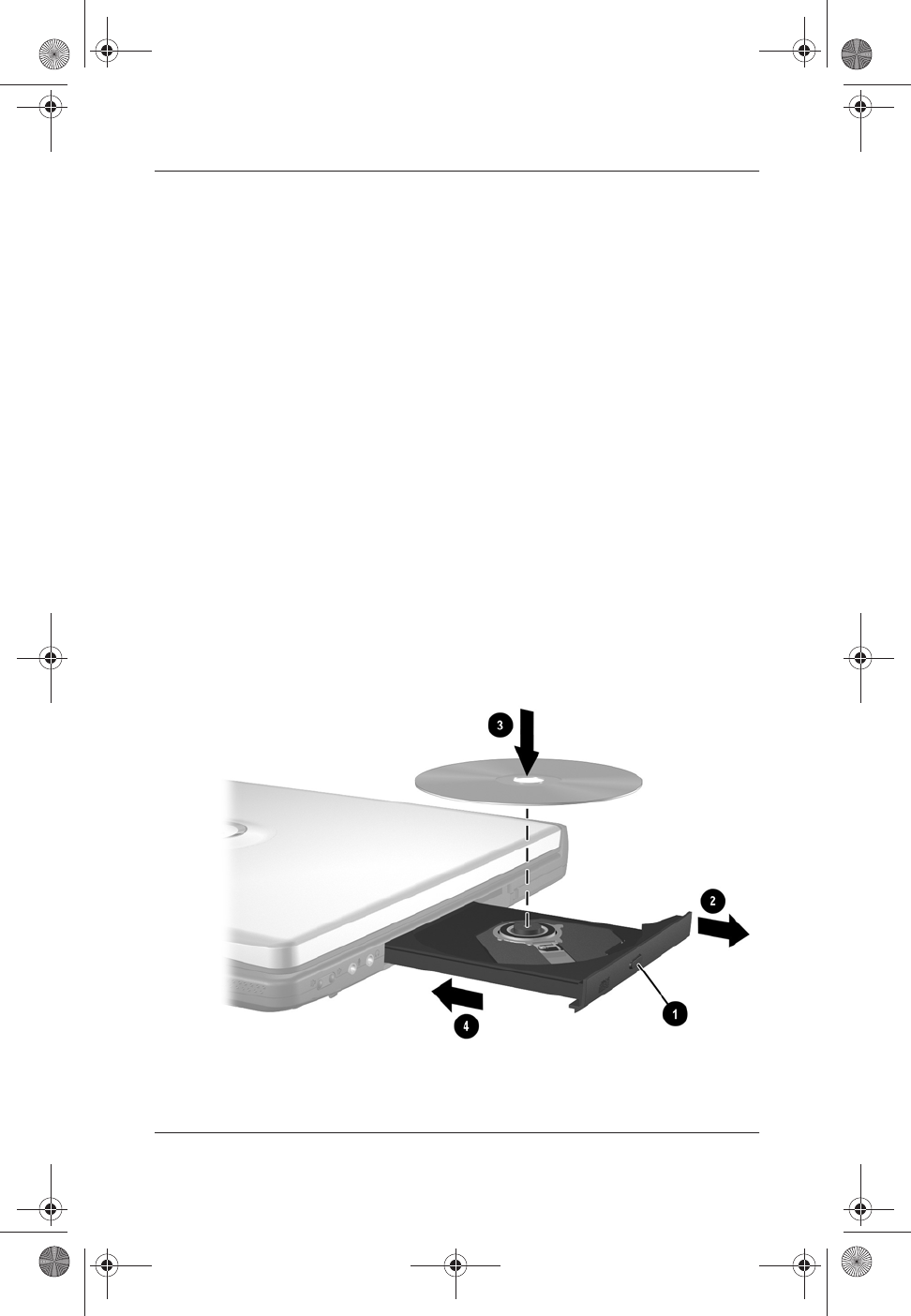
2–4 Getting Started
Beginning to Use the Notebook
Using the Documentation Library CD
The Documentation Library CD is included with all notebook
models.
Inserting the Documentation Library CD
To insert the Documentation Library CD into the optical drive:
1. Turn on the notebook.
2. Press the release button 1 on the drive bezel to release the
media tray, then pull the tray outward until it is fully
extended 2.
3. Position the CD over the tray, label side up.
4. Gently press the center of the disc onto the tray spindle 3
until the disc snaps into place. Handle the disc by the edges,
not the flat surfaces. (If the media tray is not fully extended,
tilt the disc to position it over the tray spindle, then press it
downward into position.)
5. Close the media tray 4.
Inserting the Documentation Library CD into an optical drive
307502-003.book Page 4 Tuesday, February 4, 2003 10:44 AM
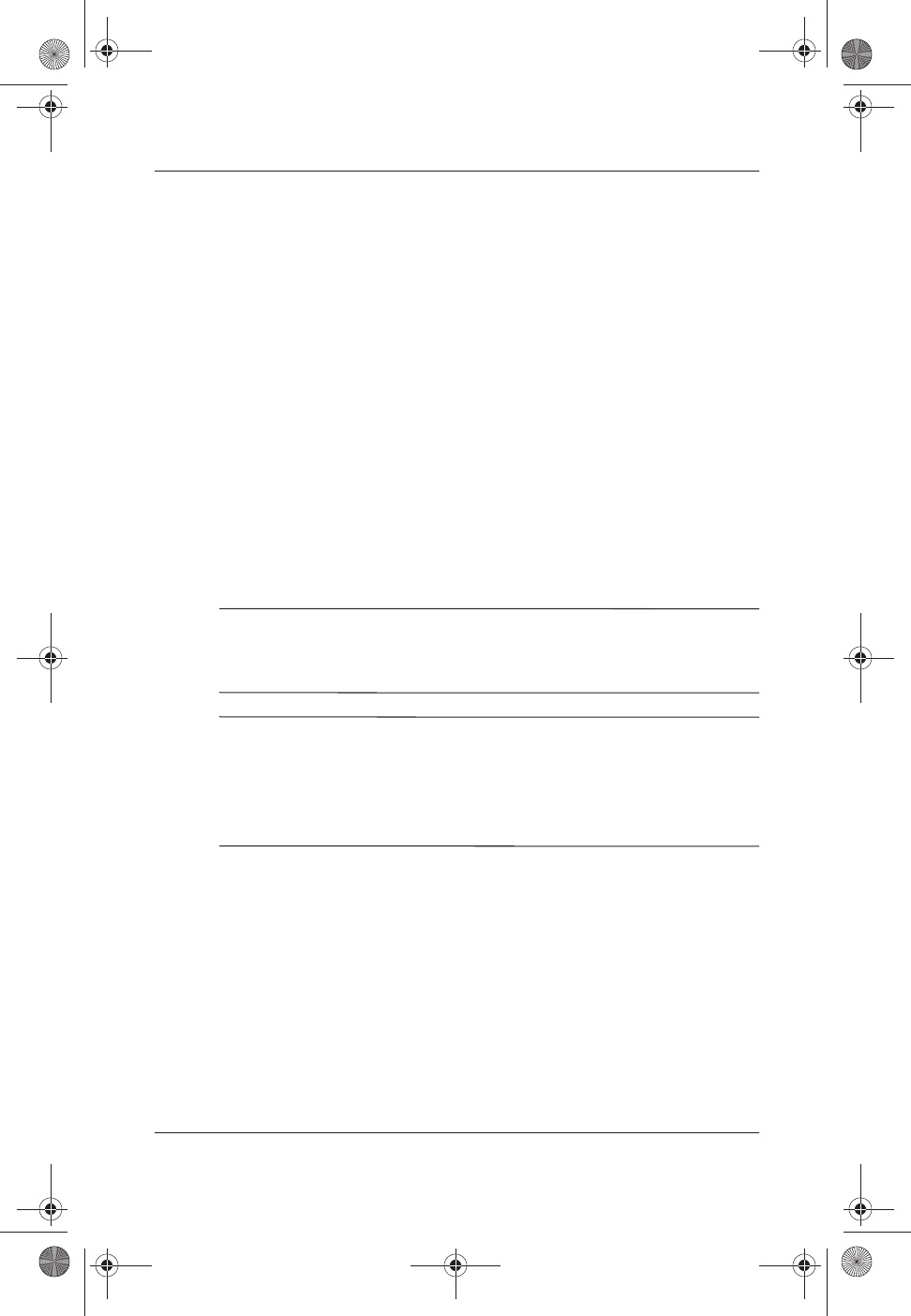
Beginning to Use the Notebook
Getting Started 2–5
Accessing the Documentation Library Menu
Typically, when the Documentation Library CD is inserted into
the optical drive, the CD menu is displayed on the screen after a
pause of up to several seconds.
If the menu is not displayed, for example, if AutoPlay is disabled,
you can display the menu manually:
1. Select Start > Run.
2. In the Open field, type:
explorer x:
(where X is your optical drive designation).
3. Select the file that includes an .exe extension, for example,
Filename.exe.
4. Select the OK button.
✎To display the drive designation of your optical drive, select
Start > My Computer. A drive designation is a letter of the
alphabet that the notebook uses to identify a drive.
✎If messages about Adobe Acrobat Reader are displayed on the
screen as you open the Documentation Library CD, choose to
install Acrobat Reader and to accept the Acrobat Reader license
agreement. Acrobat Reader is an application that displays the
notebook documentation on the screen.
307502-003.book Page 5 Tuesday, February 4, 2003 10:44 AM
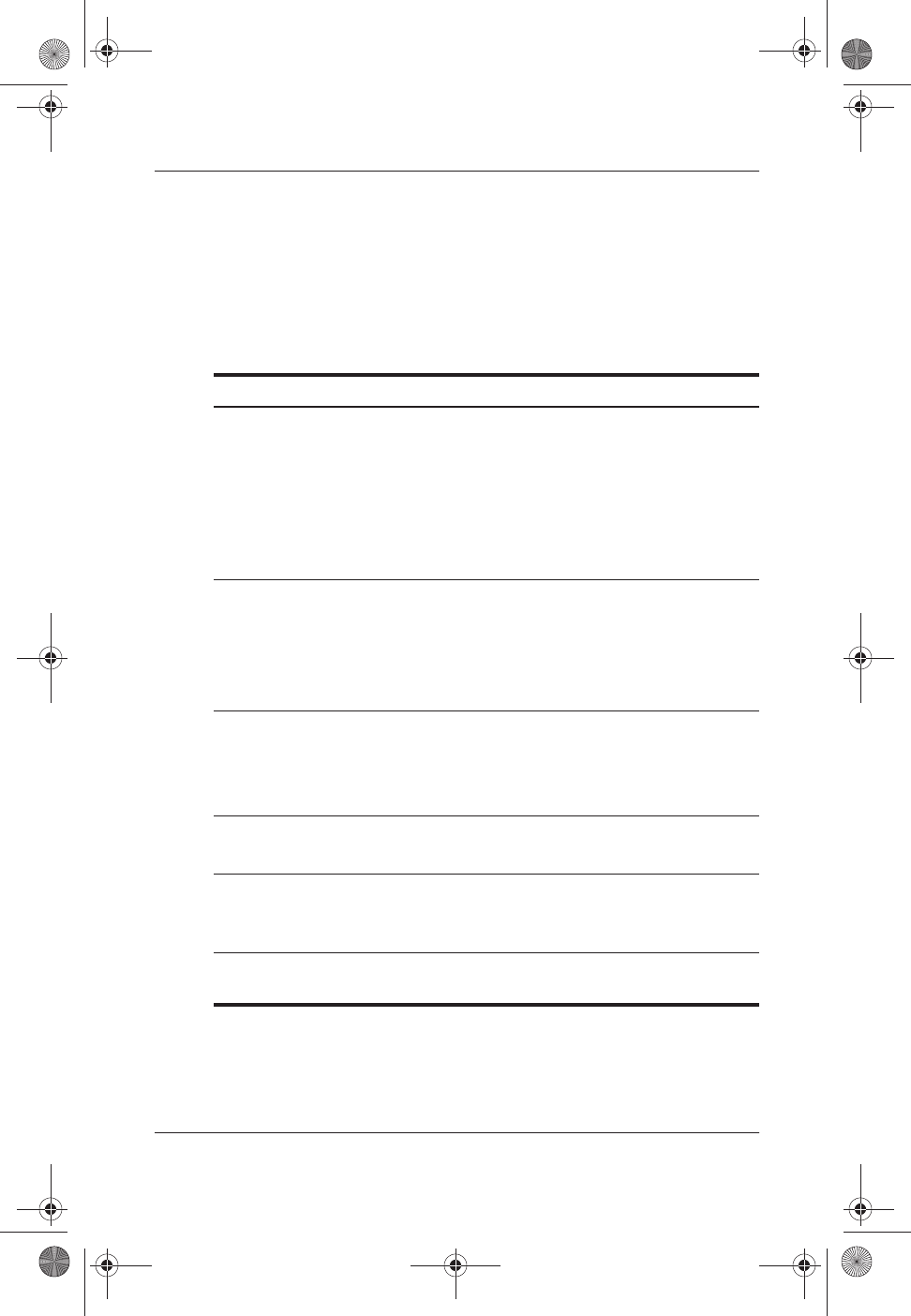
2–6 Getting Started
Beginning to Use the Notebook
Selecting a Guide
This section describes the guides on the Documentation Library
CD and suggests ways to quickly find a topic within a guide.
For information about using documentation symbols, text styles,
and paths, see the Preface, “Using This Guide.”
For Information About These Topics Select This Guide
■Using the external hardware features
identified in Chapter 3 of this guide
■Running the notebook on a
battery pack
■Upgrading memory
■Power and environmental
specifications
Hardware Guide
■Using Standby and Hibernation and
selecting power preferences
■Using CD and DVD software
■
Updating or restoring Compaq software
■Using the Setup and Support utilities
Software Guide
■Caring for the notebook and drives
■Preparing the notebook for transport
■Traveling with the notebook
internationally
Maintenance, Shipping
and Travel
■Solving notebook problems yourself
■Getting help from Compaq
Troubleshooting
■Governmental and safety information
■Protecting the notebook from static
electricity
Regulatory and Safety
Notices
Ergonomic and safety information
Safety & Comfort
Guide
Continued
307502-003.book Page 6 Tuesday, February 4, 2003 10:44 AM
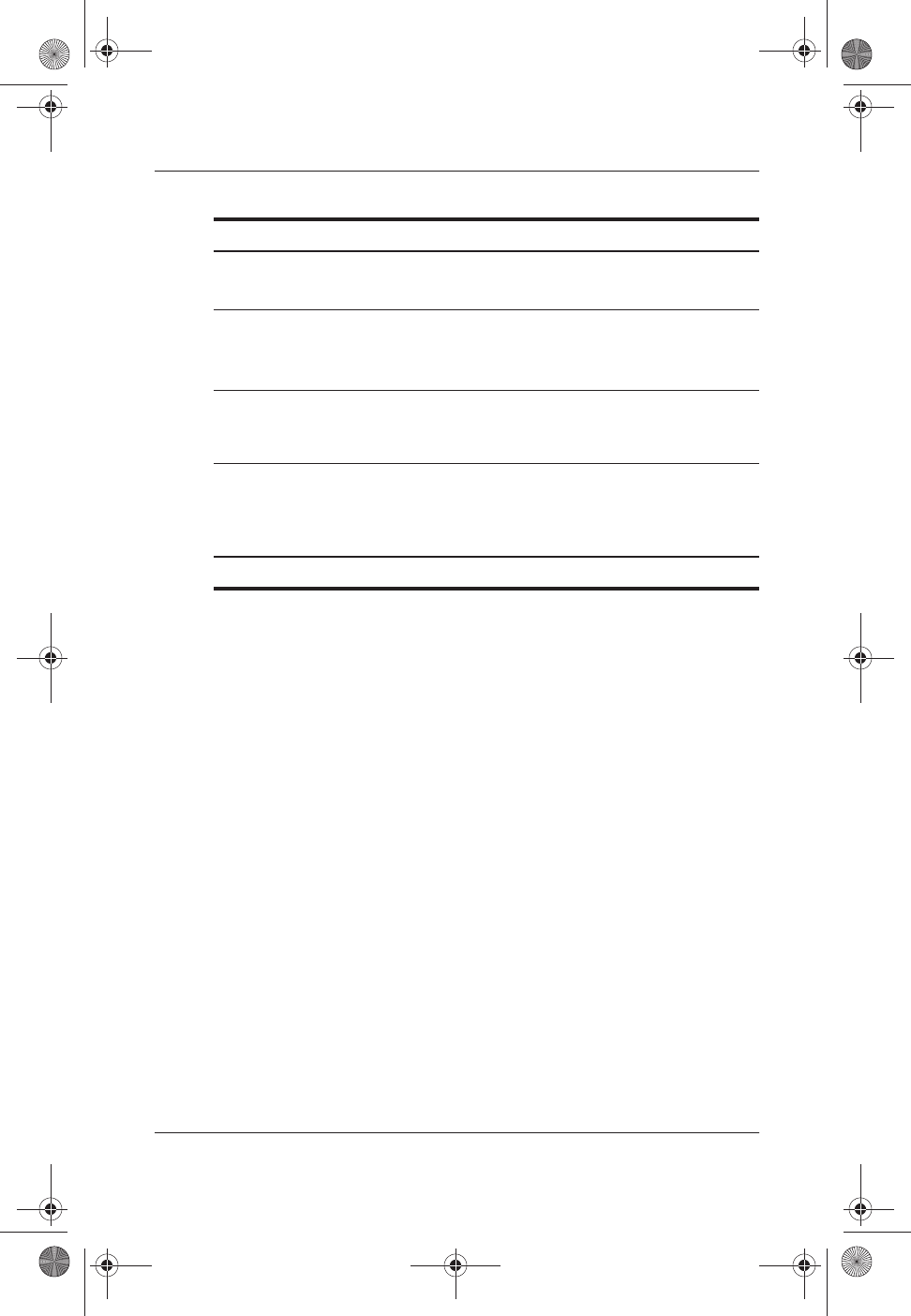
Beginning to Use the Notebook
Getting Started 2–7
Finding a Topic Within a Guide
To find information within a guide:
■Use the bookmarks or search features in Acrobat Reader.
❏Select any plus sign (+) in the left pane of the Acrobat
Reader window to display subheadings.
❏Select Edit > Find or Edit > Search to search quickly for a
topic. Select the Help button for additional information
about Acrobat Reader search, navigation, and print
procedures.
■Use the Index in the guide.
❏Indexes list specific items under generic headings, such
as “button,” or “jack,” that may be helpful if you do not
know the name of an item.
❏Index listings direct you to the first page of a topic. You
may find more information about the topic by scrolling
through a few of the pages that follow.
■Using an internal modem
■Using a network connection
Modem and
Networking
■Using modem AT commands
■Selecting a command set for your
notebook
Modem Command
Guidelines (Advanced
Users Only)
Using AT commands with a Conexant
modem
Conexant Command
Set (Advanced
Users Only)*
Using AT commands with a Lucent/Agere
modem
Lucent/Agere
Command Set
(Advanced
Users Only)*
*Available in English only.
For Information About These Topics Select This Guide
307502-003.book Page 7 Tuesday, February 4, 2003 10:44 AM
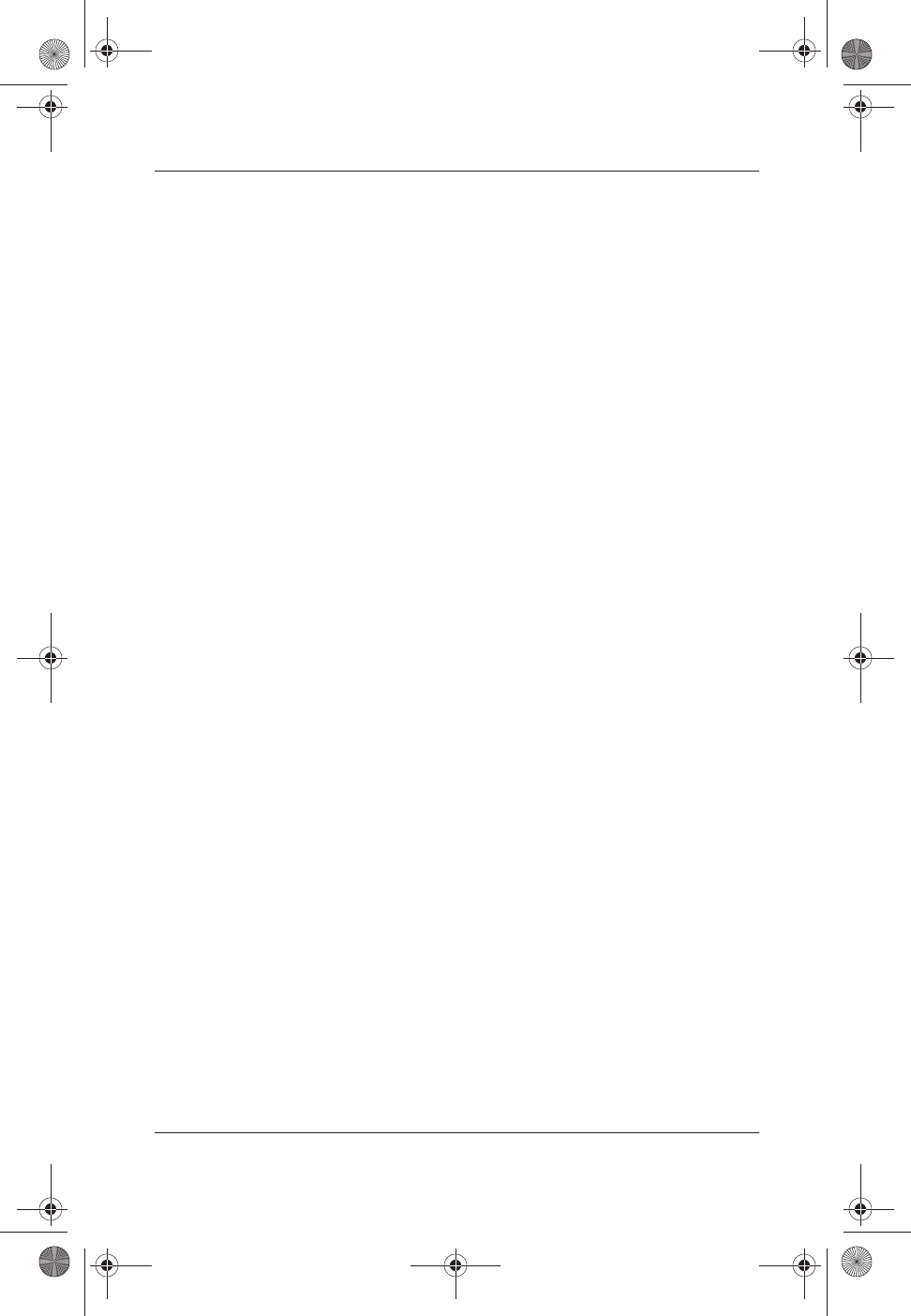
2–8 Getting Started
Beginning to Use the Notebook
Contacting Compaq
If you encounter a notebook problem that you cannot resolve with
the information provided, you may need to contact Compaq.
Using Compaq Help and Support
To access Compaq Help and Support, select Start > Help and
Support, then select a link. Links to support features within the
notebook and to specific areas of the Compaq Web site are
provided.
Obtaining Support Telephone Numbers
To obtain a list of worldwide Technical Support telephone
numbers, use either of the following methods:
■Select Start > Control Panel > Performance and Maintenance
icon > System icon. Then, near the lower edge of the System
Properties window, select the Support Information button.
■Refer to the printed Worldwide Telephone Numbers booklet
included with the notebook in English only.
307502-003.book Page 8 Tuesday, February 4, 2003 10:44 AM
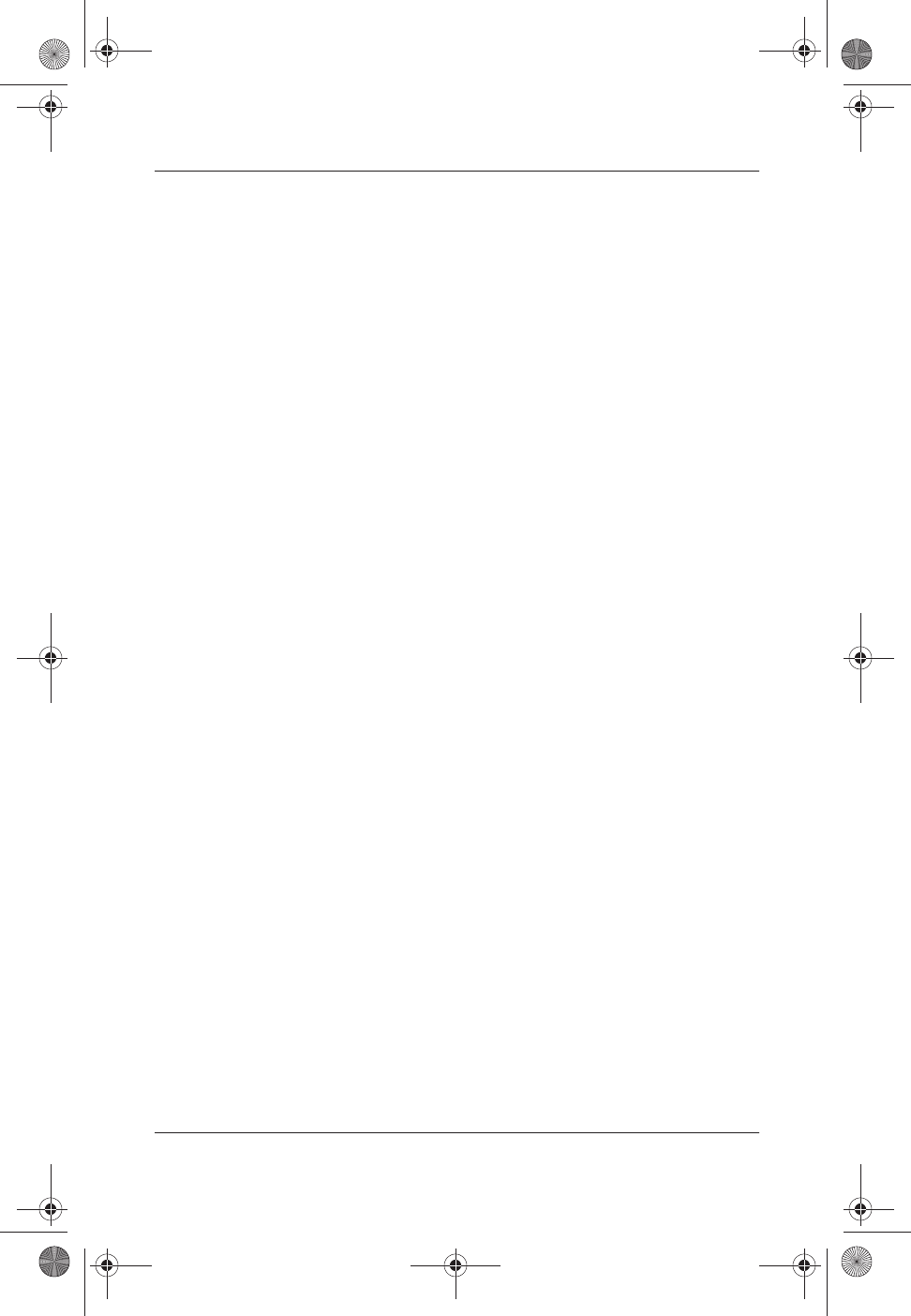
Beginning to Use the Notebook
Getting Started 2–9
Preparing to Call Technical Support
To provide the fastest possible resolution of your problem, have
the notebook and the following information available when
you call:
■Serial number, model number, and model description, which
are provided on the product identification label on the
underside of the notebook.
■Purchase date on the invoice.
■Conditions under which the problem occurred.
■Error messages that have been displayed.
■Operating system version number and registration number.
To display the operating system version number and
registration number, select Start > Control Panel > Performance
and Maintenance icon > System icon > General tab.
■Brand and model of an optional printer.
Taking the Notebook to a Service Provider
In addition to providing the information listed in the preceding
section, “Preparing to Call Technical Support,” be sure to delete
all passwords or to disclose all passwords to the service provider.
307502-003.book Page 9 Tuesday, February 4, 2003 10:44 AM
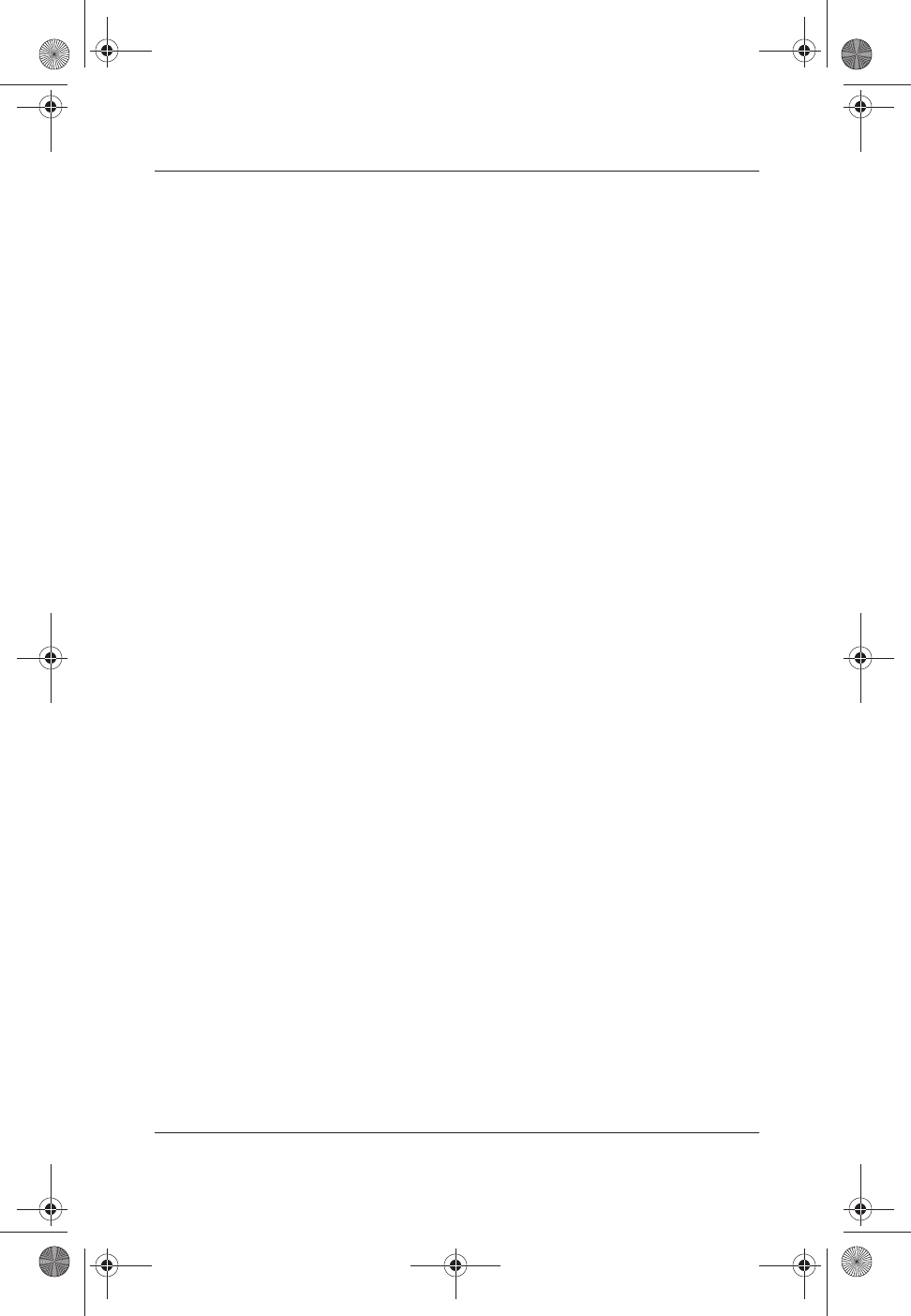
2–10 Getting Started
Beginning to Use the Notebook
307502-003.book Page 10 Tuesday, February 4, 2003 10:44 AM
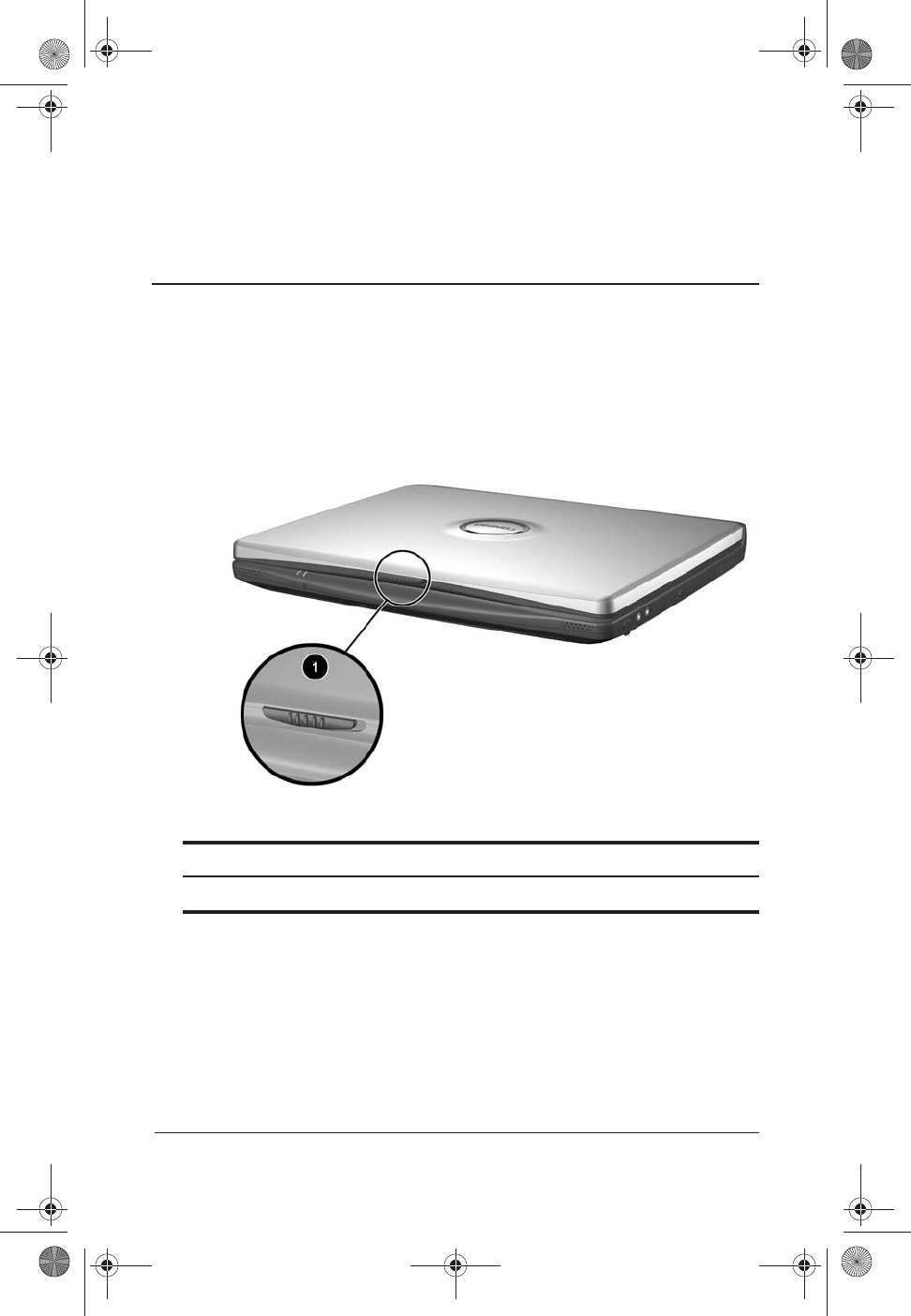
Getting Started 3–1
3
Hardware Components
Display
Display
1Display release latch Opens the notebook.
307502-003.book Page 1 Tuesday, February 4, 2003 10:44 AM
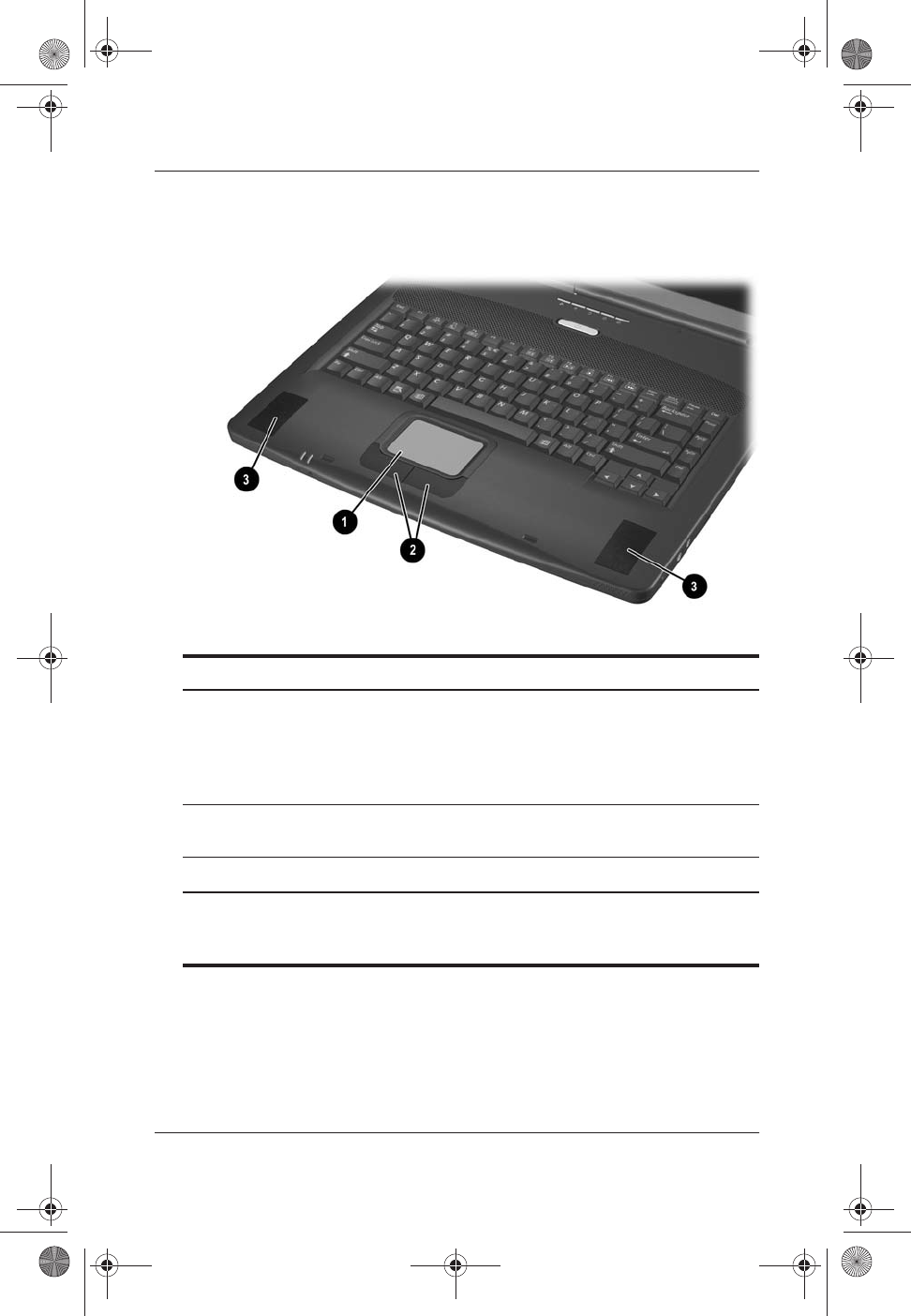
3–2 Getting Started
Hardware Components
Pointing Device and Speakers
Pointing Device and Speakers
1TouchPad* Moves the pointer and selects or
activates items on the screen. Can be
set to perform additional mouse
functions, such as scrolling, selecting,
and double-clicking.
2Left and right TouchPad
buttons*
Function like the left and right buttons
on an external mouse.
3Stereo speakers (2) Produce stereo sound.
*This table describes default settings. For information about changing
pointing device functions, refer on the
Documentation Library CD
to the
Hardware Guide,
“Pointing Device and Keyboard” chapter.
307502-003.book Page 2 Tuesday, February 4, 2003 10:44 AM
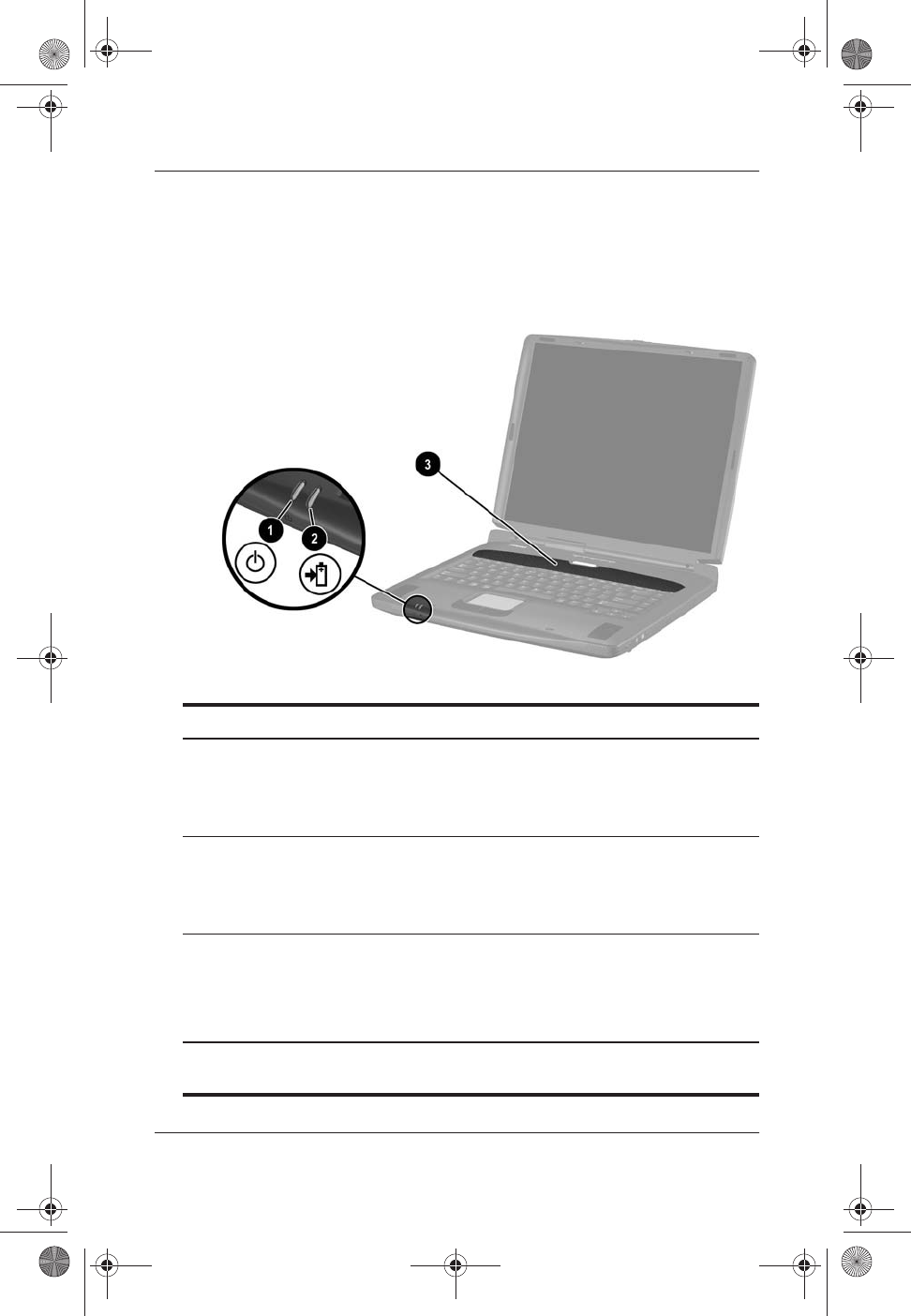
Hardware Components
Getting Started 3–3
Top
Power/Standby Light, Battery Light and Vent
Top: Power/Standby Light, Battery Light, and Vent
1Power/standby light On: Power is turned on.
Flashing: Notebook is in Standby or
has reached a critical low-battery
condition.
2Battery light On: A battery pack is charging.
Flashing: A battery pack which is the
only available power source has
reached a low-battery condition.
3Vent* Provides airflow to cool internal
components.
ÄTo prevent overheating, do
not obstruct vents.
*The notebook has 3 vents. The other vents are on the rear panel and the
underside of the notebook.
307502-003.book Page 3 Tuesday, February 4, 2003 10:44 AM
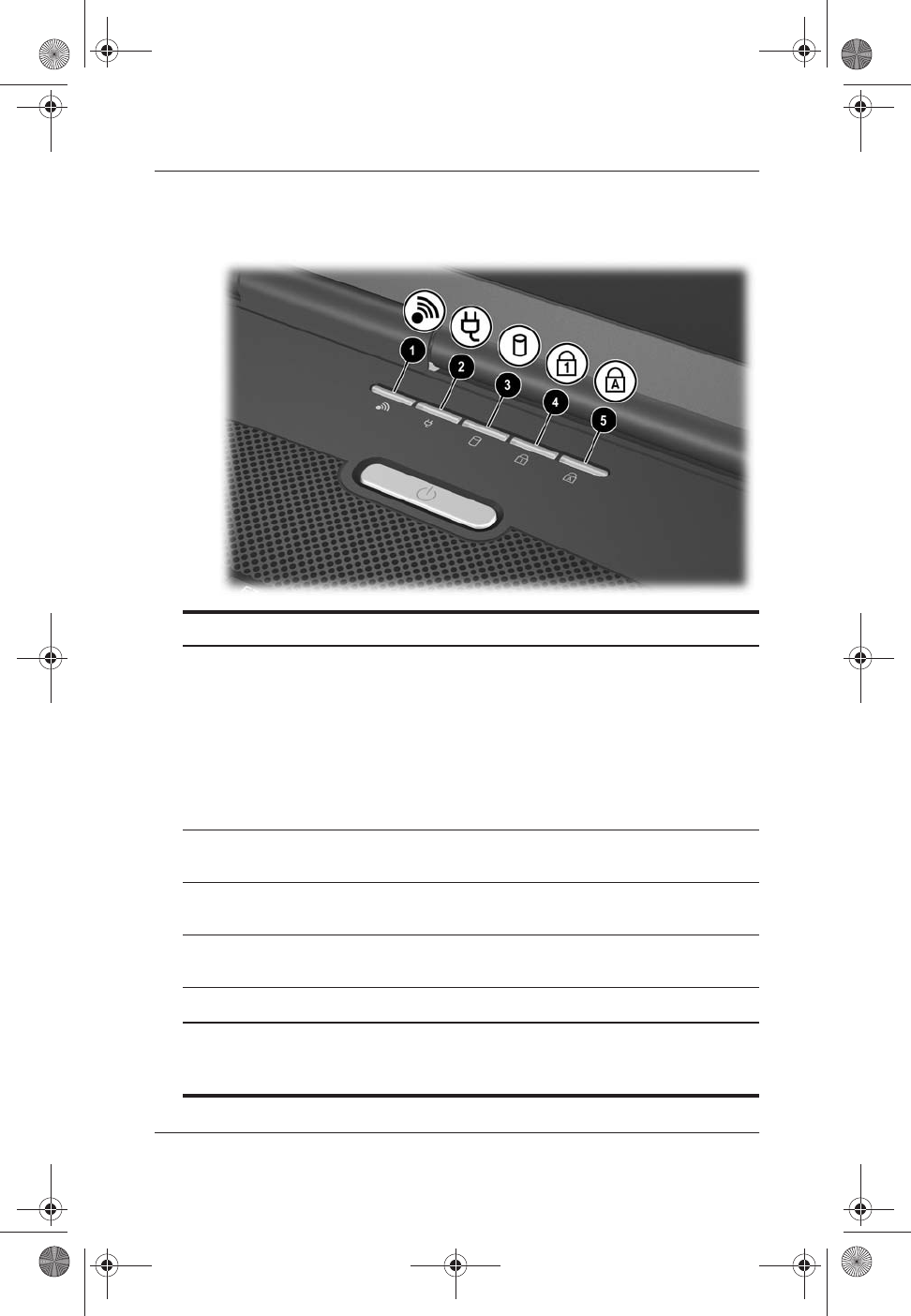
3–4 Getting Started
Hardware Components
Panel Lights
Top: Panel Lights
1Wireless LAN activity light Off: An optional internal wireless LAN
is off or not installed.
On: An optional internal wireless LAN
is on and connected to a network.
Flashing: An optional internal
wireless LAN is on, but is not
connected to a network or properly
configured.
2AC adapter light On: AC power is being supplied
through an AC adapter.
3IDE (Integrated Drive
Electronics) drive light
On: The internal hard drive or optical
drive is being accessed.
4Num lock light On: Num lock or the internal keypad
is on.*
5Caps lock light On: Caps lock is on.
*For information about using the internal keypad, refer on the
Documentation Library CD
to the
Hardware Guide,
“Pointing Device and
Keyboard” chapter.
307502-003.book Page 4 Tuesday, February 4, 2003 10:44 AM
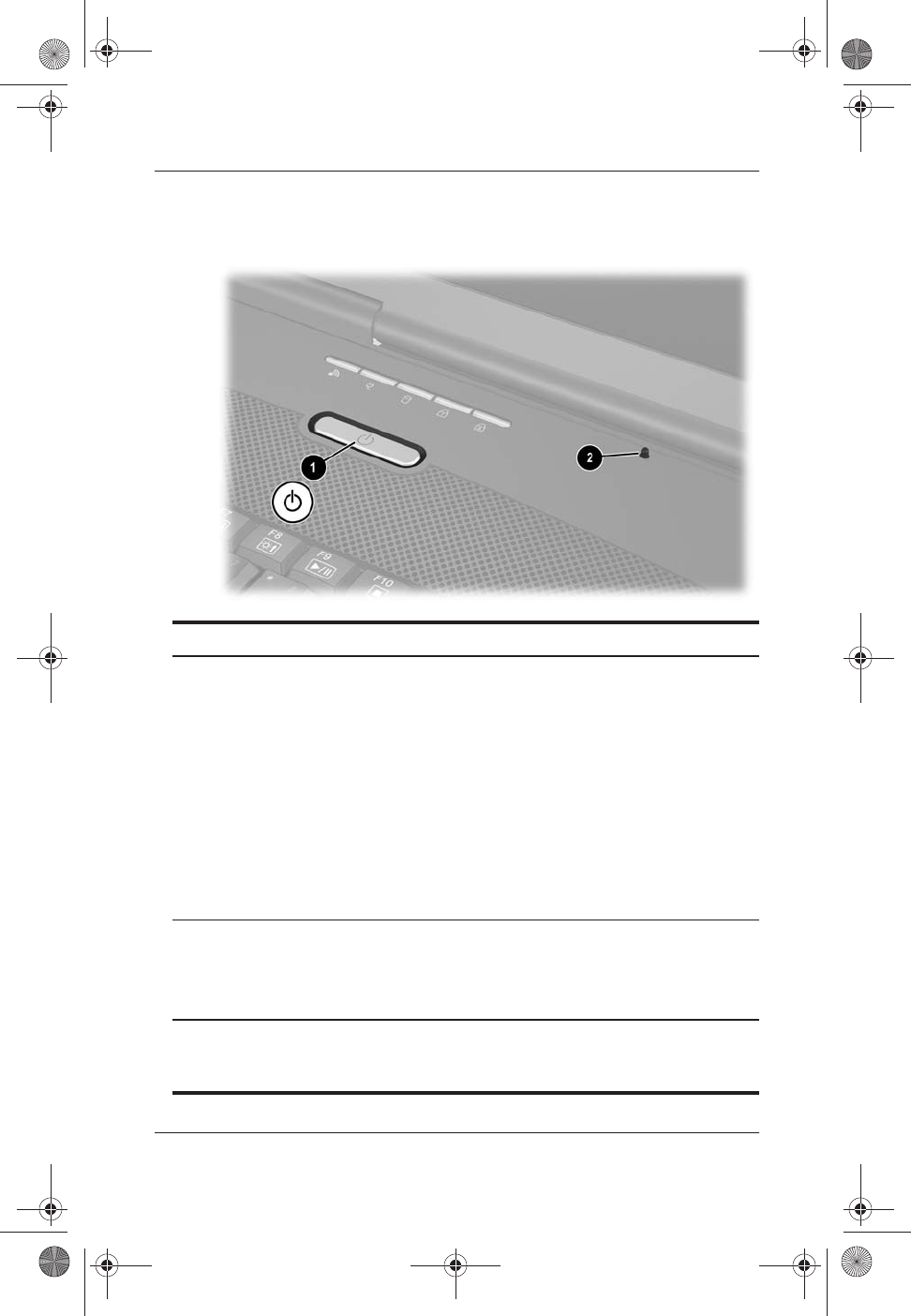
Hardware Components
Getting Started 3–5
Power Controls
Top: Power Controls
1Power button* When the notebook is:
■Off, press to turn on the notebook.
■On, briefly press to initiate Hibernation.
■In Standby, briefly press to resume from
Standby.
■In Hibernation, briefly press to resume from
Hibernation.
✎If the system has stopped responding and
Windows shutdown procedures cannot be
used, press and hold for at least 5 seconds
to turn off the notebook.
2Display
switch*
■If the notebook is closed while on, turns off the
display.
■If the notebook is opened while in Standby, turns
on the notebook (resumes from Standby).
*This table describes default settings. For information about changing the
function of the power button or display switch, refer on the
Documentation
Library
CD to the
Software Guide,
“Power” chapter.
307502-003.book Page 5 Tuesday, February 4, 2003 10:44 AM
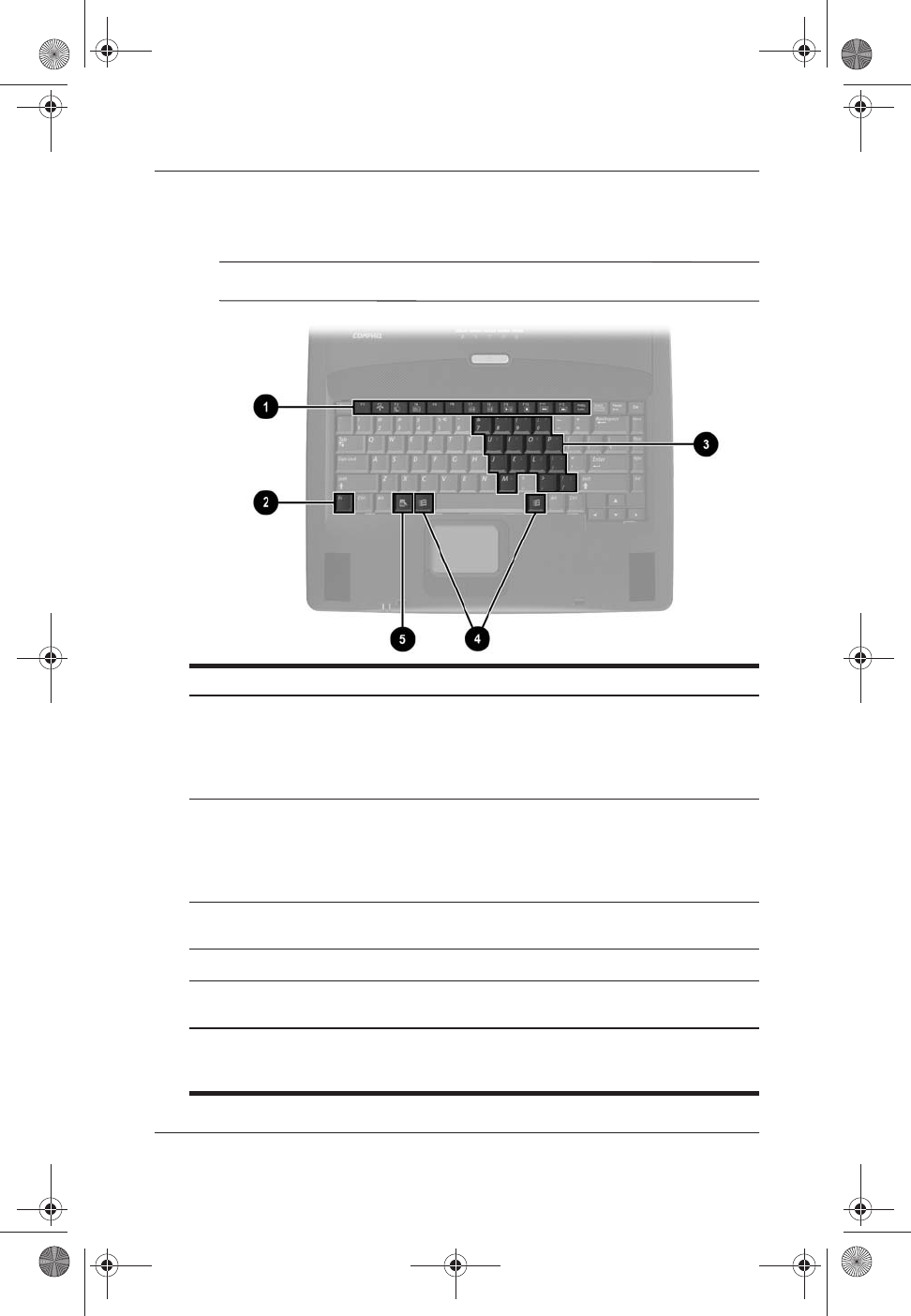
3–6 Getting Started
Hardware Components
Keys
✎Key availability and location varies by region and model.
Top: Keys
1Function keys (12) Perform system and application tasks.
When combined with the Fn key, the
function keys F2 through F4 and F7
through F12 perform additional tasks as
hotkeys.*
2Fn key Combines with other keys to perform
system tasks. For example, pressing
Fn+F7 decreases screen brightness and
pressing Fn+F8 increases screen
brightness.
3Keypad keys (15)* Can be used like the keys on an external
numeric keypad.
4Microsoft logo keys (2) Display the Windows Start menu.
5Applications key Displays a shortcut menu for items
beneath the pointer.
*For information about using hotkeys or keypad keys, refer on the
Documentation Library
CD to the
Hardware Guide,
“Pointing Device and
Keyboard” chapter.
307502-003.book Page 6 Tuesday, February 4, 2003 10:44 AM
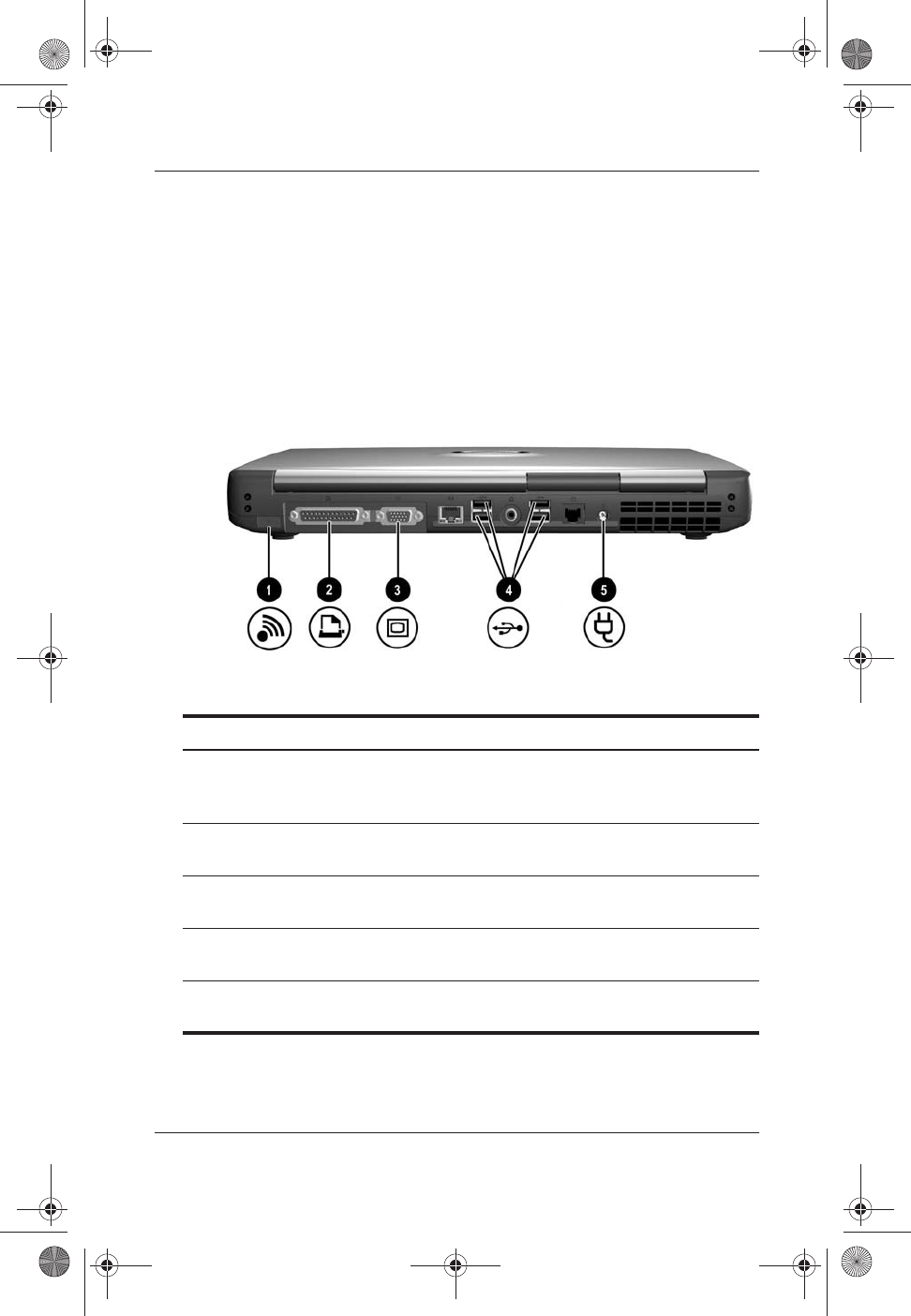
Hardware Components
Getting Started 3–7
Rear Panel
Connectors and Infrared Port
Rear Panel: Connectors and Infrared Port
1Infrared port (available on
select models)
Provides wireless communication
between the notebook and an
optional IrDA-compliant device.
2Parallel connector (available
on select models)
Connects an optional parallel device
such as a printer.
3External monitor connector Connects an optional VGA external
monitor or projector.
4USB connectors (4) Connect optional 2.0- or
1.1-compliant USB devices.
5AC power connector Connects an AC adapter or an
optional DC cable.
307502-003.book Page 7 Tuesday, February 4, 2003 10:44 AM
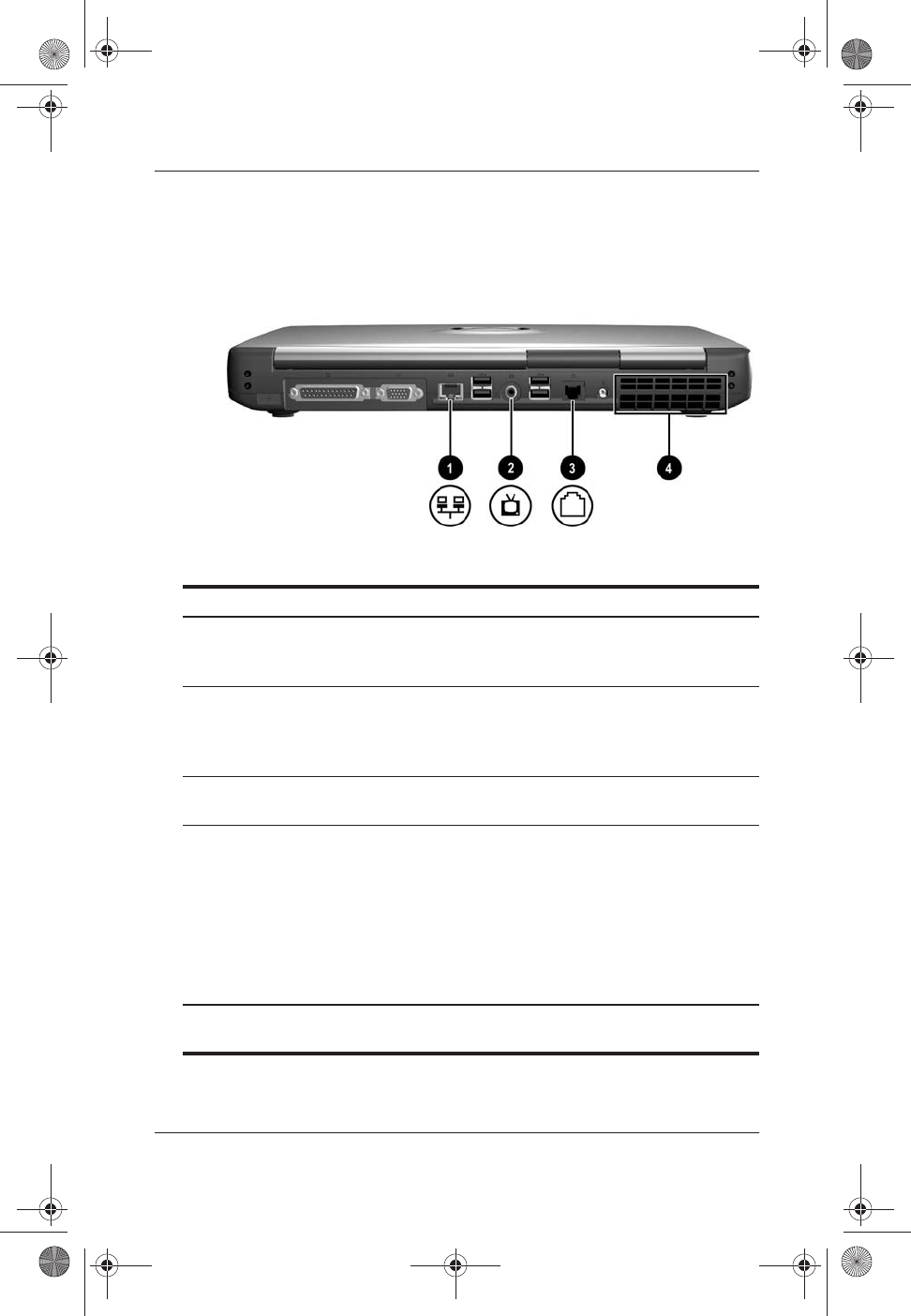
3–8 Getting Started
Hardware Components
Jacks, Fan and Vent
Rear Panel: Jacks, Fan, and Vent
1RJ-45 network jack
(available on select models)
Connects an Ethernet network cable.
(An Ethernet network cable is
included with select models.)
2Composite TV-out jack Connects an optional composite
video device, such as a television,
VCR, camcorder, projector, or video
capture card.
3RJ-11 telephone jack Connects a modem cable. (A modem
cable is included with select models.)
4Fan and vent* Provide airflow to cool internal
components.
ÄTo prevent overheating, do
not obstruct vents. Do not
allow a hard surface, such as
an adjoining printer, or a soft
surface, such as bedding or
clothing, to block airflow.
*The notebook has 3 vents. The other vents are above the keyboard and
on the underside of the notebook.
307502-003.book Page 8 Tuesday, February 4, 2003 10:44 AM
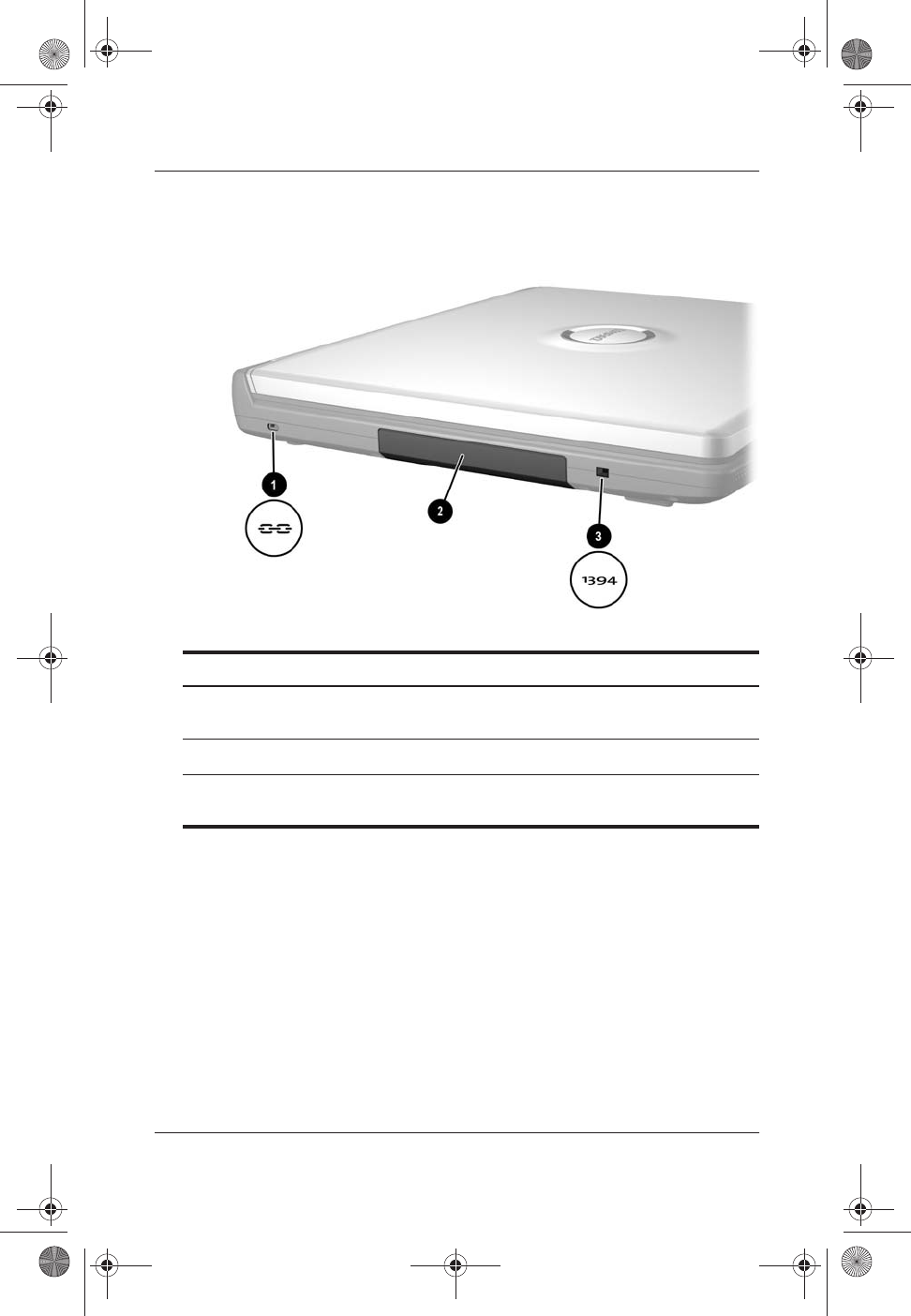
Hardware Components
Getting Started 3–9
Left Side
Left Side
1Security cable slot Attaches an optional security cable to
the notebook.
2Hard drive bay Holds the internal hard drive.
31394 connector (available on
select models)
Connects an optional 1394 device such
as a camcorder.
307502-003.book Page 9 Tuesday, February 4, 2003 10:44 AM
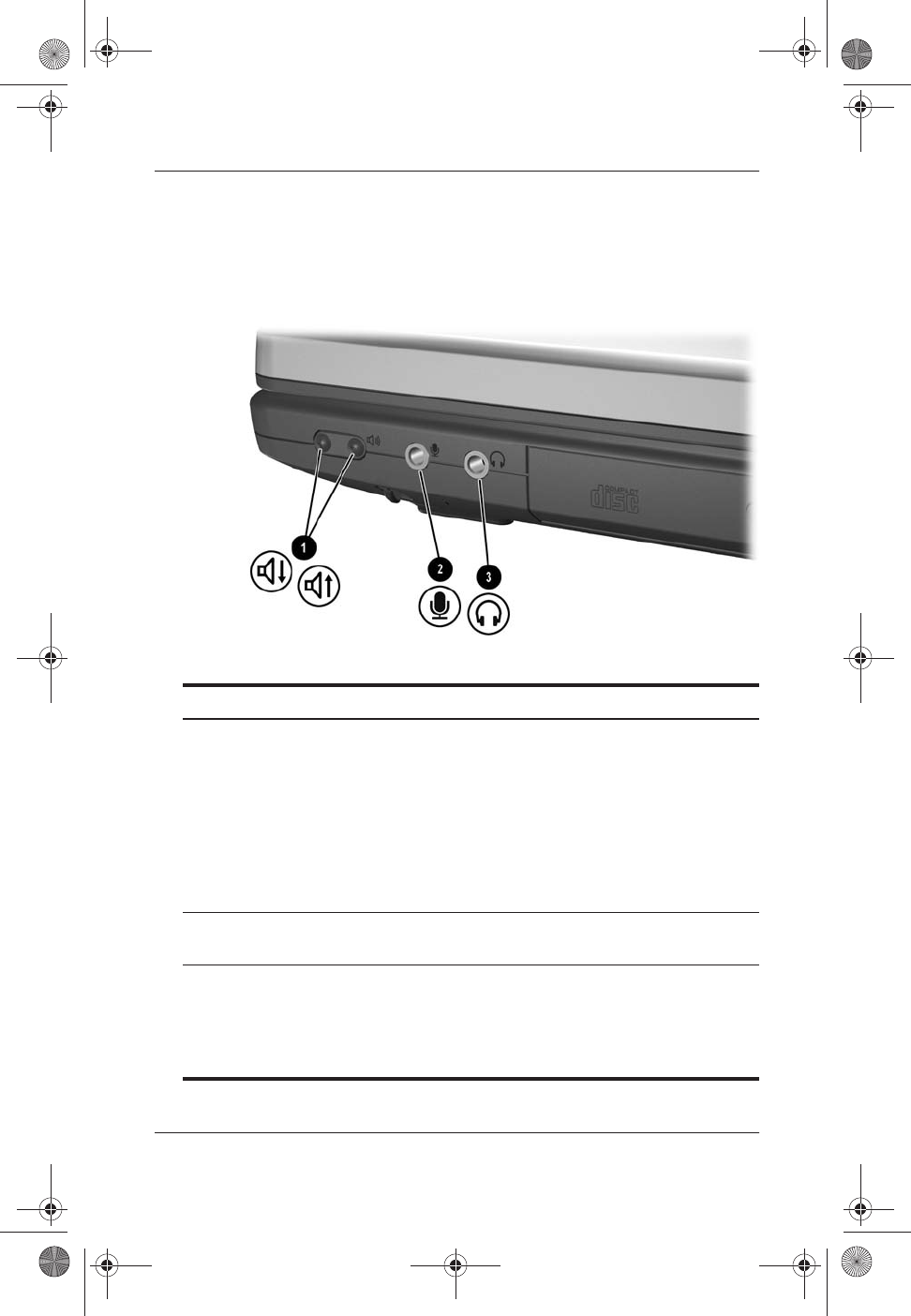
3–10 Getting Started
Hardware Components
Right Side
Volume Buttons and Audio Jacks
Right Side: Volume Buttons and Audio Jacks
1Volume buttons (2) Adjust, mute, or restore system
volume.
■To decrease volume, press the
decrease volume button.
■To increase volume, press the
increase volume button.
■To mute or restore volume, press
both buttons at the same time.
2Microphone jack Connects an optional monaural
microphone.
3Audio-out jack Connects optional headphones or
powered stereo speakers. Also
connects the audio function of an
audio/video device such as a
television or VCR.
307502-003.book Page 10 Tuesday, February 4, 2003 10:44 AM
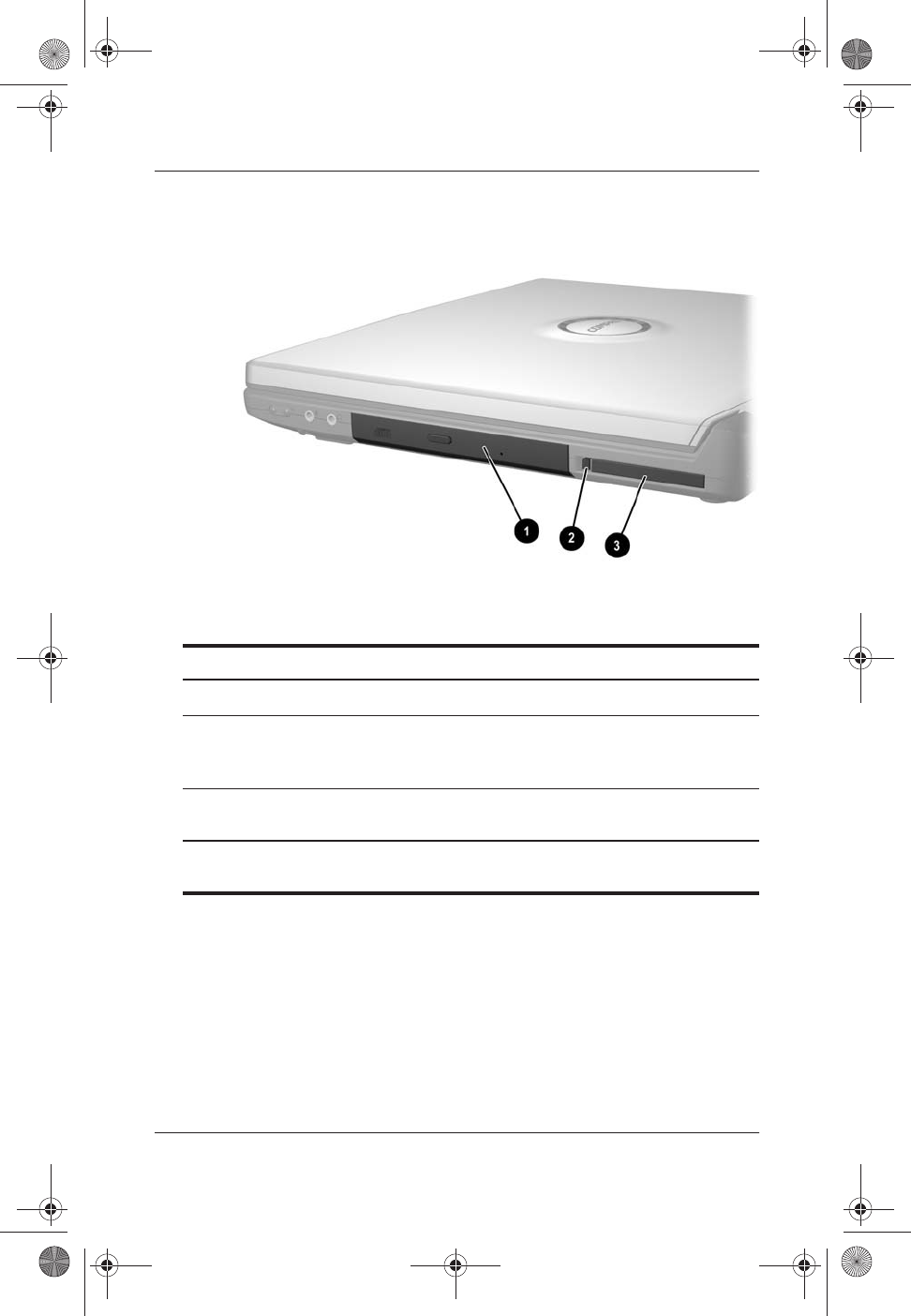
Hardware Components
Getting Started 3–11
Optical Drive and PC Card Slot
Right Side: Optical Drive and PC Card Slot
1Optical drive* Supports an optical disc.
2PC Card eject button
(available on models with a
PC Card slot)
Ejects an optional PC Card from the
PC Card slot.
3PC Card slot (available on
select models)
Supports an optional Type I or Type II
32-bit (CardBus) or 16-bit PC Card.
*The type of optical drive, for example a CD, DVD, or combination CD/DVD
drive, varies by model.
307502-003.book Page 11 Tuesday, February 4, 2003 10:44 AM

3–12 Getting Started
Hardware Components
Underside
Battery Bay and Hard Drive Bay
Underside: Battery Bay and Hard Drive Bay
1Battery bay* Holds a battery pack.
2Battery pack release latch* Releases a battery pack from the
battery bay.
3Battery pack locking latches (2)* Secure a battery pack in the
battery bay.
4Hard drive retaining screws (4) Secure the internal hard drive in
the hard drive bay.
*All models support a battery pack and include a battery bay, battery pack
release latch, 2 battery pack locking latches, and a battery light (The
battery light is illustrated earlier in this chapter). As shipped, the battery
bay is empty on models which include a battery pack. The battery bay on
models which do not include a battery pack contains a removable
stabilizer, which protects the battery bay.
307502-003.book Page 12 Tuesday, February 4, 2003 10:44 AM
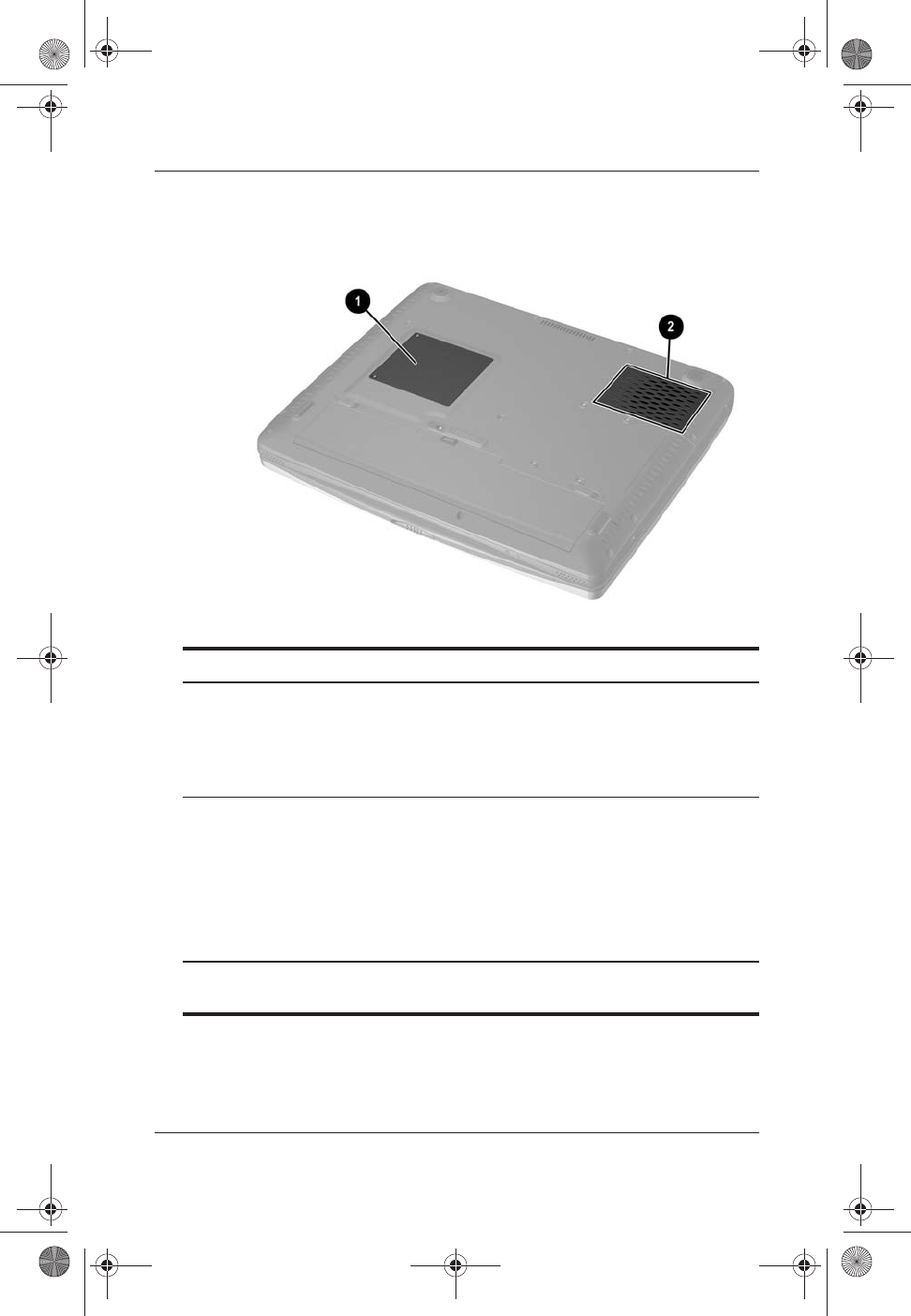
Hardware Components
Getting Started 3–13
Memory Compartment and Vent
Underside: Memory Compartment and Vent
1Memory compartment Contains 2 memory slots for
PC2100-compliant memory modules.
The memory compartment may
contain one or two memory modules,
depending on the notebook model.
2Vent* Allows airflow to cool internal
components.
ÄTo prevent overheating, do
not obstruct the vent. Do not
allow a soft surface, such as
bedding, clothing or a thick
rug, to block airflow.
*The notebook has 3 vents. The other vents are above the keyboard and
on the rear panel of the notebook.
307502-003.book Page 13 Tuesday, February 4, 2003 10:44 AM
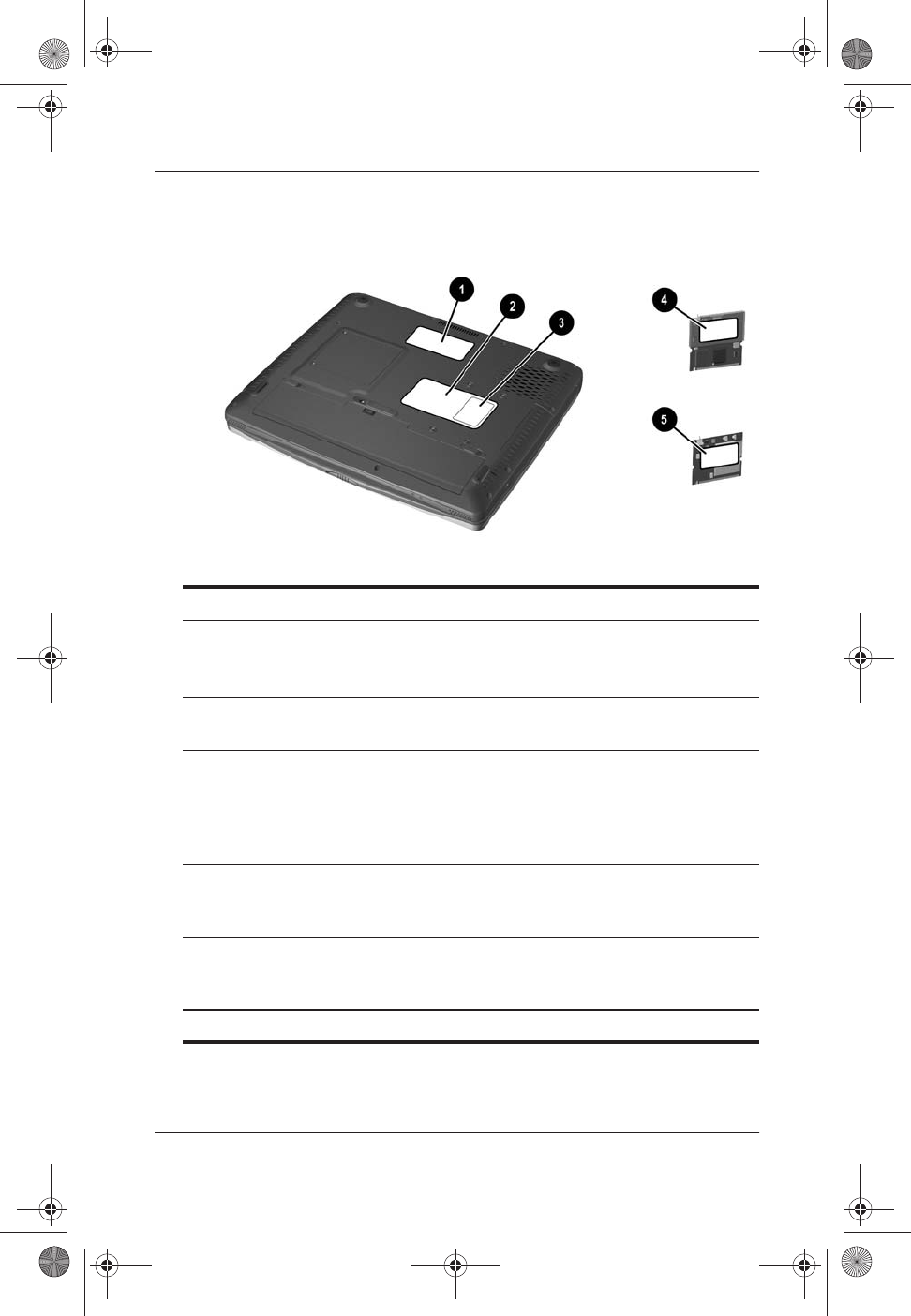
3–14 Getting Started
Hardware Components
Labels
Underside: Labels
1Microsoft Certificate of
Authenticity label*
Contains the Product Key number.
You may need this number to update
or troubleshoot the operating system.
2System label* Provides regulatory information about
the notebook.
3Product identification label* Contains the serial number of the
notebook and a code describing the
original configuration of the notebook.
You will need the serial number if you
call Compaq customer support.
4Modem approvals label (on
an optional internal
modem)*
Lists the countries in which a modem
has been approved for use.
5Wireless certification label
(on an optional internal
wireless device)*
Lists the countries in which a wireless
device has been approved for use.
*Label shapes and locations vary by region and model.
307502-003.book Page 14 Tuesday, February 4, 2003 10:44 AM
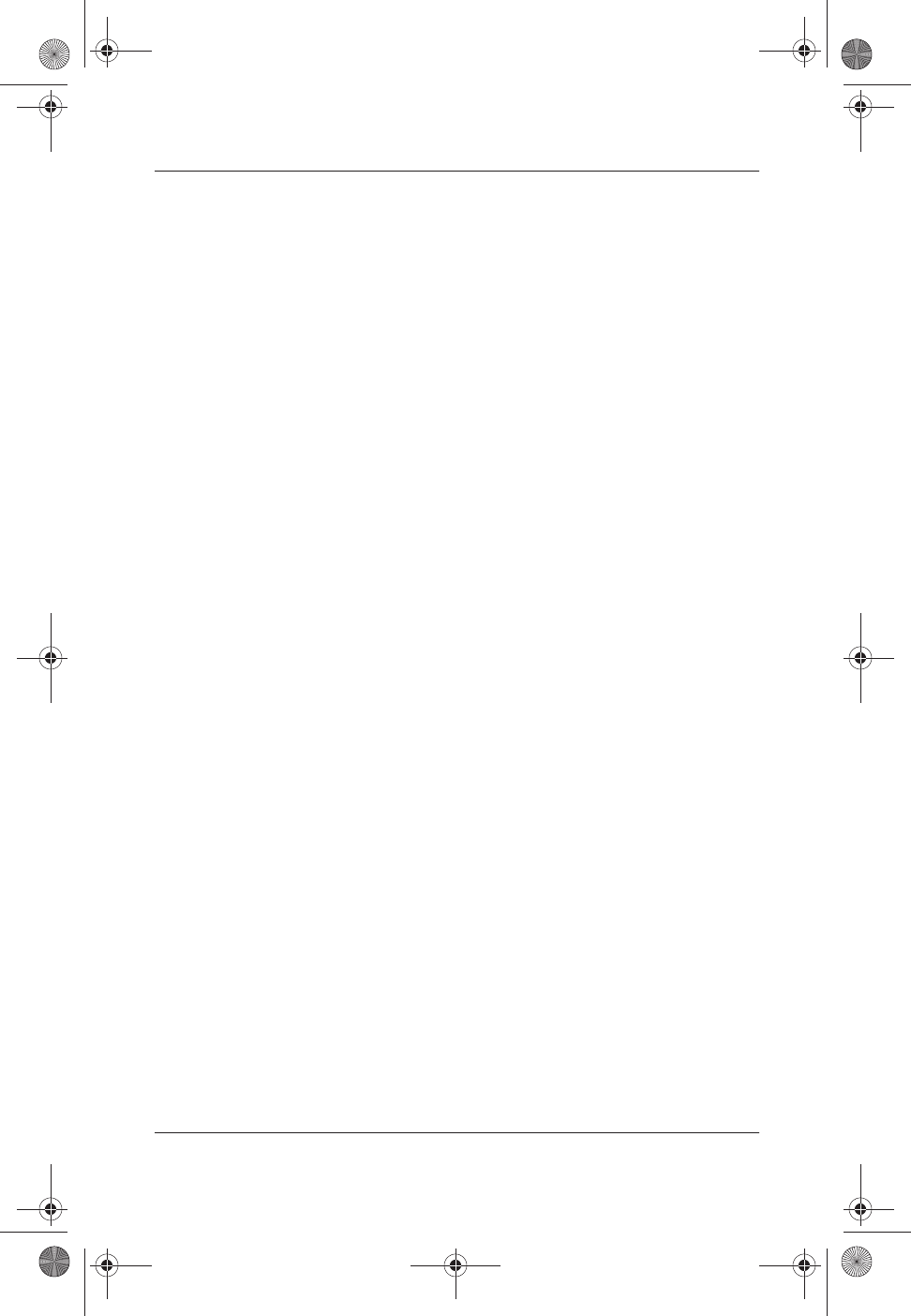
Hardware Components
Getting Started 3–15
Additional Standard Components
The components included with the notebook vary by region,
notebook model, and the optional hardware ordered. The
following sections identify the standard external accessories and
components included with most notebook models.
Software Restore and Documentation CDs
Your notebook includes the following CDs for restoring software
and accessing product documentation:
■ACompaq QuickRestore CD contains all the software
included in the factory image. Restoring from the CD
reformats the hard drive and returns the notebook to the
factory image. To restore one or more applications without
reformatting the hard drive, select Start > Software Setup,
then follow the instructions on the screen.
For more information about QuickRestore, refer on the
Documentation Library CD to the Software Guide, “Software
Updates and Restorations” chapter.
■The Documentation Library CD includes the following
guides:
❏Hardware Guide
❏Software Guide
❏Modem and Networking
❏Modem Command Guidelines (Advanced Users Only)
❏Lucent/Agere Command Set (Advanced Users Only)
❏Conexant Command Set (Advanced Users Only)
❏Maintenance, Shipping and Travel
❏Regulatory and Safety Notices
❏Safety & Comfort Guide
❏Troubleshooting
For information about using the Documentation Library CD,
see Chapter 2, “Beginning to Use the Notebook.”
307502-003.book Page 15 Tuesday, February 4, 2003 10:44 AM
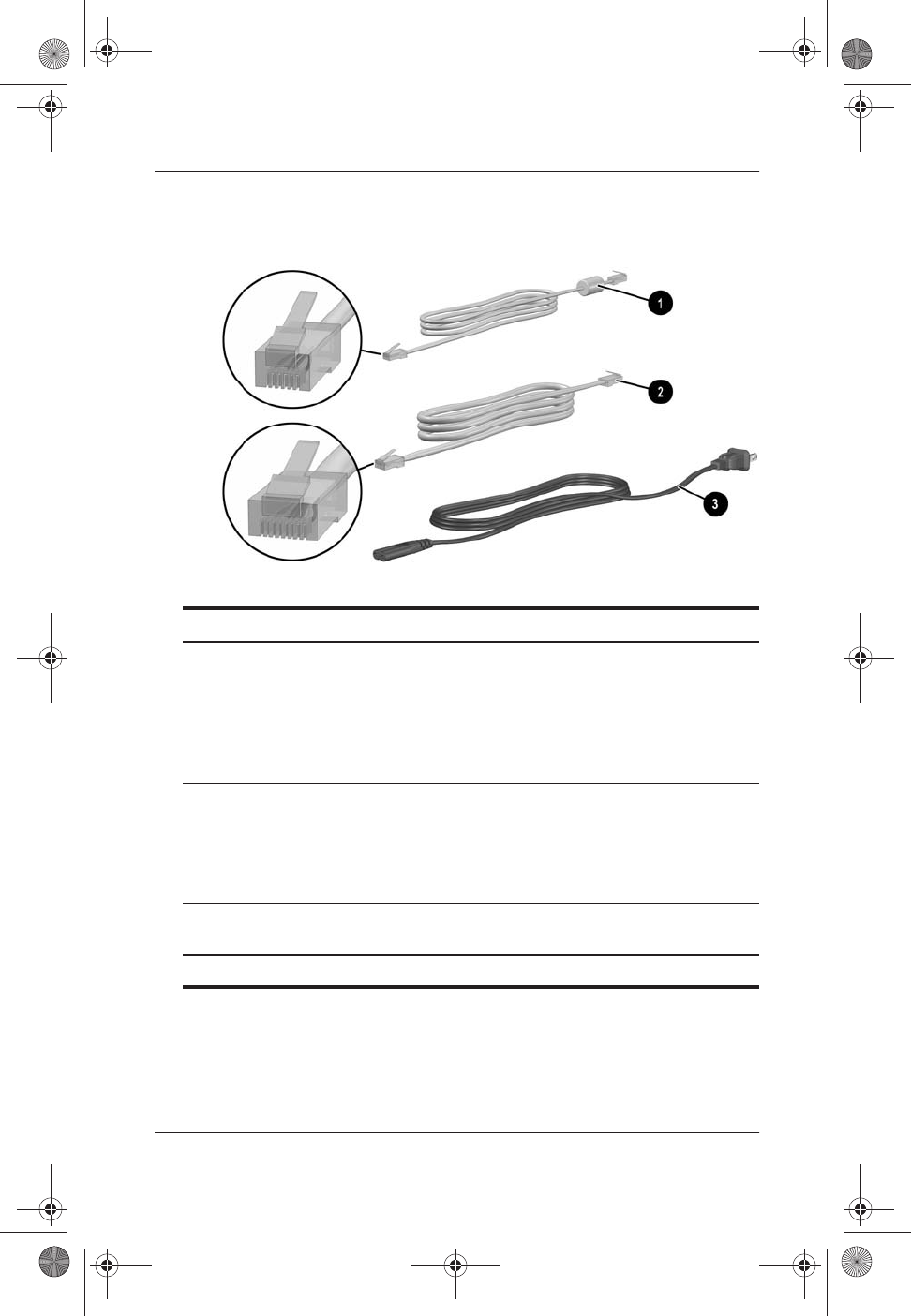
3–16 Getting Started
Hardware Components
Cables and Cord
Additional Standard Components: Cables and Cord
1Modem cable (included with
select models)
Connects a modem to an
RJ-11 telephone jack or to a
country-specific modem adapter.
✎A modem cable has a 6-pin,
RJ-11 telephone connector
at each end.
2Network cable (included
with select models)
Connects the notebook to an
Ethernet network jack.
✎A network cable has an 8-pin,
RJ-45 network connector at
each end.
3Power cord* Connects an AC adapter to an
AC electrical outlet.
*Power cords vary in appearance by region.
307502-003.book Page 16 Tuesday, February 4, 2003 10:44 AM

Hardware Components
Getting Started 3–17
Adapters and Battery Pack
Additional Standard Components: Adapters and Battery Pack
1AC adapter* Converts AC power to DC power.
2Country-specific modem
adapter (included by region
as required)
Adapts the modem cable to a
non-RJ-11 telephone jack.
3Japan-specific outlet
adapter (Japan only)
Connects the AC adapter to a
2-prong electrical outlet.
4Battery pack (included with
select models)
Runs the notebook when the
notebook is not connected to external
power.
*AC adapters vary by region.
307502-003.book Page 17 Tuesday, February 4, 2003 10:44 AM
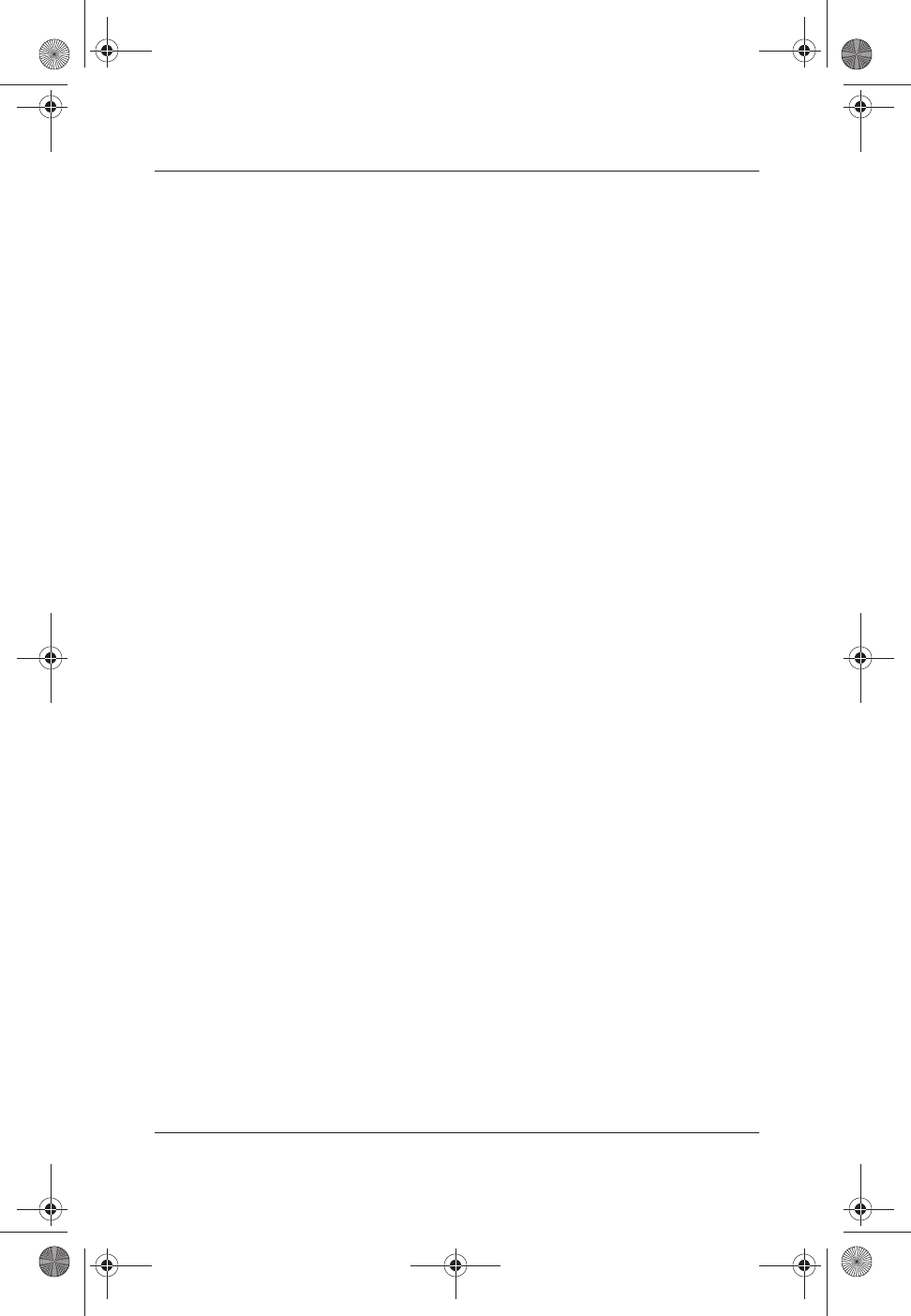
3–18 Getting Started
Hardware Components
307502-003.book Page 18 Tuesday, February 4, 2003 10:44 AM
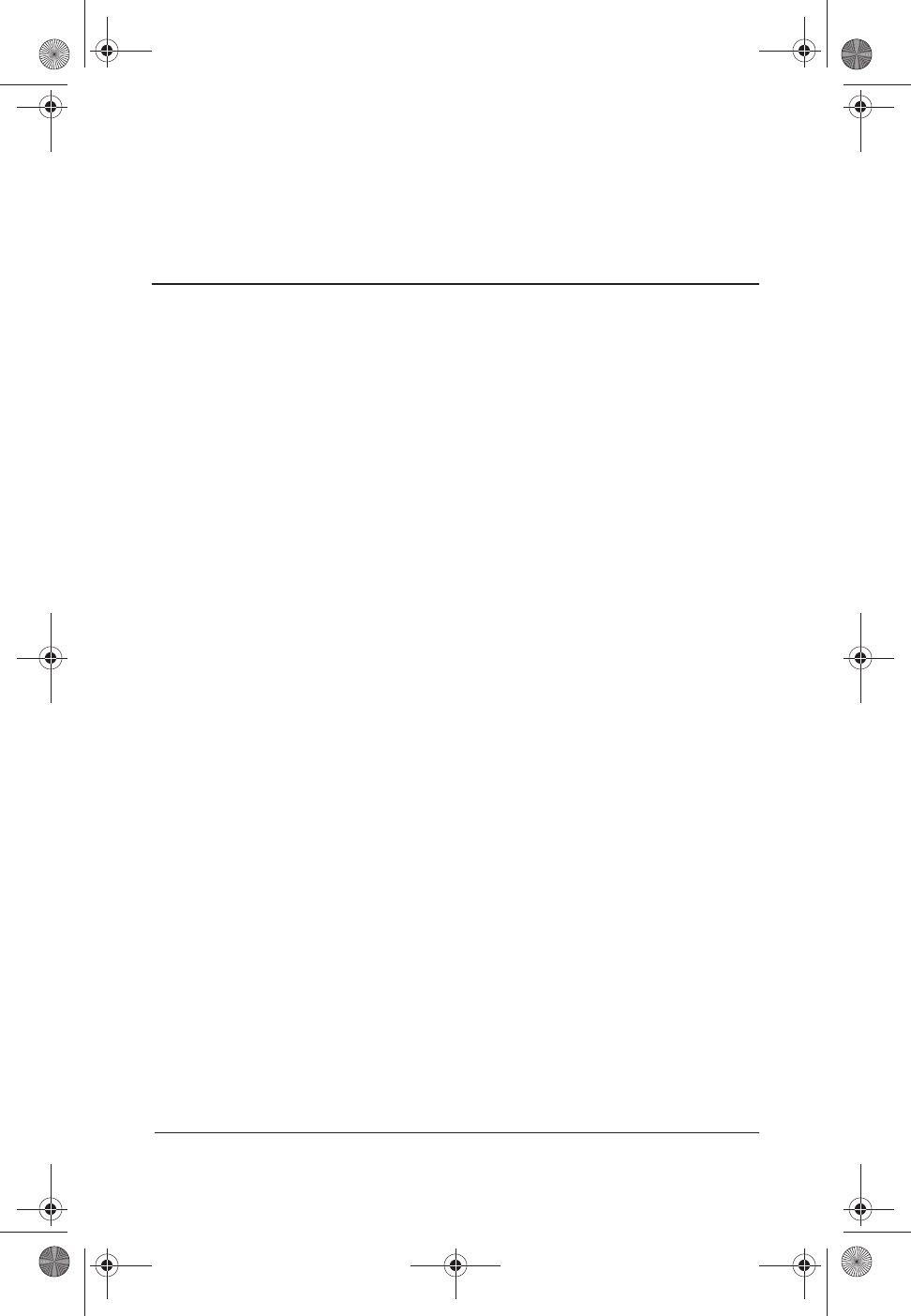
Getting Started Index–1
Index
1394 connector 3–9
A
AC adapter
AC power connector 3–7
connecting 1–2,1–4
light 3–4
location 1–4,3–17
AC power connector
connecting 1–2,1–4
location 3–7
Acrobat Reader 2–5,2–7
adapter 3–17
AC 3–17
country-specific modem
3–17
Japan-specific outlet 3–17
See also AC adapter
antivirus software 2–2
applications key 3–6
applications. See software
AT commands 3–15
audio-out jack 3–10
AutoPlay 2–5
B
battery bay
inserting battery pack into
1–2
location 3–12
stabilizer 3–12
battery light 3–3
battery pack
charging during setup 1–1,
1–5
inserting 1–2
location 3–12,3–17
locking latches 1–2,3–12
release latch 3–12
battery power 1–8
button(s)
PC Card eject 3–11
power 3–5
TouchPad 3–2
volume 3–10
See also key(s); latch(es);
switch, display
C
cable
AC adapter 1–2,1–4
DC 3–7
modem 3–8,3–16
network 3–8,3–16
security 3–9
caps lock light 3–4
card. See memory
compartment; PC Card
CD(s)
Compaq QuickRestore
3–15
displaying contents of 2–5
307502-003.book Page 1 Tuesday, February 4, 2003 10:44 AM
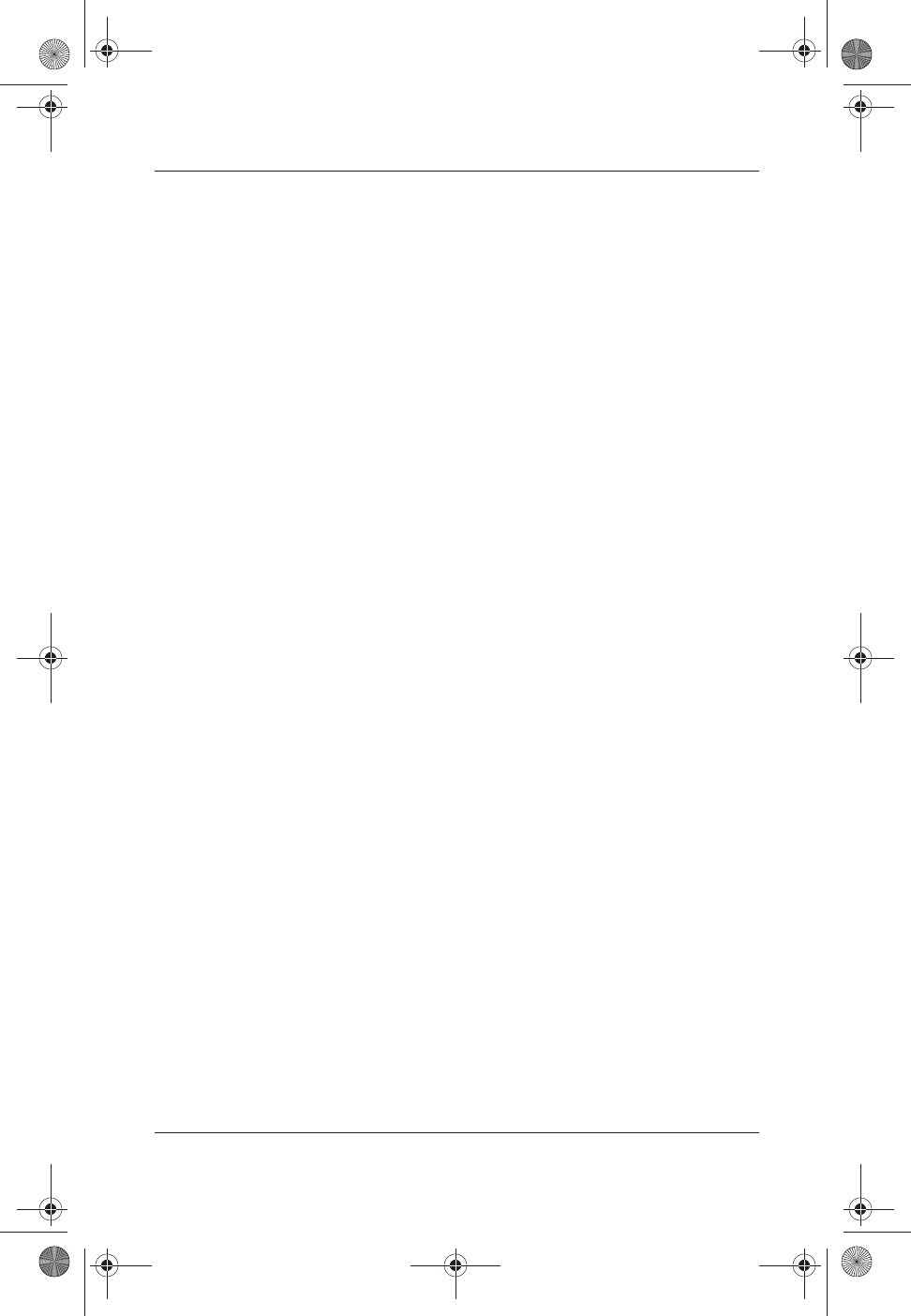
Index–2 Getting Started
Index
Documentation Library CD
2–6
inserting 2–4
Certificate of Authenticity
label 3–14
closing the notebook 3–5
commands, AT 3–15
Compaq customer support
2–6,2–8
Compaq utilities 2–3
See also software
compartment, memory 3–13
composite TV-out jack 3–8
Conexant Command Set (Ad-
vanced Users Only) guide
2–7
connector(s)
1394 3–9
AC power 3–7
external monitor 3–7
infrared port 3–7
parallel 3–7
USB 3–7
See also infrared port; jack
cord, power
connecting 1–2,1–4
location 3–16
surge protection 1–8
See also cable
country-specific modem
adapter 3–17
currency formats, setting 2–1
customer support 2–6,2–8
D
date, setting the 2–1
DC cable 1–7,3–7
display (internal)
opening 1–3
screen resolution settings
2–1
display release latch 3–1
display switch 3–5
Documentation Library CD
2–5,2–7
drive
bay, hard drive 3–9
light (IDE) 3–4
optical 3–11
drive designations 2–5
E
eject button, PC Card 3–11
electrical storm, safety issues
1–8
emergency shutdown
procedures 1–8
End User License Agreement
1–7
external monitor connector
3–7
F
fan, vents 3–3,3–8,3–13
Fn key 1–8,3–6
function keys (F1, F2, etc.)
3–6
307502-003.book Page 2 Tuesday, February 4, 2003 10:44 AM
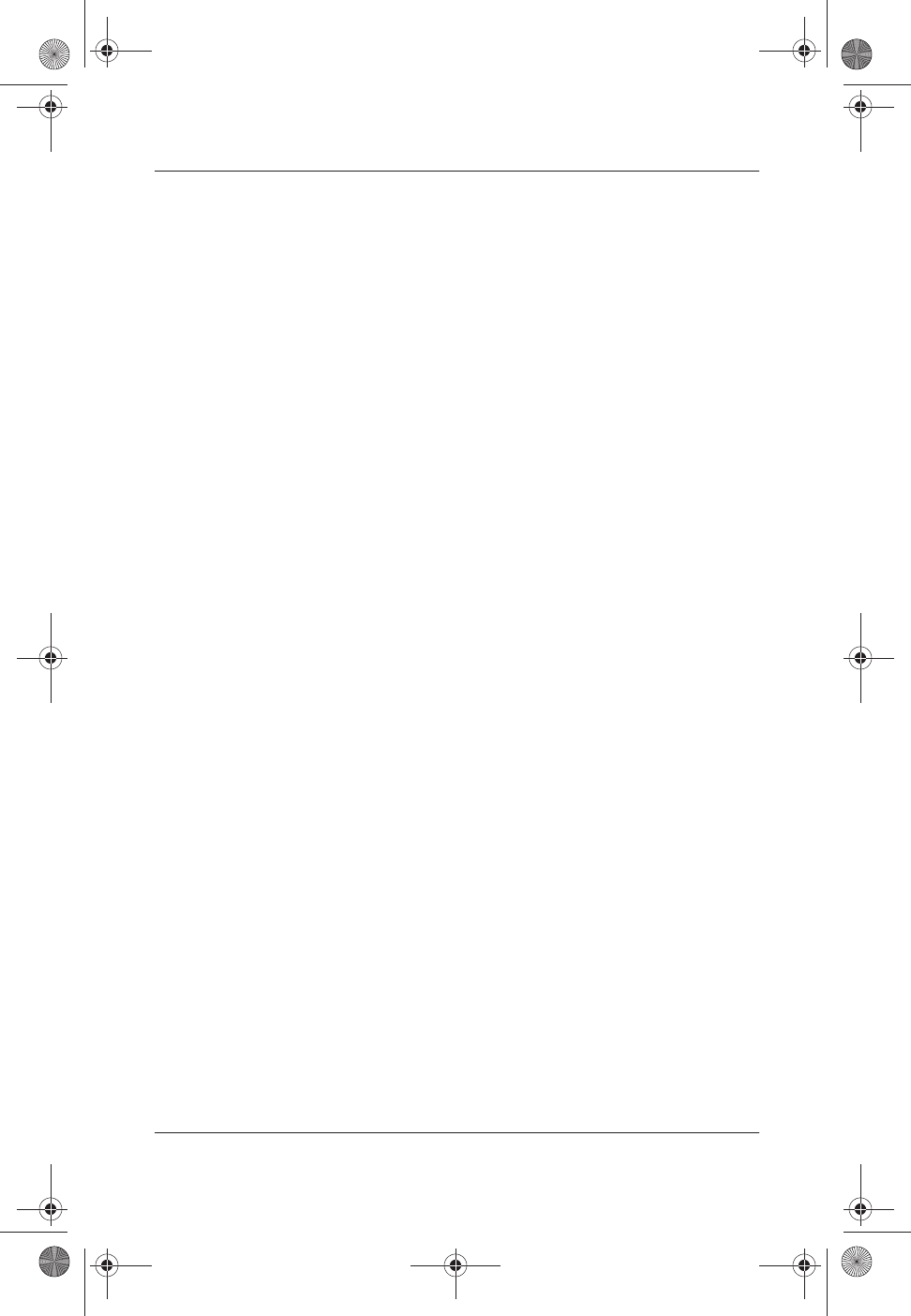
Index
Getting Started Index–3
H
hard drive
IDE drive light 3–4
location 3–9
retaining screws 3–12
Hardware Guide 2–6
help
contacting Compaq 2–8
Documentation Library CD
2–5
Hibernation 3–5
I
IDE (Integrated Drive
Electronics) light 3–4
identifying components
additional 3–16
display 3–1
left side 3–9
rear panel 3–7
right side 3–10
top 3–2
underside 3–12
infrared port 3–7
J
jack
audio-out 3–10
composite TV-out 3–10
microphone 3–10
RJ-11 3–8
RJ-45 3–8
See also connector(s);
infrared port
Japan-specific modem adapter
3–17
K
key(s)
applications 3–6
Fn 3–6
function (F1, F2, etc.) 3–6
hotkeys 3–6
keypad 3–6
Microsoft logo 3–6
See also button(s);
latch(es); switch, display
keyboard language 2–1
keypad 3–4
L
label
Microsoft Certificate of
Authenticity 3–14
modem approvals 3–14
product identification 3–14
system 3–14
wireless certification 3–14
LAN, internal wireless
documentation 2–2
wireless certification label
3–14
wireless LAN activity light
3–4
language
choosing during setup 1–7
selecting keyboard 2–1
latch(es)
battery pack locking 3–12
battery pack release 3–12
display release 3–1
See also button(s); switch,
display
307502-003.book Page 3 Tuesday, February 4, 2003 10:44 AM
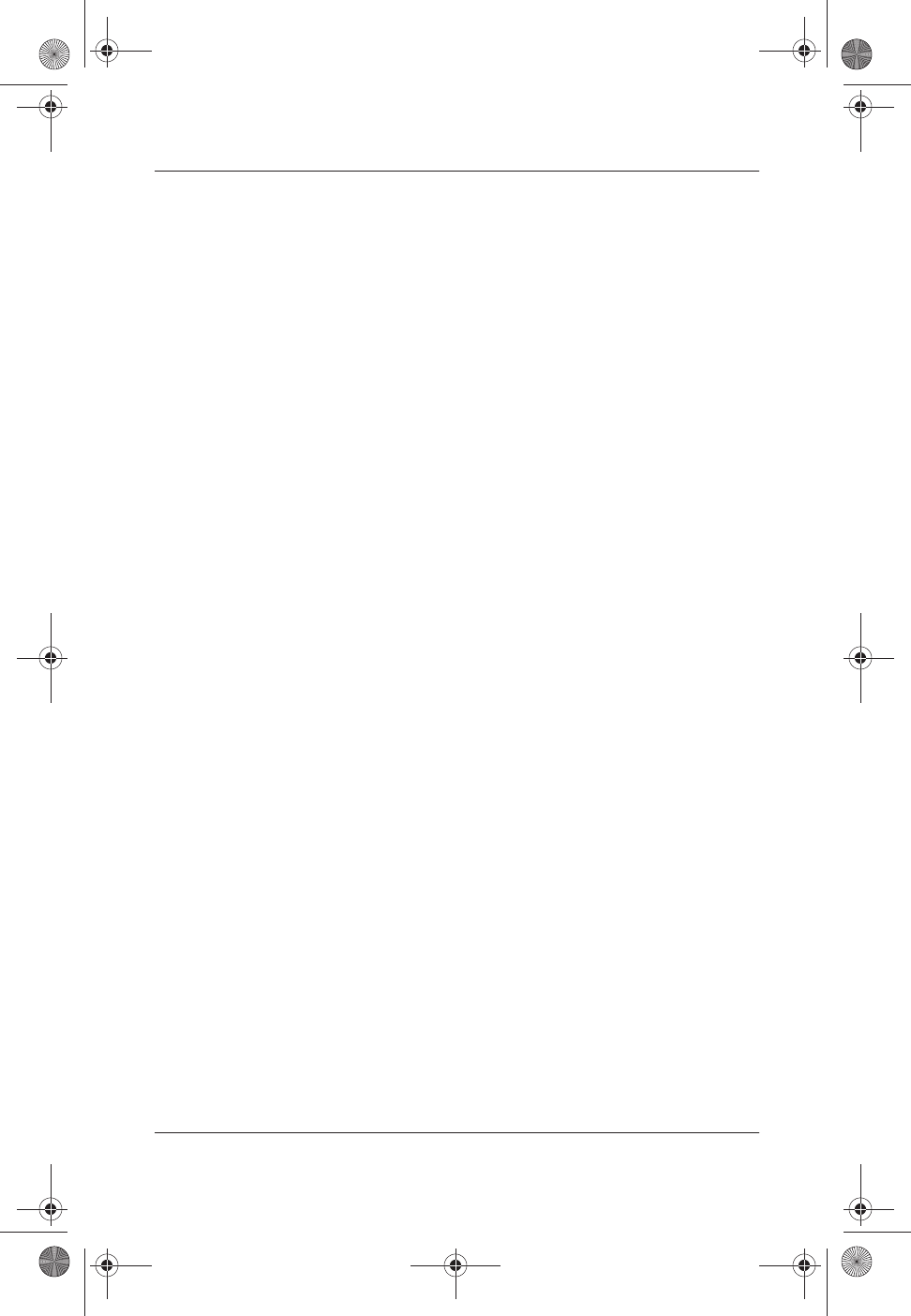
Index–4 Getting Started
Index
light
AC adapter 3–4
battery 3–3
caps lock 3–4
IDE drive 3–4
num lock 3–4
power/standby 3–3
wireless LAN activity 3–4
line-out jack 3–10
lock, security cable 3–9
locked system
contacting Compaq 2–8
emergency shutdown
procedures 1–8
Lucent/Agere Command Set
(Advanced Users Only)
guide 2–7
M
Maintenance, Shipping and
Travel guide 2–6
memory compartment 3–13
microphone jack 3–10
Microsoft Certificate of
Authenticity label 3–14
Microsoft logo keys 3–6
modem
approvals label 3–14
cable 3–16
Conexant Command Set
(Advanced Users Only)
guide 2–7
country-specific adapter
3–17
Lucent/Agere Command
Set (Advanced Users
Only) guide 2–7
Modem and Networking
guide 2–7
Modem Command Guide-
lines (Advanced Users
Only) guide 2–7
RJ-11 jack 3–8
virus protection 2–2
monitor, external, connector
3–7
N
network
cable 3–16
Modem and Networking
guide 3–15
RJ-45 jack 3–8
num lock light 3–4
number
Product Key 3–14
serial 3–14
O
opening the notebook 1–3
operating system
installing 1–7
Microsoft Certificate of
Authenticity label 3–14
Product Key number 3–14
restoring 3–15
optical drive
IDE drive light 3–4
inserting disc into 2–4
location 3–11
307502-003.book Page 4 Tuesday, February 4, 2003 10:44 AM
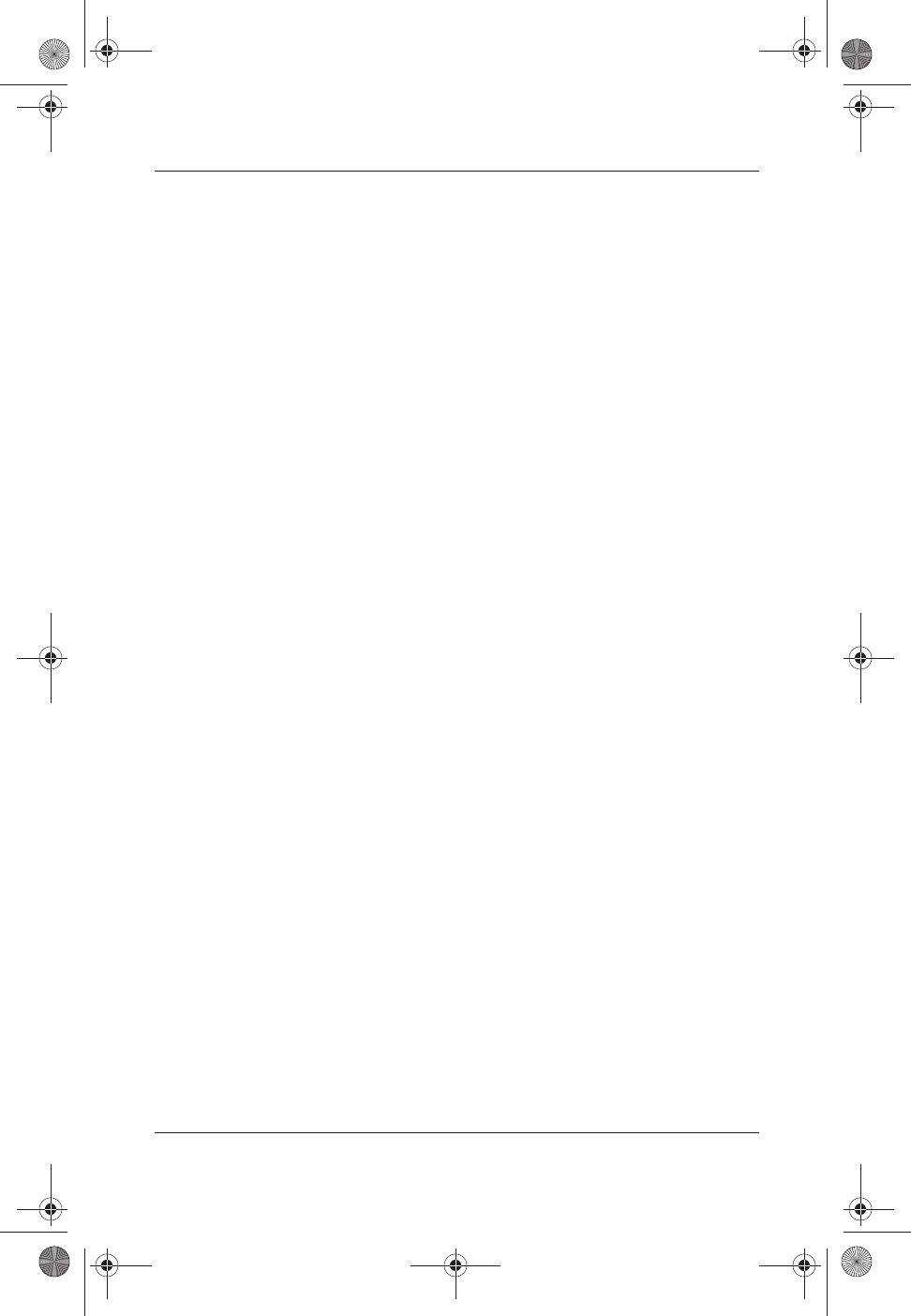
Index
Getting Started Index–5
P
parallel connector 3–7
passwords 2–9
PC Card
eject button 3–11
slot 3–11
phone numbers, Compaq 2–8
pointing device 3–2
port, infrared 3–7
power
AC power connector 3–7
button 3–5
connecting the notebook to
external 1–4
cord 3–16
power/standby light 3–3
running the notebook on
battery 1–5
shutting down the notebook
1–8
surge protection 1–8
turning on the notebook
1–6
power cord
connecting 1–2,1–4
surge protection 1–8
product identification label
3–14
Product Key number 3–14
R
regional settings 2–1
Regulatory and Safety Notices
guide 2–6
regulatory information
modem approvals label
3–14
Regulatory and Safety No-
tices 3–15
system label 3–14
wireless certification label
3–14
release latch
battery pack 3–12
display 3–1
reset (emergency shutdown
procedures) 1–8
resolution, screen 2–1
RJ-11 telephone jack
location 3–8
modem cable 3–16
RJ-45 network jack
location 3–8
network cable 3–16
S
Safety & Comfort Guide 2–6
screen resolution 2–1
security
cable slot 3–9
screws, hard drive 3–12
serial number 3–14
service, Compaq customer 2–8
shutdown procedures 1–8
slot(s)
memory 3–13
PC Card 3–11
security cable 3–9
software
Acrobat Reader 2–5
antivirus protection 2–2
307502-003.book Page 5 Tuesday, February 4, 2003 10:44 AM
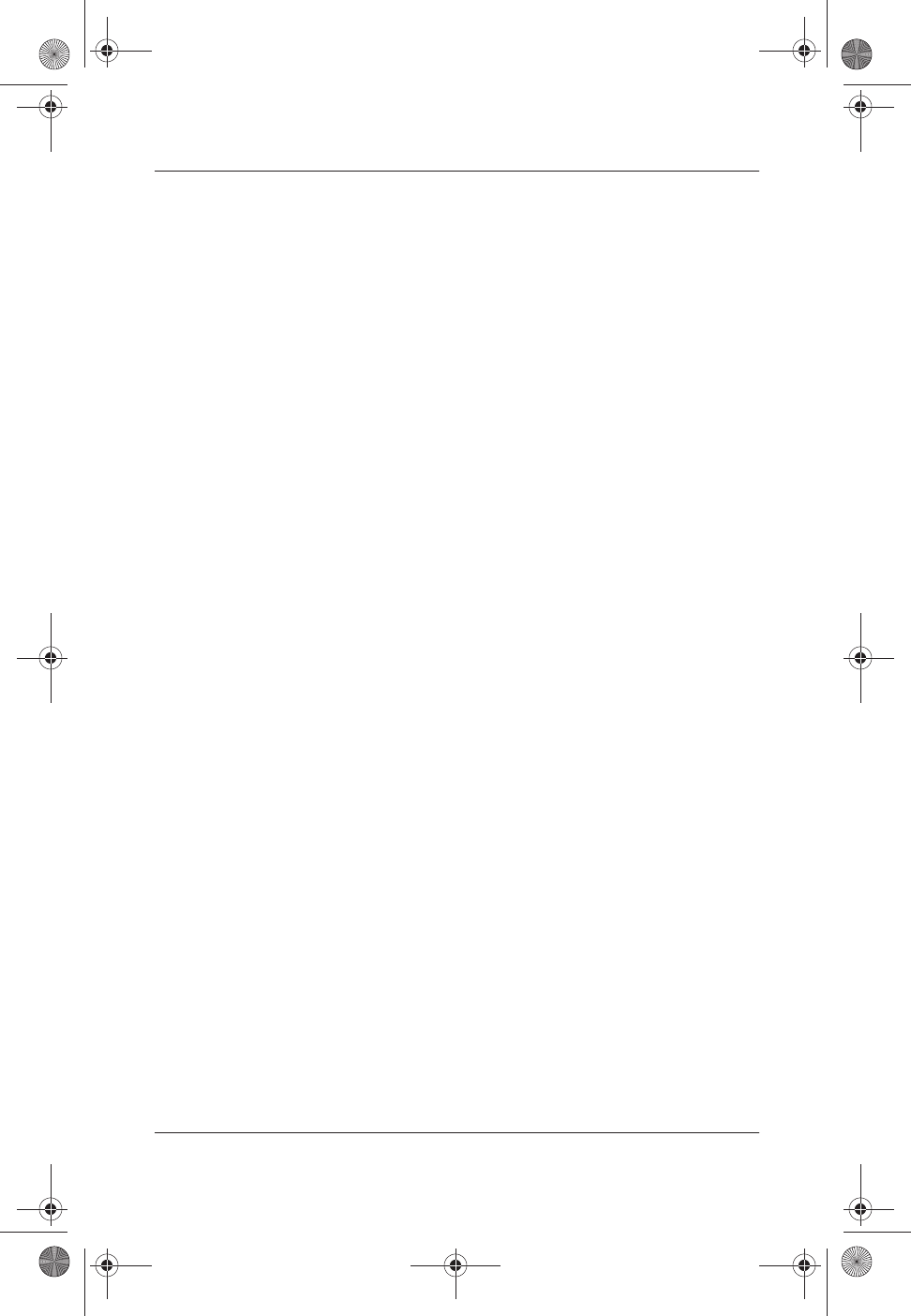
Index–6 Getting Started
Index
AutoPlay 2–5
installing optional 2–3
regional settings 2–1
restoring 3–15
setting up 1–7
Software Guide 2–6
speakers, internal stereo 3–2
Standby
power/standby light 3–3
procedures 3–5
support, Compaq customer
2–8
switch, display 3–5
system label 3–14
T
technical support
contacting Compaq 2–8
notebook documentation
2–6
telephone (RJ-11) jack
location 3–8
modem cable 3–16
telephone numbers, Compaq
2–8
1394 connector 3–9
time, setting 2–1
traveling with the notebook
modem approvals label
3–14
regional settings 2–1
serial number 3–14
wireless certification label
3–14
troubleshooting
contacting Compaq 2–8
Documentation Library CD
2–4
Troubleshooting guide 2–6
turning the notebook on/off
1–6,1–8
U
unresponsive system,
emergency shutdown steps
1–8
USB connectors 3–7
utilities, Compaq
displaying descriptions of
2–3
installing 2–3
restoring 3–15
V
vents, fan 3–3,3–8,3–13
viruses, computer 2–2
volume buttons 3–10
W
Web site, Compaq 2–8
Windows applications key 3–6
wireless LAN, internal
documentation 2–2
wireless certification label
3–14
wireless LAN activity light
3–4
Worldwide Telephone Num-
bers booklet 2–8
307502-003.book Page 6 Tuesday, February 4, 2003 10:44 AM

307502-003.book Page 7 Tuesday, February 4, 2003 10:44 AM

307502-003.book Page 8 Tuesday, February 4, 2003 10:44 AM

307502-003.book Page 9 Tuesday, February 4, 2003 10:44 AM

307502-003.book Page 10 Tuesday, February 4, 2003 10:44 AM